ST. ANDREW’S SCHOOL DELAWARE

Dear Families,
We are excited for you to consider St. Andrew’s School! A St. Andrew’s education is distinctive and immersive. We are a fully residential community rooted in our Episcopal identity, founding principles of inclusion and openness, and authentic intellectual engagement. As you search for a great school—among many great schools—you will not find another like St. Andrew’s.
Our school’s motto is “faith and learning,” and to be sure, the academic depth and challenge of our program is underpinned by a fundamental commitment to love and support one another. Here, you will find that both adults and your classmates will have faith in you and will challenge you. We believe that it is within this environment that you will learn the most about yourself, your character, and your capabilities. Students here share their many gifts with the community, and therefore our student culture is joyful: life at St. Andrew’s is characterized by authentic connection, service to others, curiosity, and inquiry.
In these pages, you will see this joyful culture in action, and discover much of what makes our community so special. I welcome you to visit our campus, where you can experience St. Andrew’s firsthand. We are looking forward to getting to know you.


 T. Roach, Jr. Head of School
Joy McGrath
Daniel
T. Roach, Jr. Head of School
Joy McGrath
Daniel

“The question I’m most frequently asked about St. Andrew’s is essentially some variation on: ‘Is this real?’ Is this remarkable school culture actually possible, and if so, how have we achieved it? There are many ways to answer this question, but most often, I end up talking about how there is something distinctive here about the depth and power of the collaboration between students and our faculty towards a shared vision: the power and potential of a school community that balances intellectual rigor with kindness, authenticity, and human connection.”

We know St. Andrew’s is different, truly different, than the average high school—but what is it, exactly, that makes a St. Andrew’s education unique?
EMILY PRESSMAN DEAN OF FACULTY DEVELOPMENT
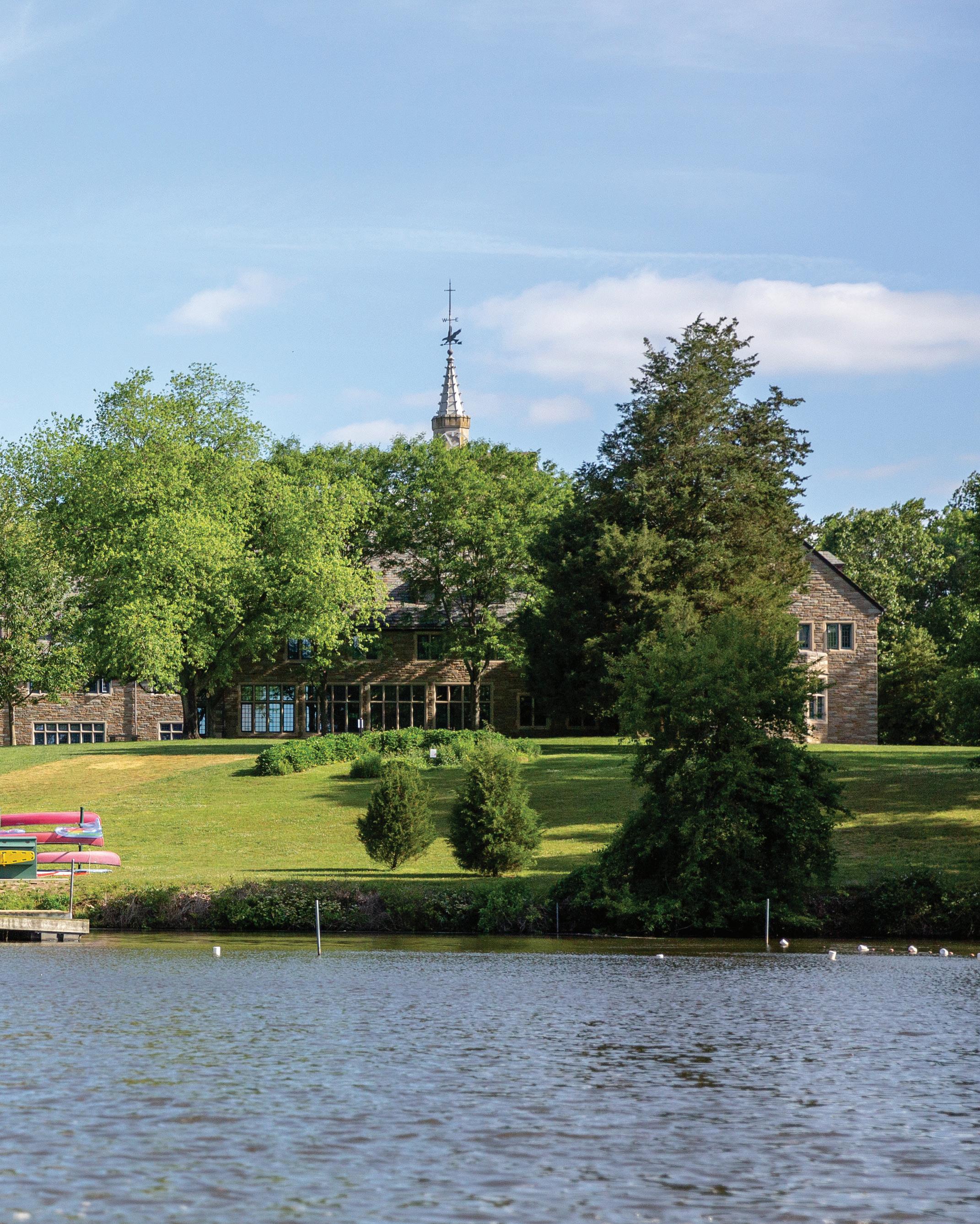
is
At St. Andrew’s, we believe in a few fundamental principles that set us apart.
100% BOARDING
At St. Andrew’s, I have come to understand the true meaning of community— and as a result, I’ve gained a better understanding of who I truly am.
 — Marvi Ali ’21 PENNSYLVANIA
— Marvi Ali ’21 PENNSYLVANIA
#1
We all live here.
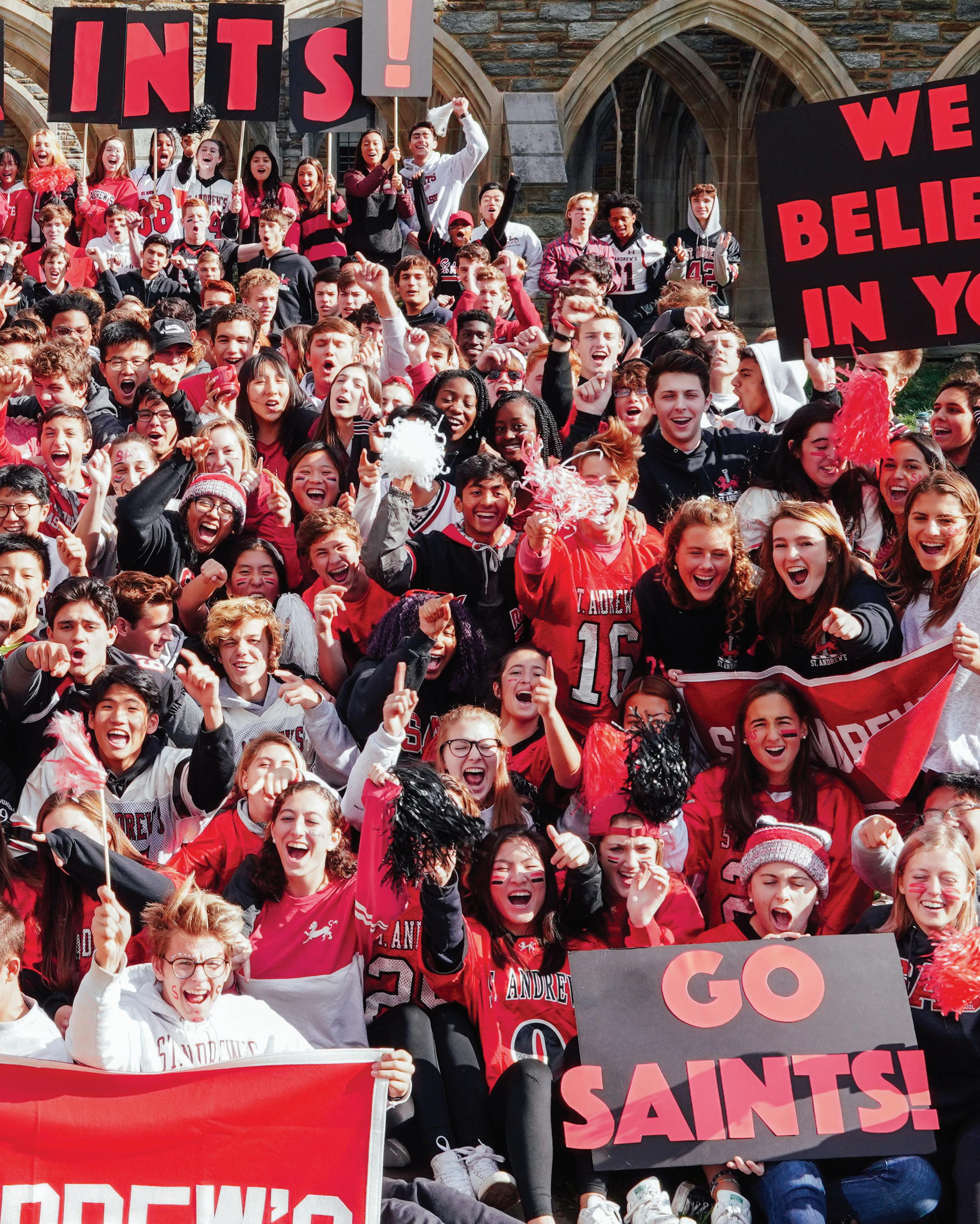
REVOLUTIONARY FINANCIAL AID

#2
The power of St. Andrew’s lies in its people and our commitment to each other. Since its founding in 1929, St. Andrew’s has offered need-based financial aid to any student who is admitted to the school, offering tuition grants that meet 100% of a family’s demonstrated need. This approach to financial aid was unprecedented at the time, and our 92 year history of socioeconomic diversity fuels our distinctive campus culture of today—a culture centered on inclusivity and authenticity. We seek to find students who will steward these values for future generations of St. Andreans.
This year, 37% of our current students receive need-based financial aid, with an average grant of approximately $48,000. There is no distinction between students who receive aid and students who pay full tuition. We are all St. Andreans, and what matters most is our character and the contributions we make to this community and the world around us.
7
We are accessible to all, regardless of means.
AUTHENTIC ACADEMICS
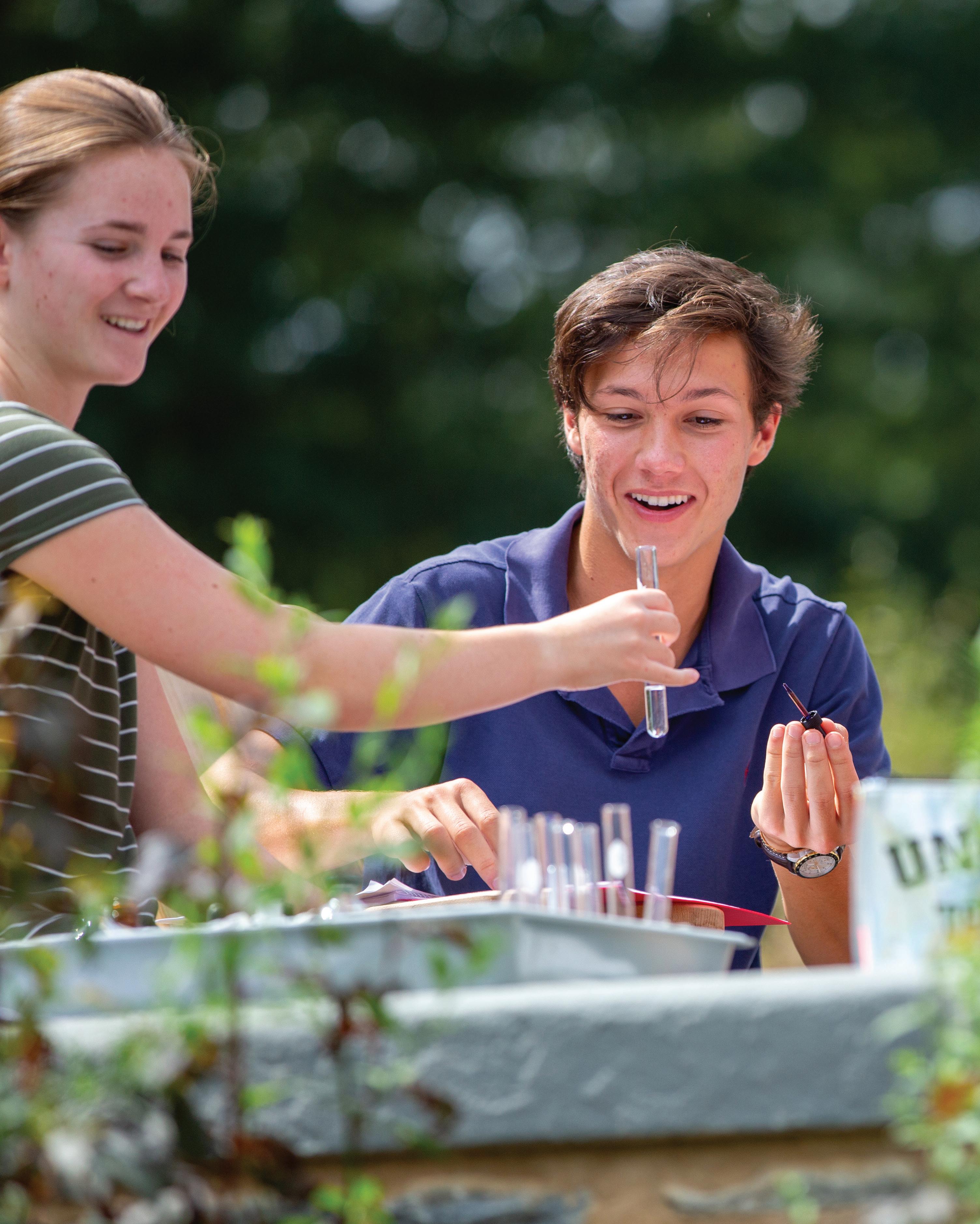
#3
At St. Andrew’s, you’ll learn how to learn, and discover the thrill of discovery. You will engage in the authentic work of all your academic disciplines: debate and discussion, research and experimentation; brainstorming and problem-solving.
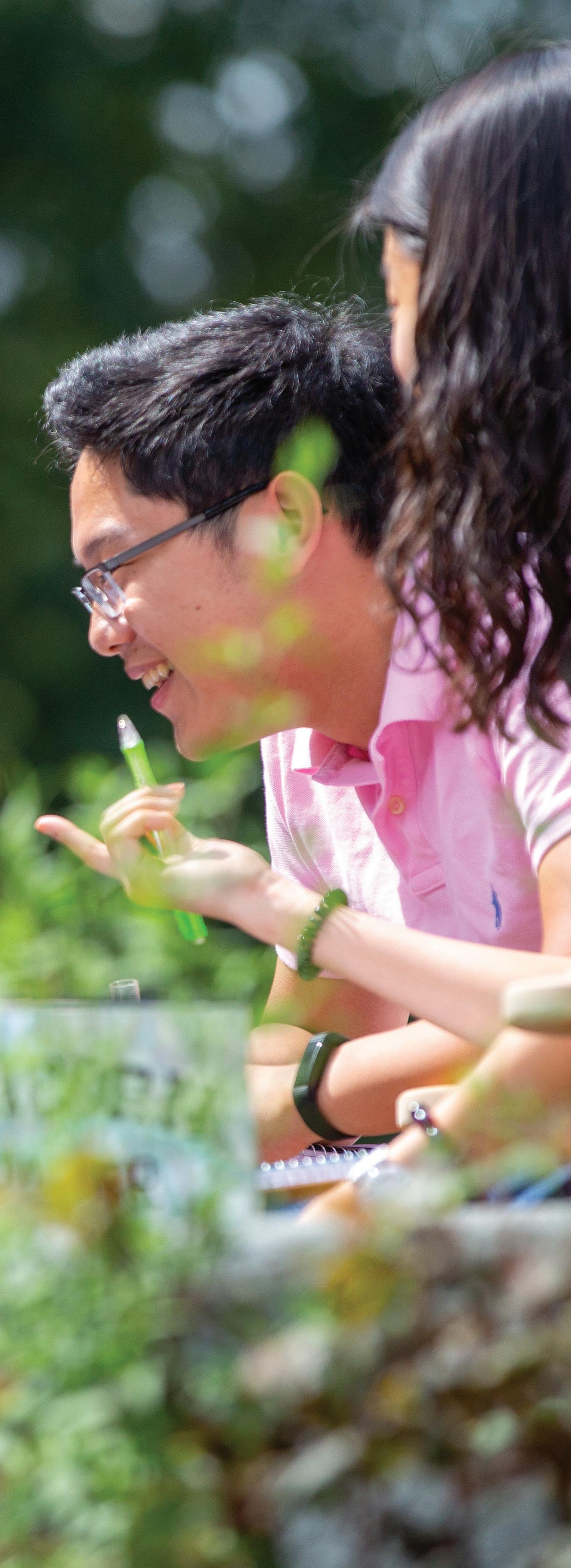
You will practice radical listening and open yourself to perspectives outside the scope of your own experience.
You will build habits of diligence, resilience, and independence.
You will develop a passion for intellectual pursuits of your choosing.
You will live with integrity, in moments small and large, in all you say and do.
You will find your voice, and the confidence to use it.
9
We believe in the joy of learning.
PHONE-FREE COMMUNITY

#4
What do you notice about all the photos in this book?
No cell phones! That’s not Photoshop. When you come to St. Andrew’s, you’ll discover it’s the exception and not the rule to see someone on their phone. The “phone rule” (as students call it) is this: students leave their phones in their rooms at all times, unless they are going off campus. The goal of the phone policy is to cultivate and protect our school culture and community by prioritizing face-to-face conversation and relationship-building.
Before coming to St. Andrew’s, there was always a distance between me and other people, but because of the culture here (and annoying as things like the cell phone policy may be), I was able to get rid of that barrier and form friendships that have bettered me as a person.
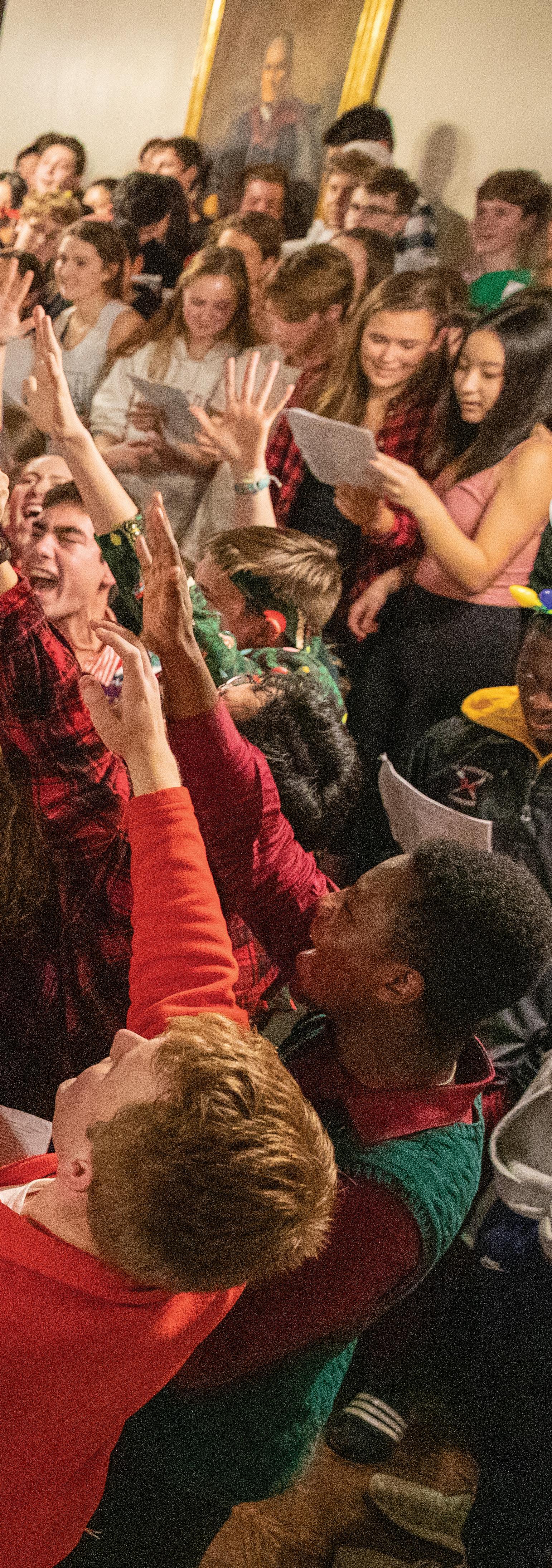 Gianna Rosario ’21 ILLINOIS
Gianna Rosario ’21 ILLINOIS
11
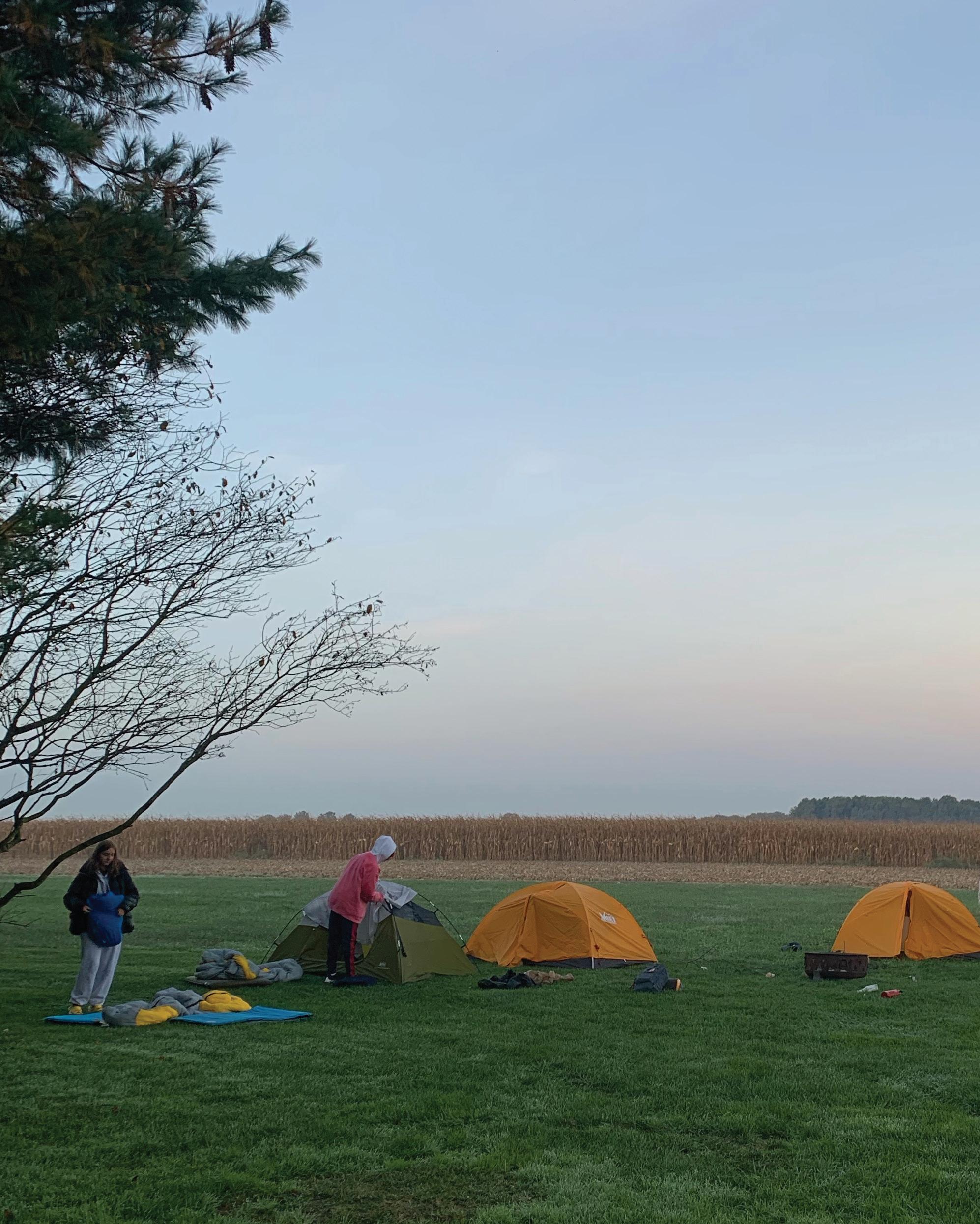
#5
2,200 ACRES
A huge part of your St. Andrew’s experience will be the time you spend outdoors. Whether you’re hanging out on the Front Lawn—the epicenter of campus life—or exploring our 2,200 acres of woods, trails, farmland, and pond, you’ll find that much of your class time and downtime at St. Andrew’s will be spent al fresco.
You’ll also have all kinds of opportunities to get involved in environmental work and activism, both on and off campus.
Enjoying time outdoors, whether in the presence of friends or just by myself, is something that I learned to cherish while at St. Andrew’s. Slowing down while appreciating the outdoors has become an important outlet for me.
 Pati Lunsford ’22 VIRGINIA
Pati Lunsford ’22 VIRGINIA
13
We get outside. All day long.
CULTURE OF KINDNESS

#6
We give each other grace.
The St. Andrew’s experience is an education premised on proximity, congregation, and above all, kindness.
You will experience our culture of kindness in action each day, starting from your first day on campus: your Big Sibling (a senior chosen to mentor you throughout your first year at SAS) will show you around, and you’ll be welcomed with open arms into our family at our annual Square Dance that evening.
By the time you graduate, there’s one thing you’ll know for sure: when you become a Saint, you become a lifelong member of the St. Andrew’s family.
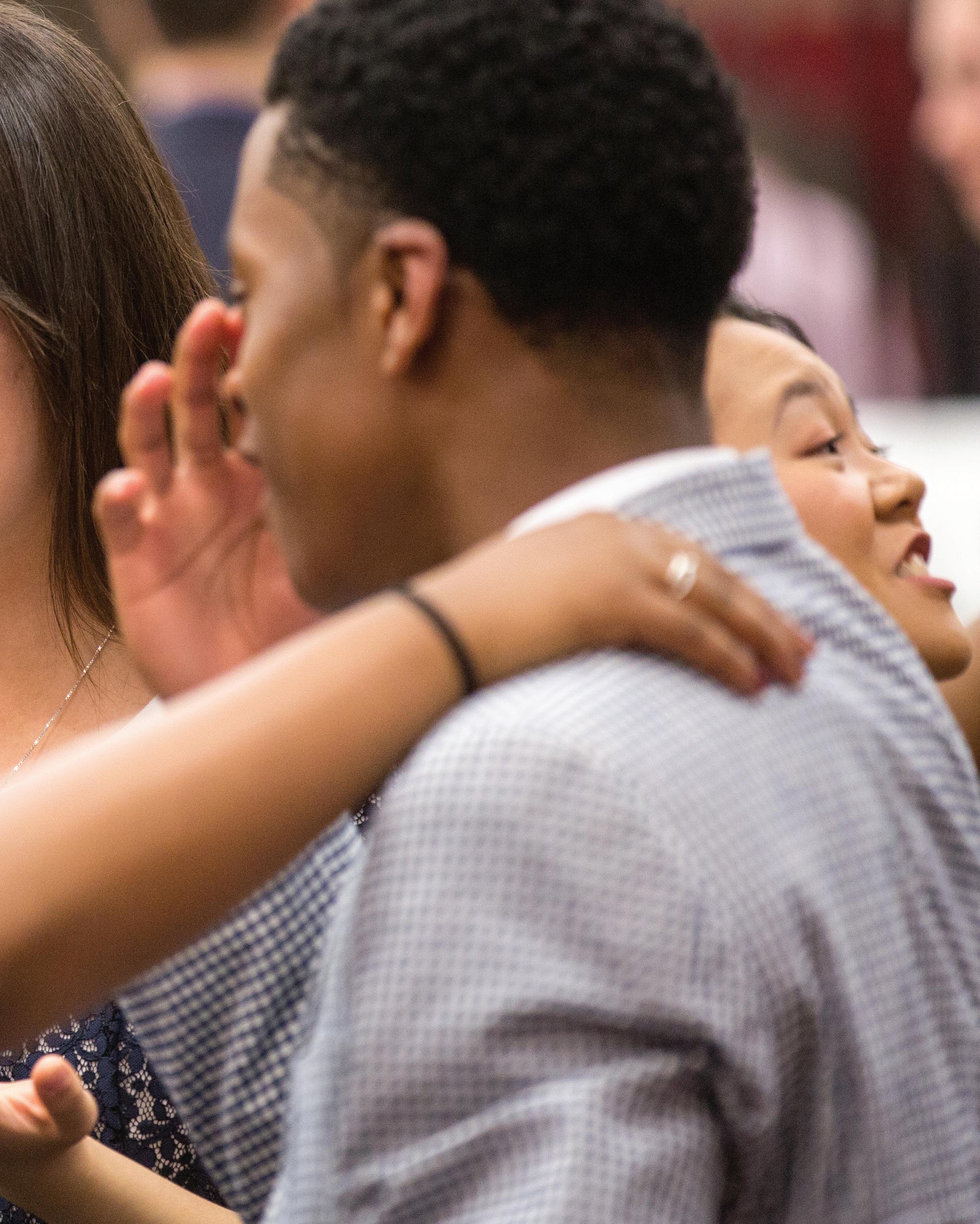

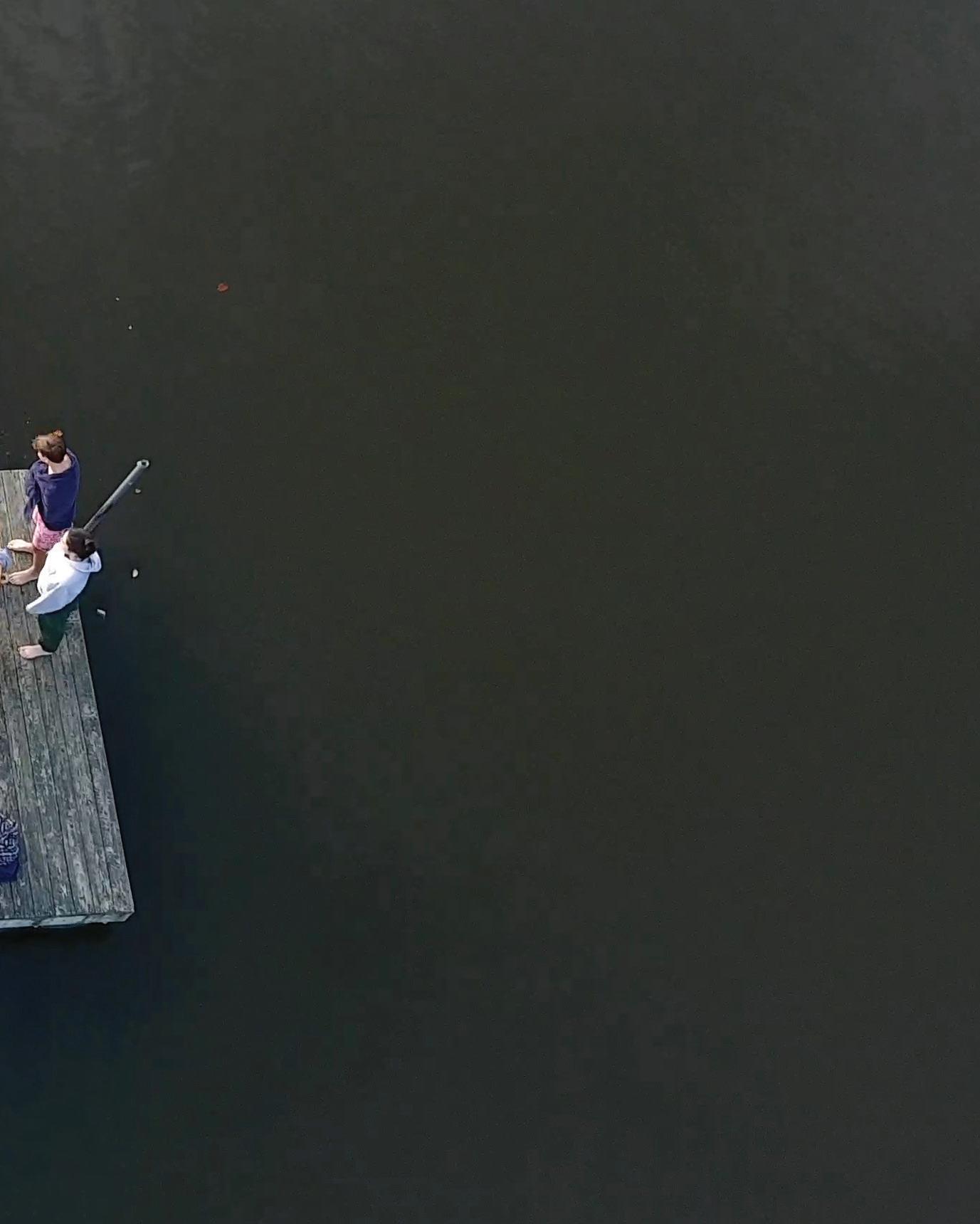
Are you ready to jump in to St. Andrew’s?
It all begins in the classroom.
We believe in academic and human excellence— and that these two principles are not mutually exclusive.
18
ACADEMICS
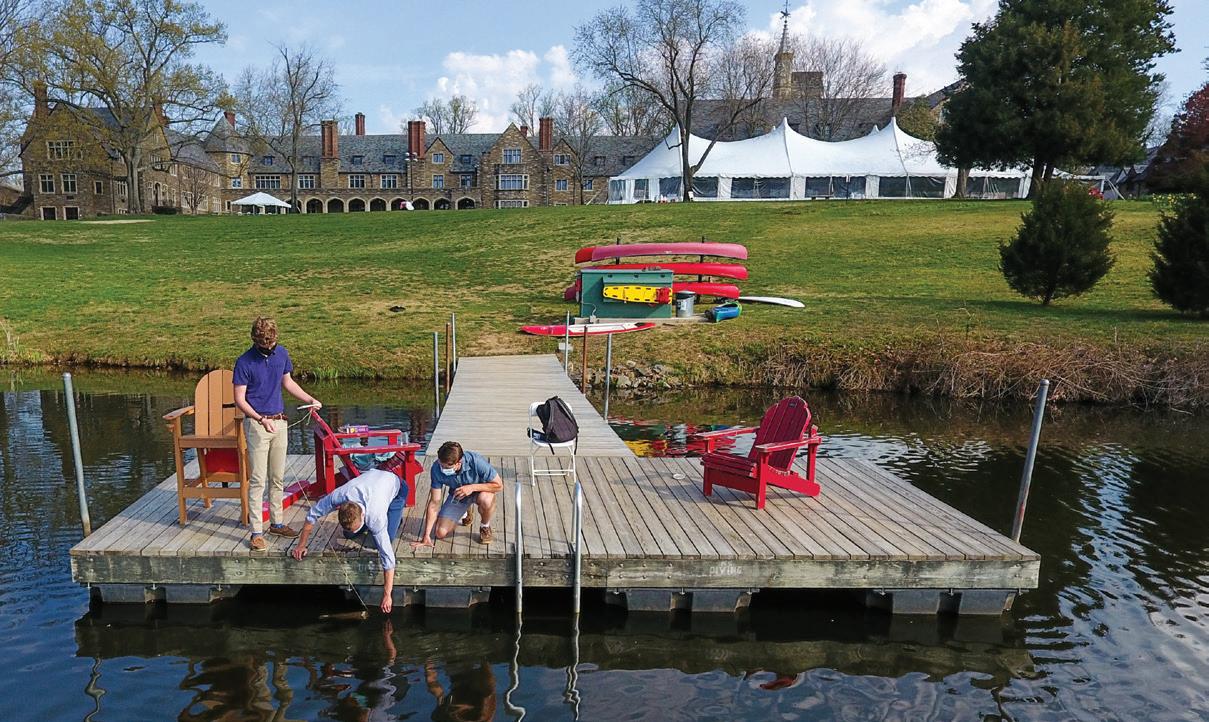
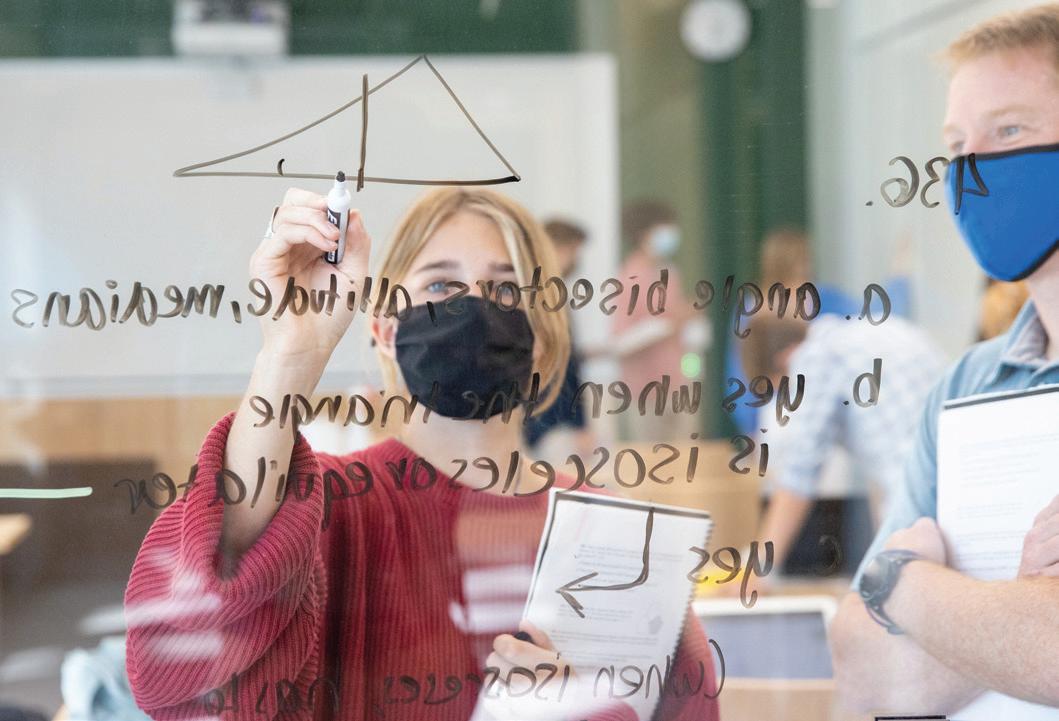
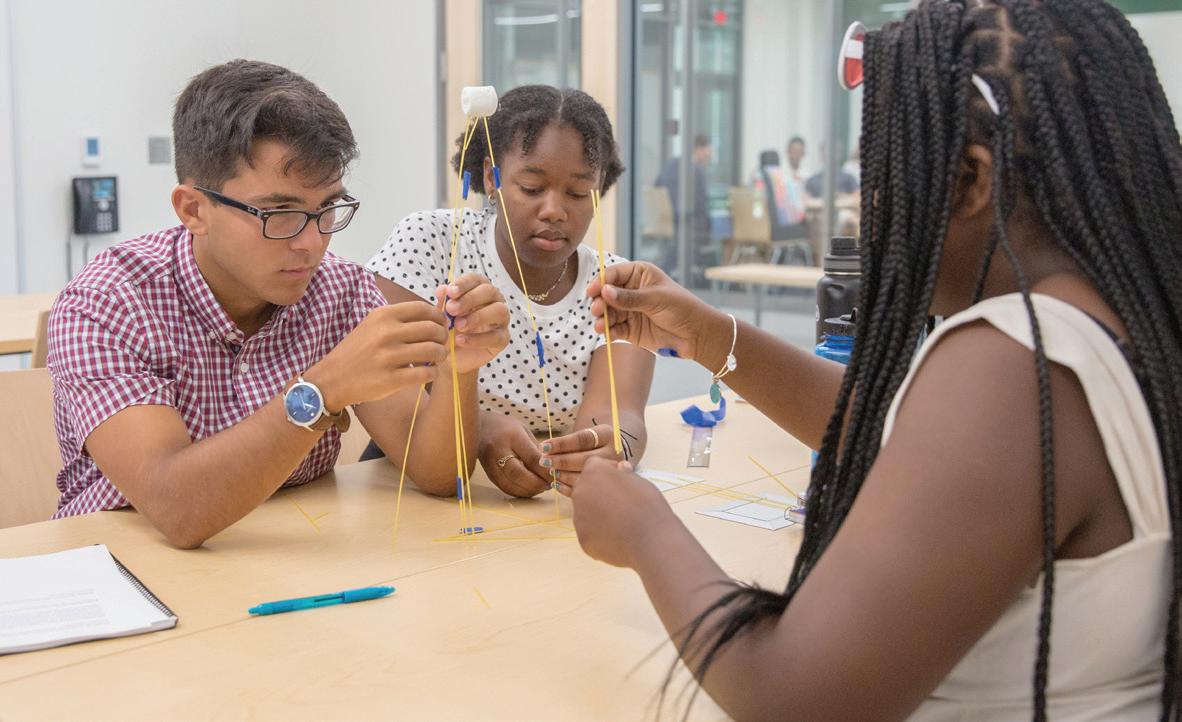



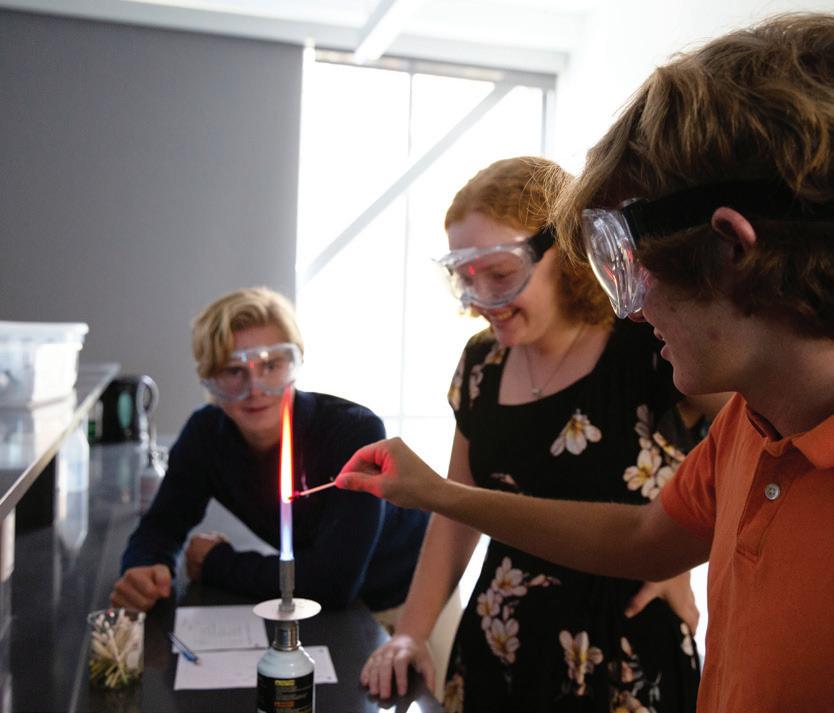
We believe in doing the authentic work of scholars.
We believe...
that a high school education should be centered on the joy of asking questions—the joy of exploration, research, and collaboration. (rather than studying to pass tests)
in discussing issues and challenges with each other across lab benches and seminar tables. (rather than listening to lectures in rows of desks)
that you, the student, are an equal partner in your own learning and in building the culture of our classrooms. (you are not here to be a passive receptacle of information from a textbook or teacher)
20
My St. Andrew’s education has pushed me to think beyond the scope of my life: to have empathy, to remain openminded, and, hopefully, to one day make meaningful contributions to society.
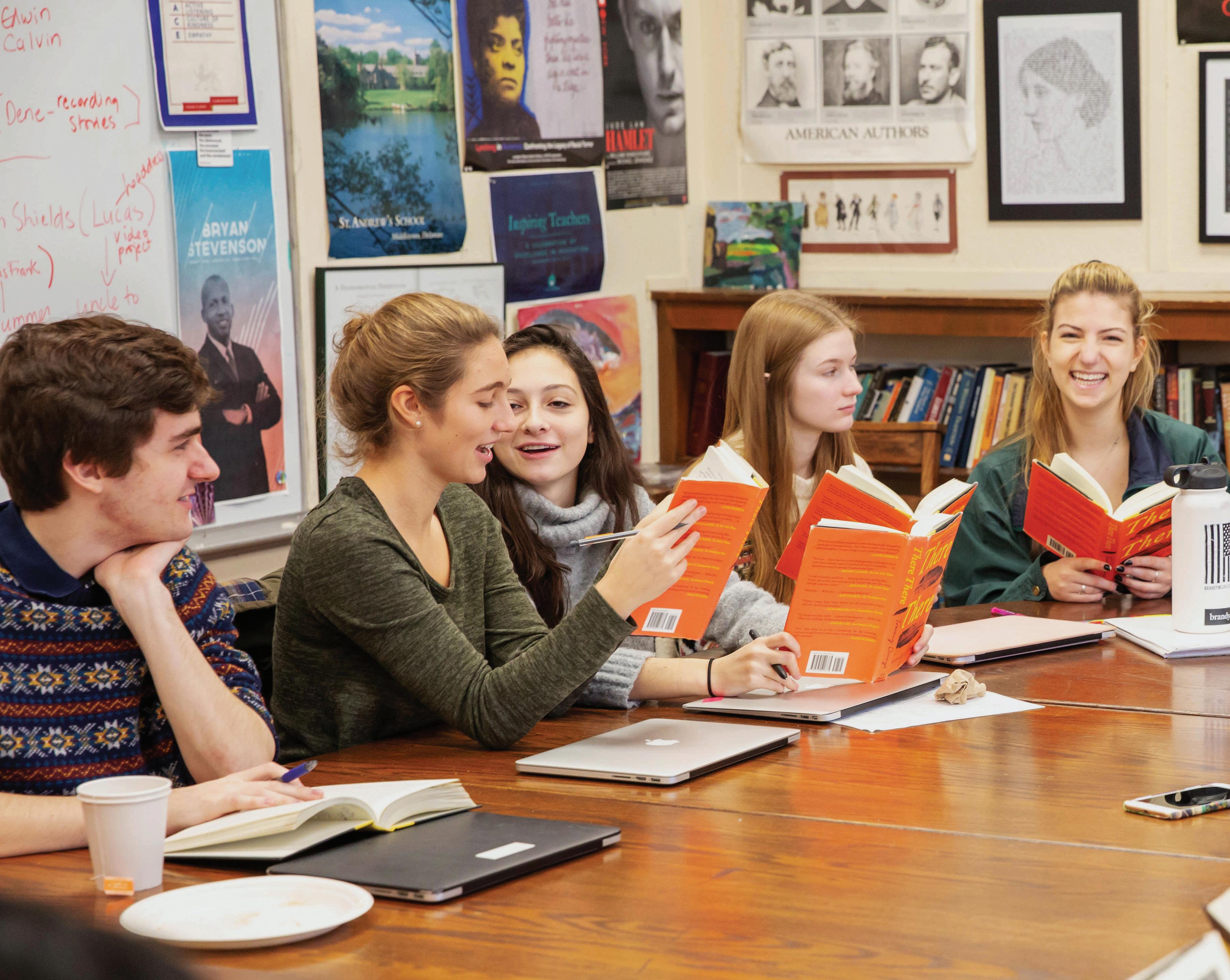

Bhatia ’22 NEW JERSEY
Sonal
Your Educational Journey at St. Andrew’s
DISCUSSION-BASED CLASSES & ASSESSMENTS
SEMINAR TABLES
Each of our humanities classrooms is centered around a seminar table. Our school mission engenders a diversity of perspectives in all areas of campus life, and this diversity becomes an invaluable tool at our seminar tables and in our discussion-centered classes. At the table, students learn to listen carefully, think nimbly and creatively, see undiscovered connections, speak with respect for others, and learn to receive constructive criticism.

EXHIBITIONS
Across disciplines and Forms, students orally defend their analytical papers in collaboration with student and faculty readers. Exhibitions take students’ thinking to another level— allowing them to develop, complicate, and refine their ideas, and to practice and engage in sophisticated scholarly discourse. They learn how to ask and respond to challenging questions in a way that opens up conversation and leads to intellectual discovery.
One teaching method that has helped me learn most effectively is the kind that I first experienced in my math classes with Mr. Tower. He would assign math problems for homework, and in class we would all discuss our methods for solving these problems. Then, Mr. Tower would guide us through one or two of them before starting our new lesson. In teaching our new lesson, he would guide us through a new concept with multiple examples, and then give us some practice problems to work on in groups. We would reconvene and discuss the practice problems. This type of learning worked well for me because it was very straightforward and predictable. Mr. Tower would teach us the concept instead of making us figure it out, but we still had the chance to collaborate with each other to complicate and deepen our understanding of said concept.
22
Cierra Martinez ’20 NEW JERSEY
TEACHER-GUIDED INSTRUCTION, STUDENT-LED INQUIRY SCAFFOLDED CURRICULUMS
All of our classes, but particularly our introductory classes, are designed to provide a supported pathway for students as they move through our academic program. Teachers in each discipline plan backwards, designing assessments, projects, and classes carefully and systematically for each stage of our students’ academic development. This scaffolded approach allows teachers to provide the appropriate balance between traditional instruction and student-centered work. Students learn and practice foundational skills and concepts as they build toward exhibitions of mastery throughout the curriculum.
INQUIRY IN ACTION
ADVANCED TOPICS TUTORIAL IN MATH
Students develop proofs for all of the theorems in Book I of Euclid’s Elements without actually reading the Elements.
CLASSICS COLLOQUIUM
Greek and Latin students conduct independent research and scholarship on works of ancient epic poetry (such as Vergil’s Aeneid or Homer’s Odyssey), working remotely with
CURIOSITY QUEST
We offer more than 130 courses each year in 10 disciplines.
In Biology, III Form students spend the year journaling observations, questions, and ideas about how to investigate the biological world around them. At the end of the course, students participate

QUICK FACT
DEEP ENGAGEMENT & UNDERSTANDING
ADVANCED STUDY COURSES
With the encouragement of colleges and universities, St. Andrew’s moved away from teaching AP courses more than 15 years ago in order to design Advanced Study (AS) courses, which go far beyond preparation for standardized tests. Our AS courses ask students to engage in the authentic work of each discipline, explore complex issues and questions, and demonstrate their deep understanding of the material.

SENIOR TUTORIALS
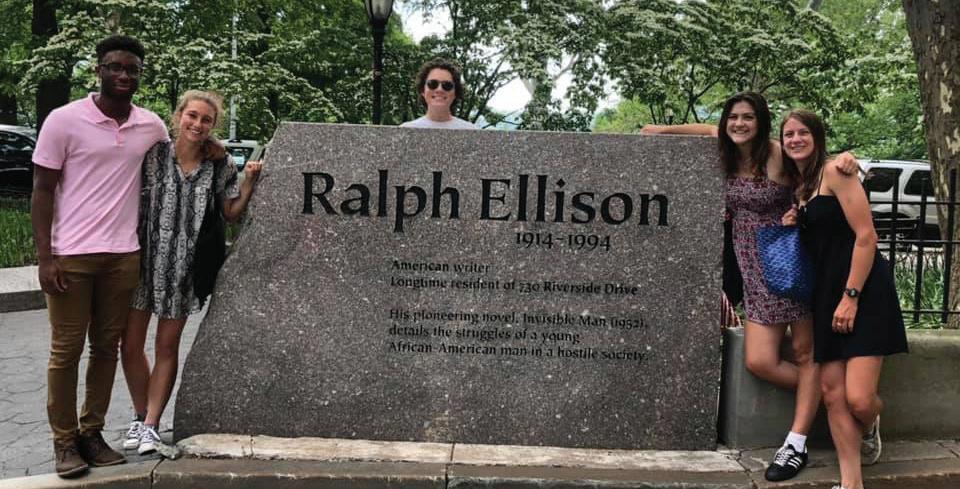
In the spring of their senior year, students with a demonstrated commitment to independent work have the opportunity to take a tutorial. Typically comprised of three to five students and one faculty member, tutorials are offered in all disciplines. Students are required to write weekly essays which they read aloud, critique, and debate in weekly meetings, in the spirit of the Oxford tutorial system.

A SAMPLING OF OUR TUTORIALS
Race & Racism in the United States: An Economic Perspective • The Signal in the Noise: Alternative Music as Commentary on Social Issues • Contemporary American Film as Literature • A Sensory Exploration of Ralph Ellison’s Invisible Man • Theory and Reality: An Introduction to the Philosophy of Science • Global Health • Native American and Hawaiian Mythology
24
THE TUTORIAL PROGRAM www.standrews-de.org/tutorials
LEARN MORE ABOUT
ELECTIVES
Our foundational liberal arts curriculum allows students the latitude to explore diverse interests and take deep dives in subjects through a wide array of semester-long electives.
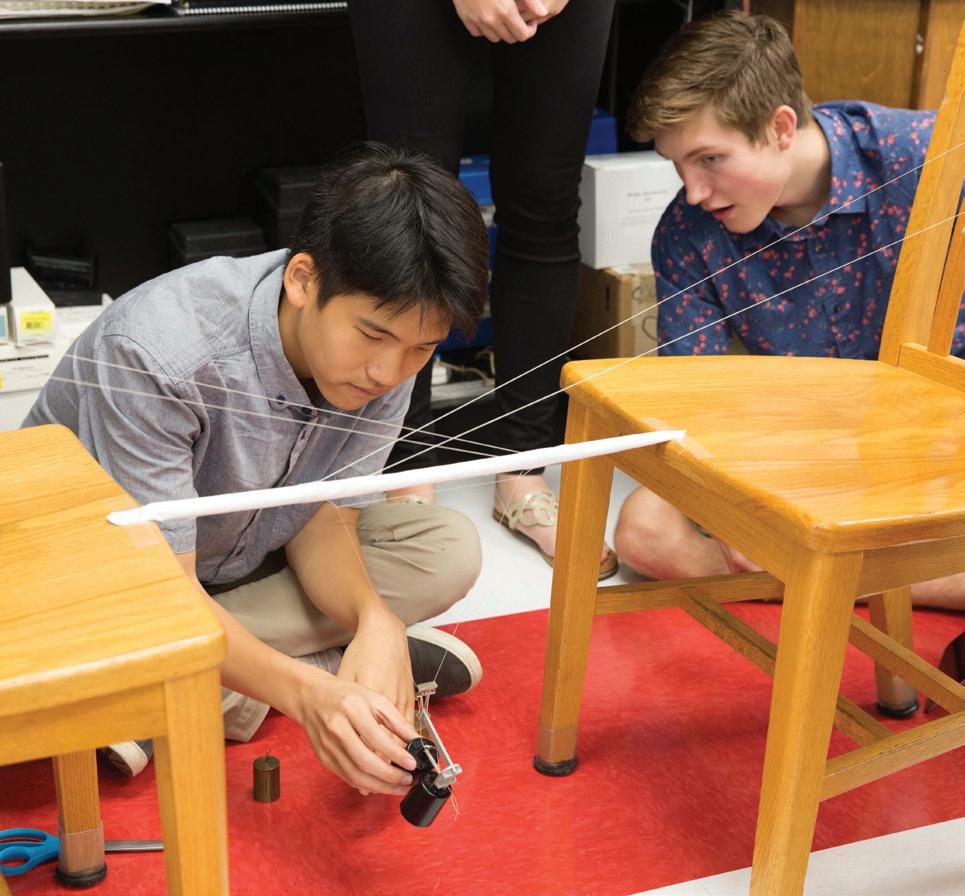
CONNECTION WITH REAL-WORLD LEADERS & CHANGEMAKERS
We bring innovative leaders, thinkers, writers, scientists, activists, artists, and all-around amazing human beings on campus to connect with and inspire students—and we bring students out into the world for the same incredible encounters and experiences. The change-makers our students meet on and off campus help them to question the world, shift their perspectives, and expand their respect and empathy for others.
RECENT SPEAKERS
Elizabeth Acevedo
National Book Award-winning poet and author of The Poet X
Nick Berry
Data scientist and author of “Datagenetics”
RECENT OFFERINGS FOR ELECTIVES
American Social Reform Movements
David Blight
Historian and Pulitzer Prize-winning author of Frederick Douglass: Prophet of Freedom
• Anatomy & Physiology
App Development in Swift
Applied Ethics
Asian Philosophy & Religious Traditions
• Astronomy • Bioengineering
Creative Writing
Intro to Data Science
• Democracy & Empire—Athens in the 5th Century BC
Engineering
Greek • Histories of Hate: American Racism & German Anti-Semitism • History of Economic Thought
Ross Douthat
Opinion columnist for The New York Times
Yaa Gyasi
PEN/Hemingway Award-winning author of Homegoing
Po-Shen Loh
Head coach of the US International Math Olympiad team and founder of expii.com, a math & science learning website
Diane Nash
Civil Rights Movement leader
MicroController
Latin American History
Programming & Robotics • The Modern
Middle East • Nuclear Ethics • Object
Oriented Programming in Java • Religion & Violence • Statistics
Bryan Stevenson
Social justice activist and founder & director of the Equal Justice Initiative
Jesmyn Ward
National Book Award-winning author of Sing, Unburied, Sing
Colson Whitehead
Two-time Pulitzer Prize-winning author of The Underground Railroad & The Nickel Boys

25
•
•
•
•
•
•
•
•
•
QUICK FACT
Our STEM Summer Opportunities program connects students with summertime experiential learning & growth opportunities in STEM fields— research programs, internships, and lab placements.
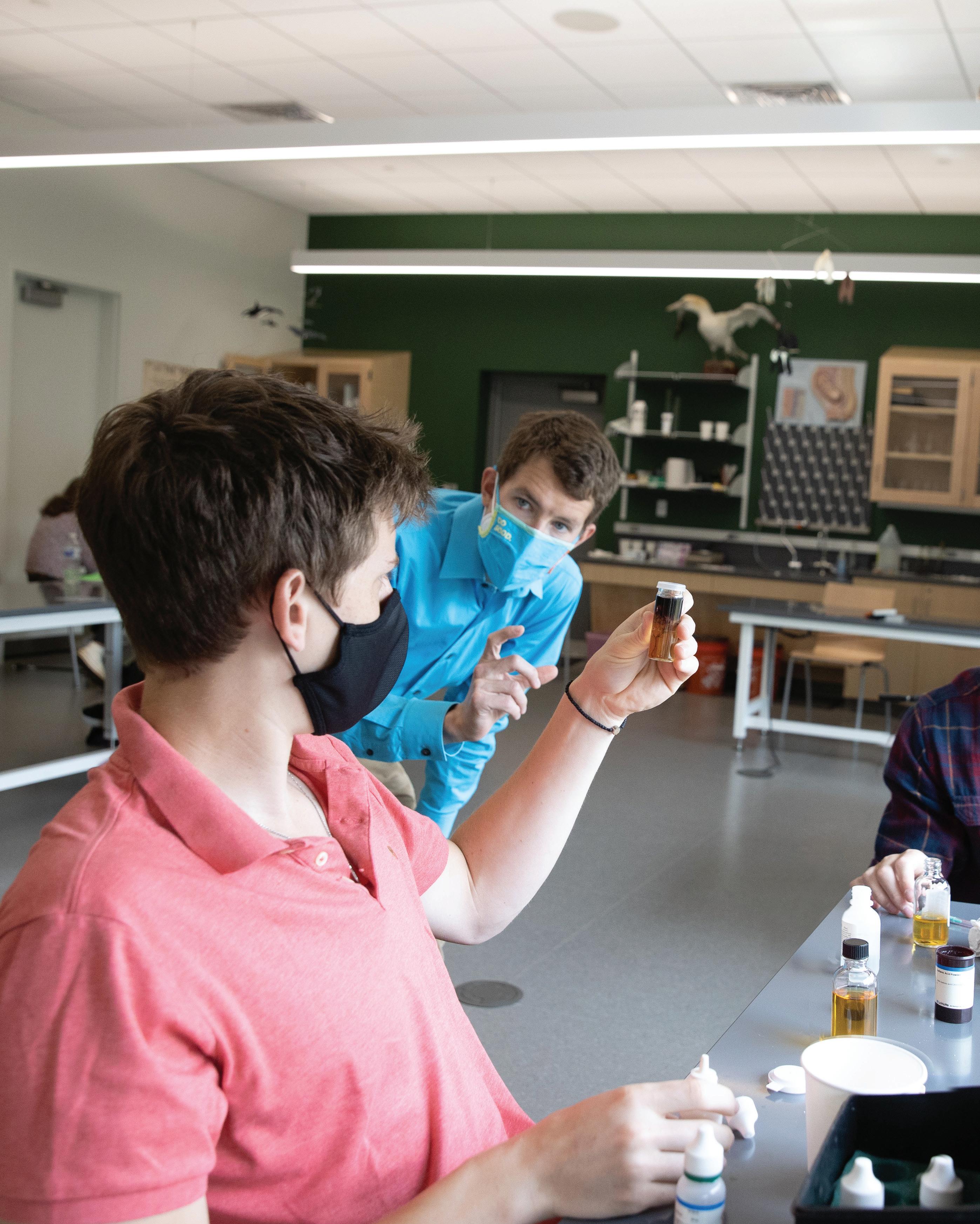
A FEW HIGHLIGHTS OF OUR STEM PROGRAM
In fall 2019, Amos Hall, our STEM facility, reopened after a year-long, $13 million renovation. The renovation doubled lab space in the building and created dedicated space for robotics and computer science. The entire building is now LEED-certified.
STEM ELECTIVES
» Intro to Computer Science
» Object Oriented Programming in Java
» Data Structures & Design
» Microcontroller Programming & Robotics
» App Development in Swift
» Statistics
» Engineering
» Bioengineering
» Anatomy & Physiology
» Astronomy
» Nuclear Ethics
STEM EXTRACURRICULARS
» Ad Astra (astronomy club)
» Coding Club
» Environmental Stewards
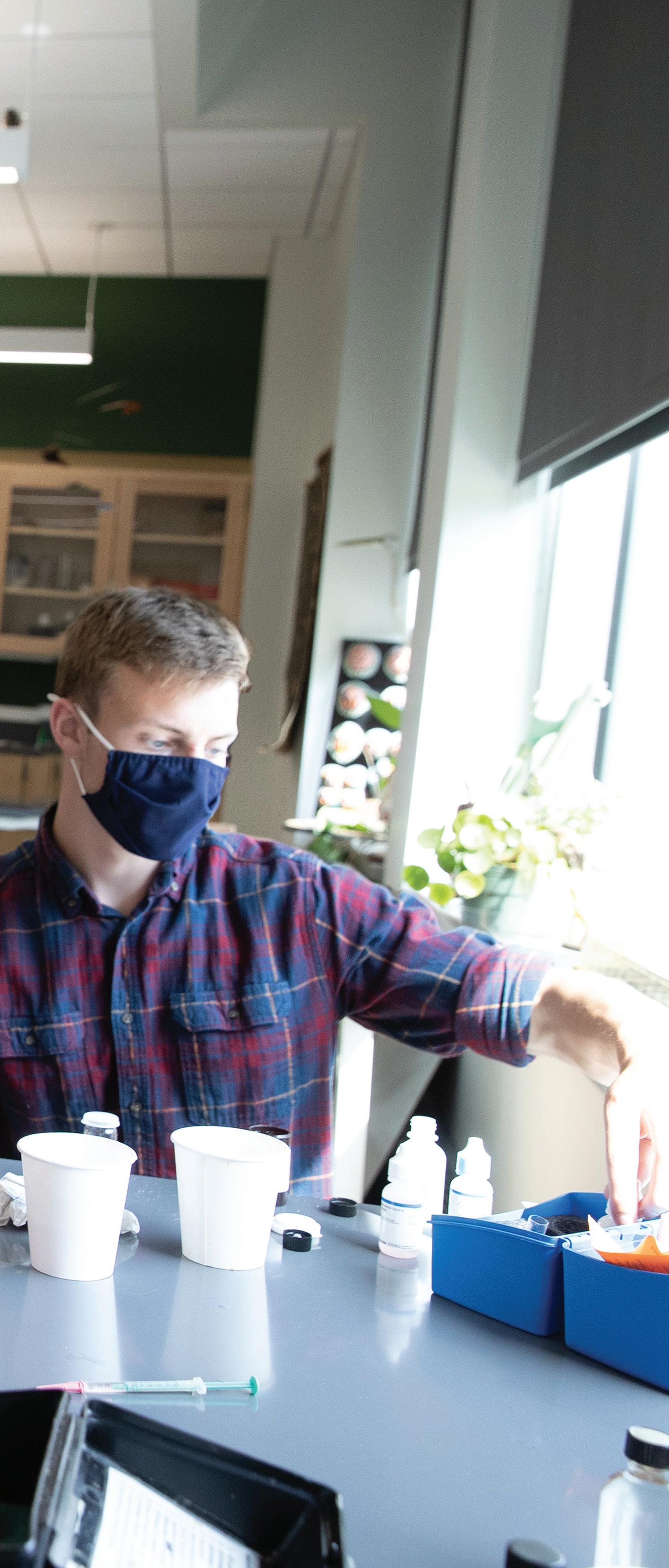
» Math Team
» Robotics
» Science Lecture Competition
» St. Andrew’s Medical Society
STANDARDS-BASED GRADING
In some math and science classes, teachers provide personalized feedback on how well students meet learning objectives (“standards”) within a given assessment. Students use this feedback to develop greater proficiency and can demonstrate their understanding through re-assessment. The result is that students spend more time in conversation with teachers about what comprises understanding and how it can be achieved, and less time talking about grades.
27
A LOOK INSIDE: ENGLISH 1

During their reading of Macbeth, English 1 students collaborate to stage the final scene of Act II. “While the text offers little in the way of stage directions, this scene is a pivotal and chaotic moment in which every living character in the play is on stage,” explains English 1 teacher Mr. Porter. “Throughout our reading of the play, I ask my students to be their own directors, to stage the play in their own heads. This exercise gives them the chance to compare their takes on virtually all the characters and justify their own choices.”
ALL-SCHOOL MEETING & FAMILY-STYLE LUNCH: Before lunch, the entire school community gathers in Engelhard Hall to share announcements, news, awards, short presentations & performances, and general Saints love.

A LOOK INSIDE: US HISTORY
OPEN TIME: Relax on dorm & change for soccer practice
AFTERNOON ACTIVITY: Soccer Practice All students participate in their choice of afternoon activities, which include sports, theatre, dance, and organic gardening.
OPEN TIME: Jazz Ensemble Practice Many clubs and activities hold meetings during this time period. It’s also a popular time for hanging out and playing games on the Front Lawn.
In their focus on primary source evidence, US History students explore fugitive slave ads from 1781-1861 from a nearby county in Maryland. Students collect data from these ads into a spreadsheet, then work in groups to analyze the gender breakdown of escaped men and women, the “value” of each enslaved person adjusted for inflation, and, using historic maps, the location of each ad and its corresponding distance to freedom. Students then put the data into conversation
ON DORM: Ping-Pong Tournament in Common Room!
BRUSH & WASH IN ROOM/LIGHTS OUT: Phone in hall pocket, in room, lights out by 10:30 p.m. Sleep is important!
28
8
•
•
•
•
12 • 1
•
•
3 •
A Typical III Form Schedule
BREAKFAST SIGN-IN
ENGLISH 1 9
10 BREAK: Grab a muffin to go from the Dining Hall!
CHINESE 1 11
HONORS GEOMETRY
2 BREAK
US HISTORY: RESEARCH CHALLENGES
4
•
•
6 •
5
CAFETERIA-STYLE DINNER
7 • 8
•
• 10
•
IT’S ALL
STUDY HALL
9
11
IN A DAY.
A LOOK INSIDE: ENGINEERING
In an assessment on design thinking, Engineering students work in groups to design a “Windaboolah”—a mode of transportation that must have room for five people; be able to travel through water, sky, and snow, and move through cities; be ready for unexpected adventures; and serve as a “home away from home.” Students must consider the needs and wants of users, define design principles, ideate multiple potential solutions, and build a prototype.
VI FORM PERK! Seniors are exempt from Breakfast Sign-in.
ADVANCED STUDY IN HISTORY: LATIN AMERICAN HISTORY
LONG LUNCH—OFF TO MENTORING! Lunch on Wednesdays is cafeteria-style, to allow mid-week time for students to participate in local community service opportunities.
ADVANCED STUDY IN LATIN: VERGIL
A LOOK INSIDE: AS CHEMISTRY
AFTERNOON ACTIVITY: Swim Team Practice All students participate in their choice of afternoon activities, which include sports, theatre, dance, and organic gardening.
OPEN TIME: Quick call to check in with Mom.
FAMILY-STYLE DINNER: On Wednesday nights, we all eat dinner together in the Dining Hall.
CHAPEL: Wednesday evening services always feature a student, faculty, or visiting speaker.
For one of their many lab experiments, AS Chemistry students use a spectrophotometer to track the rate progression of a particular chemical reaction; they’re looking for clues about underlying molecular mechanisms.
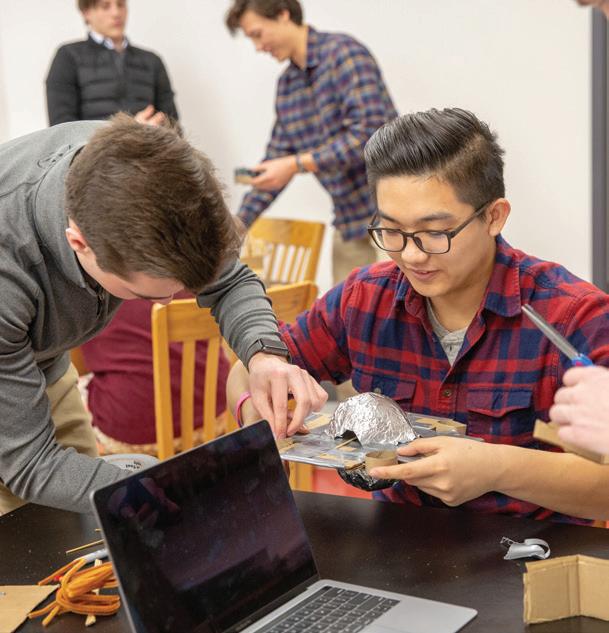
“On the one hand, this is a standard ‘AP lab’ with the stated goal of determining what is called a rate law,” explains AS Chem teacher Eric Kemer. “However, we use the fact that the experiment virtually never produces the precise ‘textbook’ answer to turn it into a short research project aimed at revealing the sources of this deviation.”
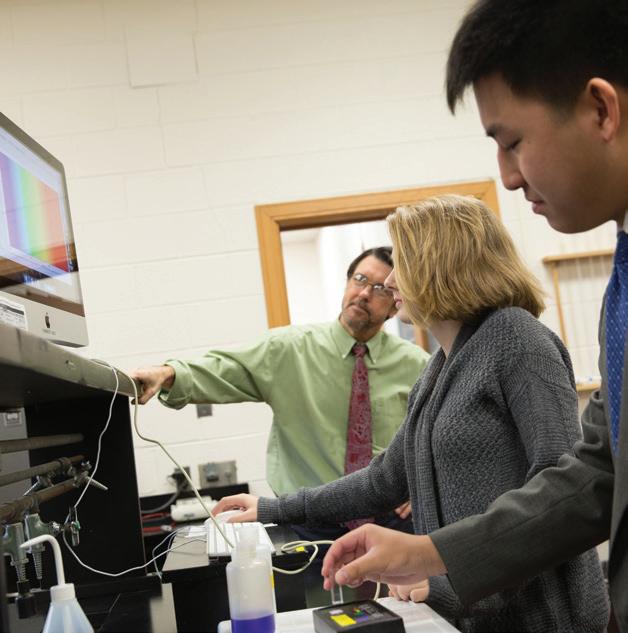
29
8
•
9 • 10
• 11
•
• 1
• 2
•
3 •
4
•
•
6
• 7
•
8
•
• 10
•
11
A Typical VI Form Schedule
ENGINEERING
12
BREAK
AS CHEMISTRY
OPEN TIME: Environmental Stewards Meeting
5
OPEN TIME: Cookies & Milk!
STUDY HALL
9
OPEN TIME: Lead dorm function!
ON DORM
IN ROOM/LIGHTS OUT
What about College?
St. Andrew’s practices a powerful and distinct approach to the college admissions process. Because we are a small and 100% residential school, our College Counseling team lives and works in close proximity with students. This proximity allows our counselors to really get to know each student and to offer intensive and highly personalized guidance—and to confidently share each student’s story with the very best colleges and universities in the world.
Your college counselor will help you make academic and extracurricular choices during your time at St. Andrew’s, will advocate for you, and will partner with you and your family throughout the college application and financial aid process. Your counselor will also help you keep the college process in perspective. At the center of our college counseling process are two core beliefs shared by students and faculty alike:
1 The meaning of your St. Andrew’s experience encompasses much more than your college destination.
2 The most important question you can ask during the college application process is how you will contribute to the college or university you attend. The goal at St. Andrew’s is to keep the college process free of drama, unhealthy competition, and high anxiety. Instead, this process is a path to self-discovery.
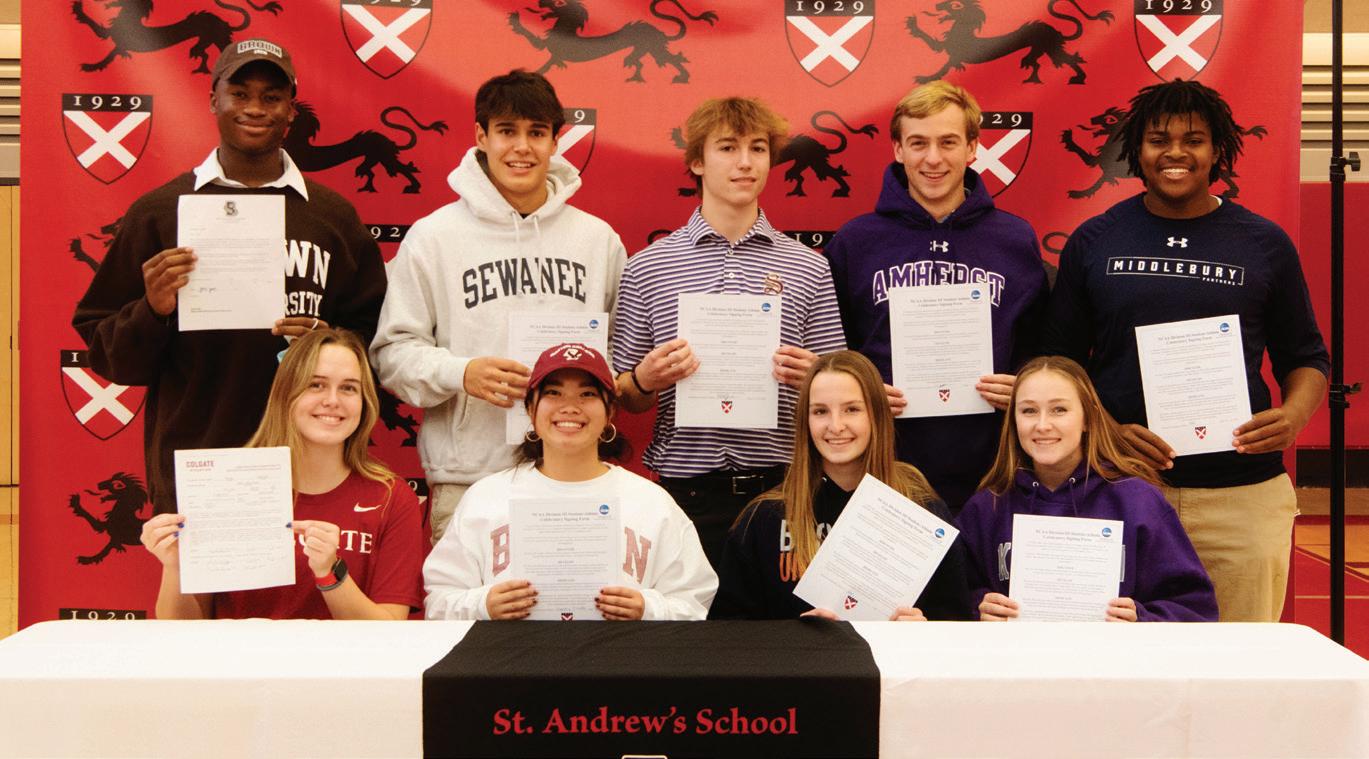
Our students enroll in the most selective colleges in the U.S. and around the world, but our primary goal is to ensure that each student finds the best fit—a college or university where the student will continue to thrive and be their best self.
JASON HONSEL DIRECTOR OF COLLEGE COUNSELING
60-70
Colleges Visit SAS Each Year
While on campus, college representatives hold mini-info sessions, eat dinner with students, and sometimes conduct interviews.
TOP 21 COLLEGES 2019 – 2022
Davidson College ...................................... 15 University of Virginia 14 Princeton University .................................. 11 Tufts University.......................................... 10 Wesleyan University 10 Brown University ......................................... 9 University of Pennsylvania 9 Middlebury College .................................... 8 Boston College ........................................... 7 Tulane University 7 Dartmouth College ..................................... 6
Sewanee: The University of the South ........ 6 Wake Forest University 6 Yale University ............................................. 6 Columbia University .................................... 5 Georgetown University 5 Haverford College ...................................... 5 New York University .................................... 5 Northeastern University 5 Washington University in St. Louis ............. 5 Williams College 5
3 College Counselors
(all of whom live on campus)
The team is rounded out by an essay editor and an administrative assistant.
30
In the spring of 2020, Harrison Foley ’17 was named a Trident Scholar at the U.S. Naval Academy; the Trident Scholar Program funds opportunities for independent study and research. A computer science major, Harrison investigated vulnerabilities in machine learning paradigms.
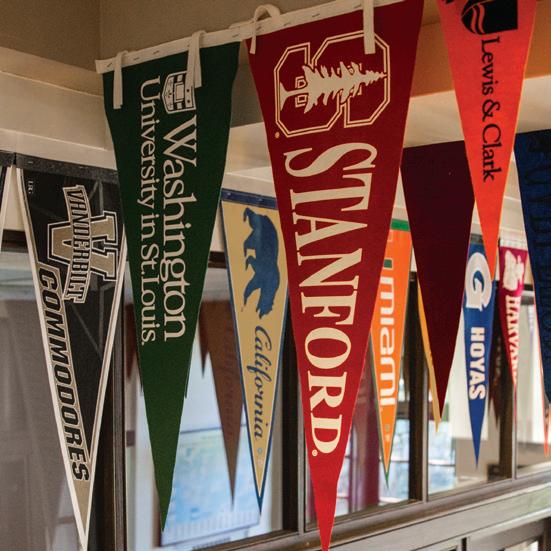
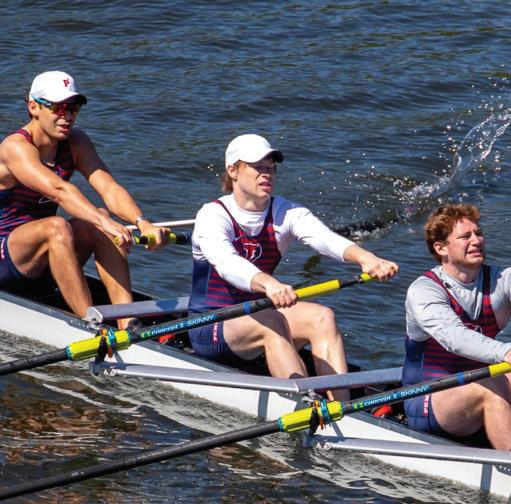

Amrit Chapman ’21 (left), rowing for Georgetown, and Christine Wu ’20 (right), rowing for Dartmouth, are just two of our recent alumni who are participating in their university’s rowing programs.

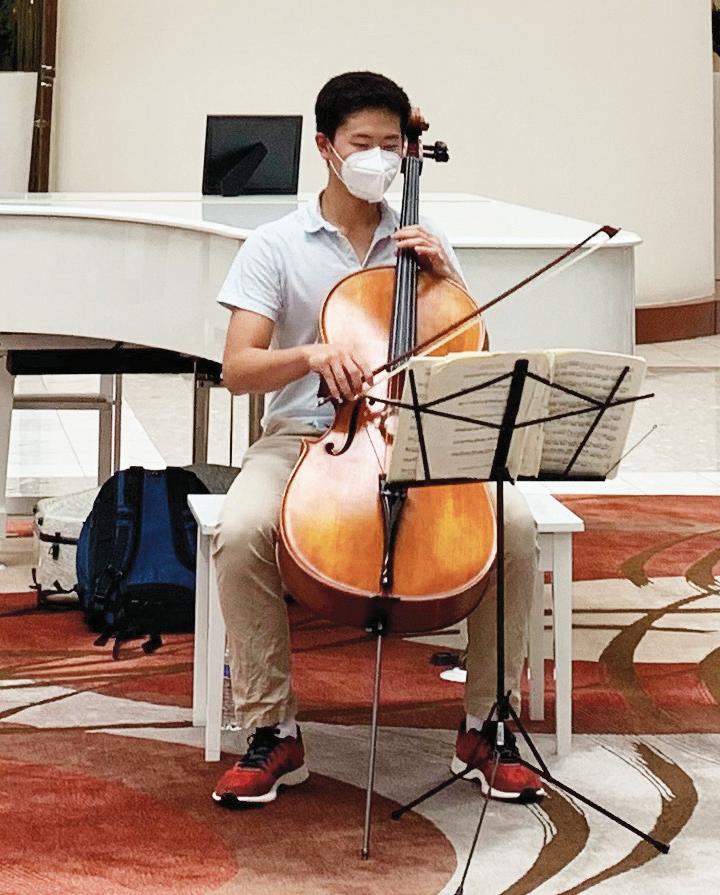

A biology major at the University of Pennsylvania, in his free time, Nick Loh ’19 plays music for the elderly at the Penn Memory Center and an elderly patient with dementia. During the pandemic, Nick met and talked with patients over Zoom and performed short snippets of music; residents would then guess the song.
Theo Jaffe ’19 works as a game day student trainer for the Duke Blue Devils.
Lawrence Phillips ’17 received the 2022 Thouron Award, a prestigious scholarship offered to University of Pennsylvania graduates to fund up to two years of postgraduate study. Lawrence is now pursuing a master’s in the philosophy of science at Cambridge University.
31
A Few Facts about Our Faculty
OUR 80 FACULTY MEMBERS HOLD MORE THAN 60 ADVANCED DEGREES.

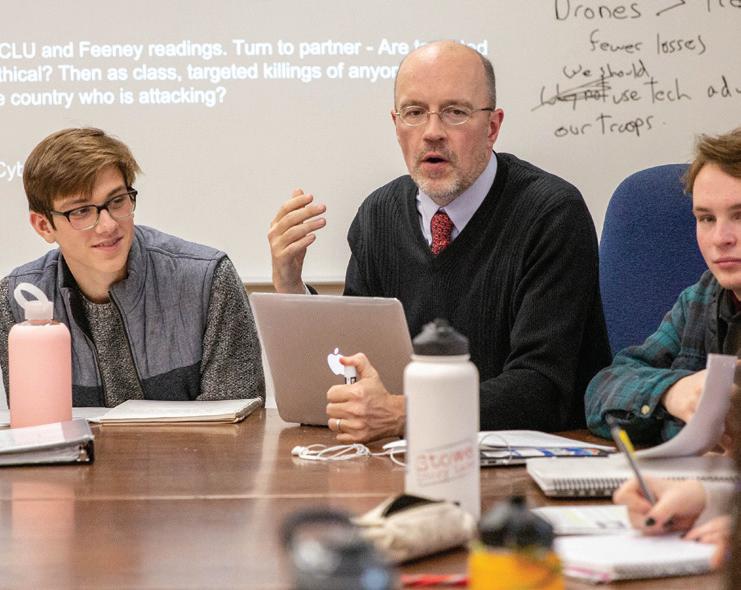
MS. PRESSMAN
While pursuing her master’s in history at Yale, researched a massive resistance to school desegregation in Milford, Delaware in 1954
MR. SHREM
Regularly publishes and lectures on the intersection of the fine arts and gastronomy, and spends part of his summer breaks working on an organic goat cheese farm in France’s Ardèche region. Most recently, he contributed to The Oxford Companion to Cheese
MR. PORTER
MR. GILHEANY
Received a Fulbright Distinguished Award in Teaching for 2012 to pursue research on pedagogy in Israel and the Palestinian Territories, and published a paper based on this research in the peer-reviewed journal Religious Education
DR. GEIERSBACH
Has a doctorate in music education from Columbia University, and studied the flute with the legendary Louis Moyse
MR. REHRIG
Previously worked as a civilian nuclear engineer for the Navy at the Norfolk Naval shipyard, where he was part of a team that overhauled and modernized Nimitz class aircraft carriers
MRS. CARROLL
MS. CHIU

Works with Chinese teachers nationally on curriculum development
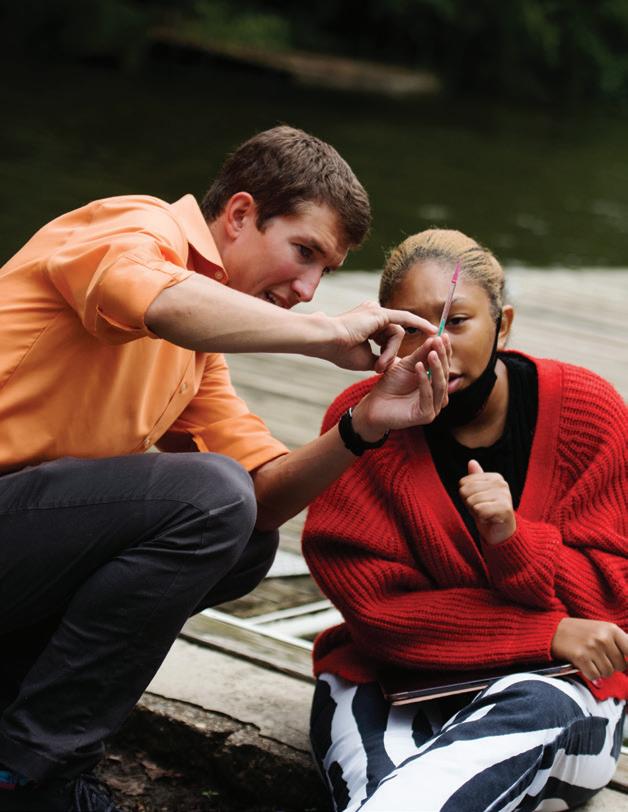
All-American lacrosse player at Hamilton College, where she won a NCAA Division III National Championship with her team. Additionally, she and her husband met at St. Andrew’s while they were both in their early years of teaching
Four-year member of the Cornell men’s rowing team
MRS.
TISDALE FISHER
The first Black woman to win the title of Miss Georgia in 2004 in the (then) 60 year history of the pageant (she also competed at Miss America and was a talent winner and top ten finalist)
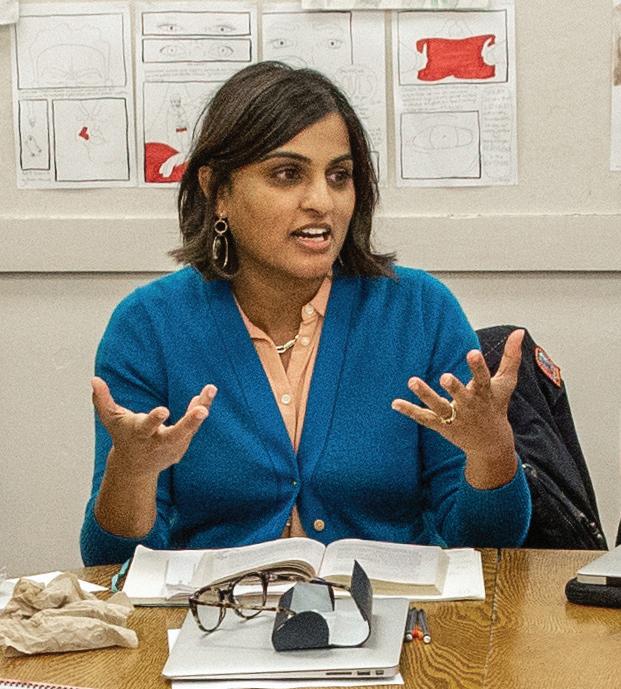
MS. REDDY
Researched Petrarch in the south of France with grant support from the National Endowment for the Humanities
THE VAST MAJORITY OF OUR FACULTY LIVE ON CAMPUS, AND SERVE “IN LOCO PARENTIS” FOR OUR STUDENTS.
MR. MUFUKA
As a US Marine, served tours in Afghanistan and Iraq, and lived and worked in nine countries across five continents
MR. GOLD
Has danced with the Houston Ballet as a member of the corps de ballet and with the Omaha Theater Ballet as Principal Male Dancer
MRS. KELSEY
Exhibits her oil and watercolor paintings in numerous local solo and group exhibitions throughout the Mid-Atlantic
DR. JOHNSON
Ate every item on the Wendy’s dollar menu in under an hour while working toward his PhD in chemical engineering at UC Berkeley (today, Dr. Johnson is a vegan)
MRS. TAYLOR
Worked for 15 years with the Glimmerglass Opera Theatre in Cooperstown, NY, where she was both a performer and a member of their technical staff
DR. HYDE
While pursuing her graduate studies in astrophysics, interned at NASA’s Jet Propulsion Laboratory in California, where she researched sites of future star formation in our galaxy
M. MILLER
Has done geoscience research in Alaska, the Bering Sea, Iceland, and Greenland, and is trained in crevasse rescue
CHAPLAIN HUTCHINSON
Played soccer and lacrosse and wrestled at Amherst College, later writing his Harvard Divinity School master’s thesis on the nexus between sport and spirituality

MR.
HONSEL
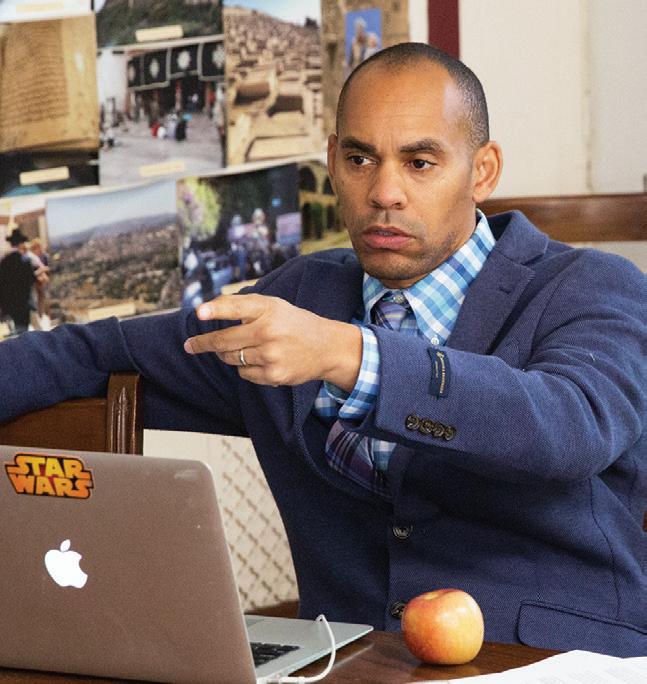
Holds a master’s degree in cinema studies from NYU (and walks his dogs at 5 a.m. every morning)
DR. WALSH
Published a book, Brill’s Companion to the Reception of Aristophanes, in 2016. In January 2023, he will begin work as editor of The Classical Outlook, the leading publication for classroom teachers of Latin, Greek, and the ancient Mediterranean world
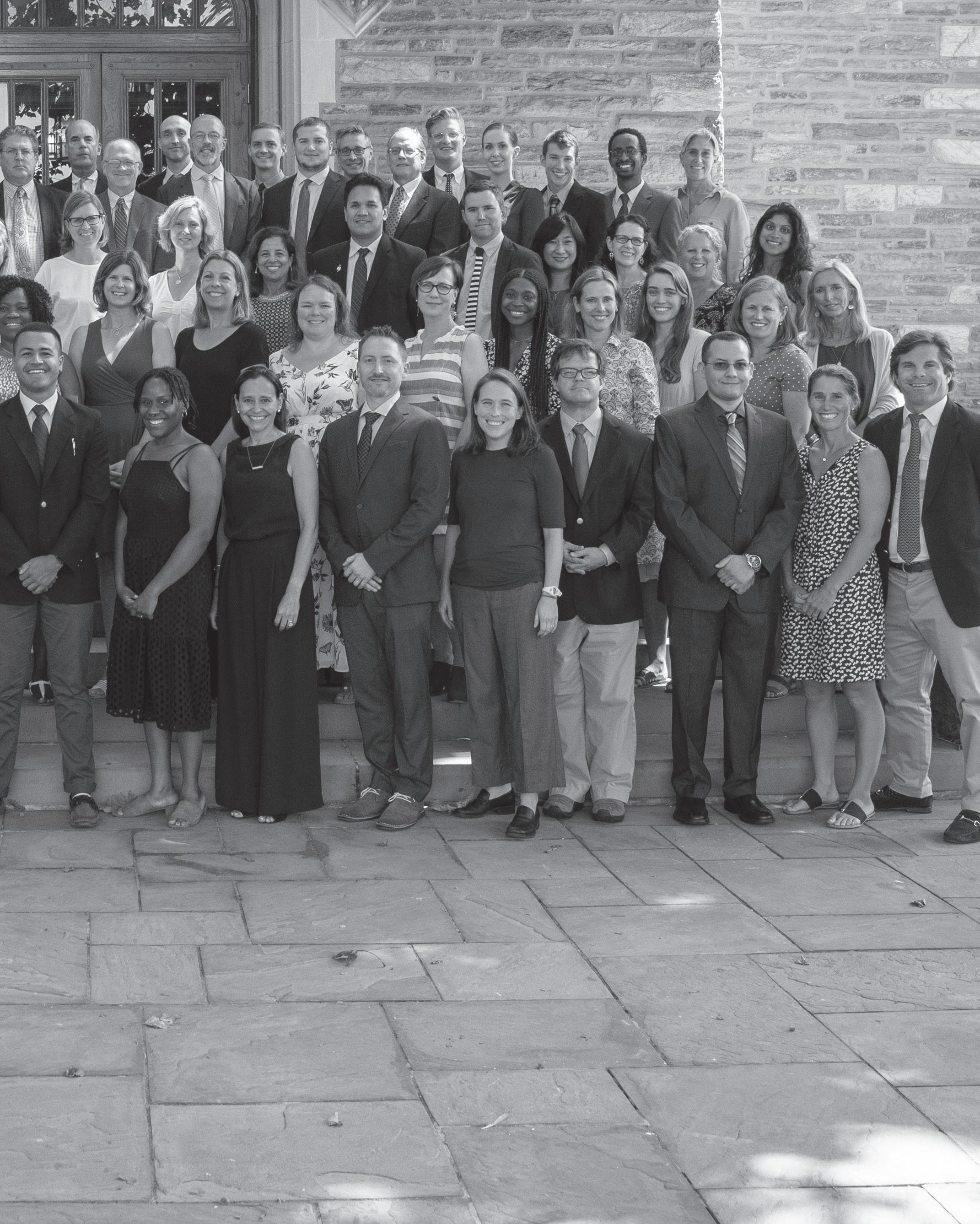

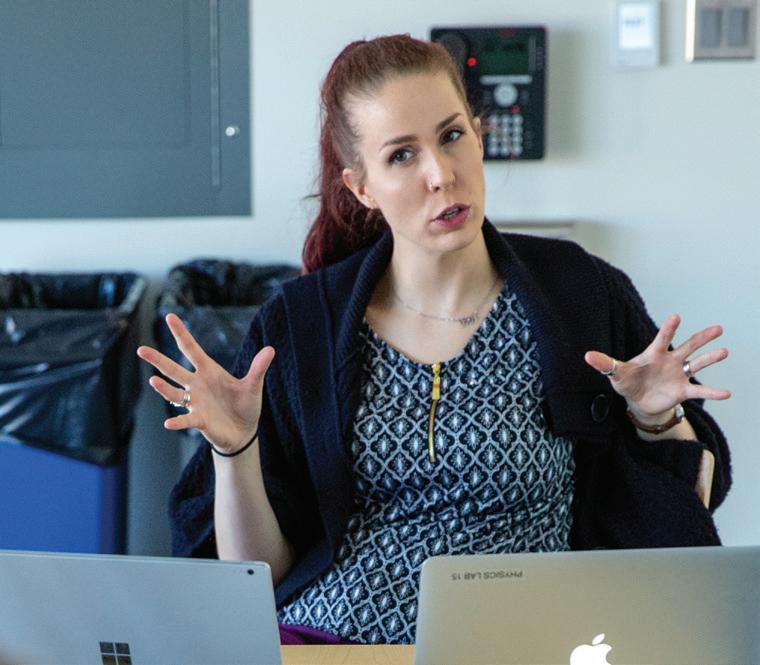
OUR FACULTY DESIGN AND TEACH MORE THAN 90 CLASSES, HALF OF WHICH ARE COLLEGE-LEVEL COURSES.

STRETCH YOURSELF
“In history, we had a discussion around taking down Confederate statues. I initially thought they shouldn’t be removed, mainly to avoid civil unrest, but after much deliberation with my classmates, I shifted my point of view. The whole discussion made me think about the topic from another perspective.”
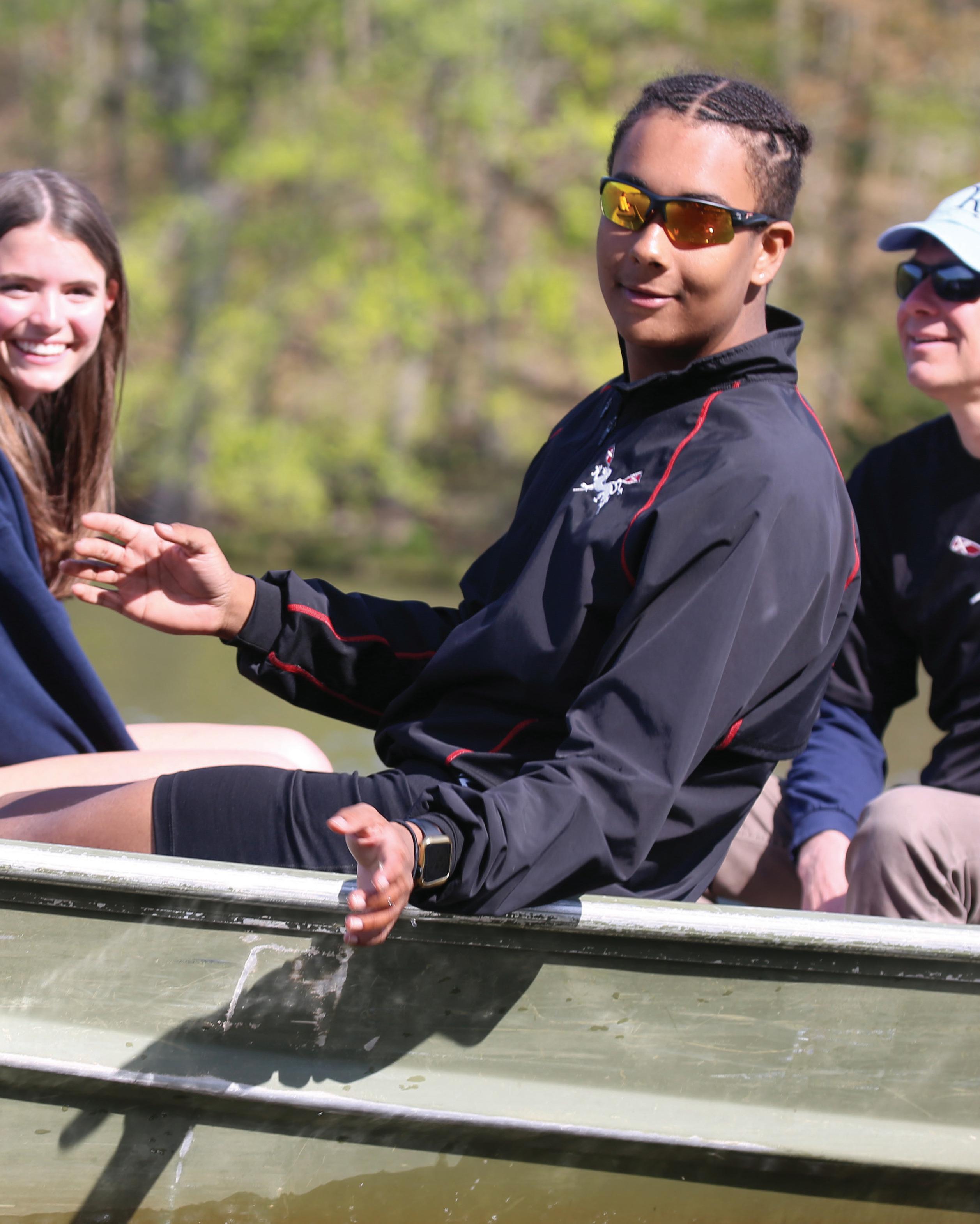
MEET Tyrus Roney
PHILADELPHIA, PA IV FORM STUDENT
Tyrus’s thoughts on...
TACKLING CHALLENGES
My toughest class last year had to be U.S. History. Mr. Cuicahua had a great and engaging method of teaching, and taught a tough class and tough material. I thoroughly enjoyed it, though, because the struggle and frustration made me see that it wasn’t going to get easier, so I should embrace the challenge. That made my A grade for the fourth quarter so much more meaningful.
WHAT WE DO ON WEEKENDS
Weekends at SAS have to be one of my favorite aspects of the school. They’re always jam-packed with activities like going into town or fun dances, but they are also a time to rest by yourself or with your friends. I’d often go to the basketball court or take a bike ride by myself to clear my mind from the last week and prepare myself for the next.
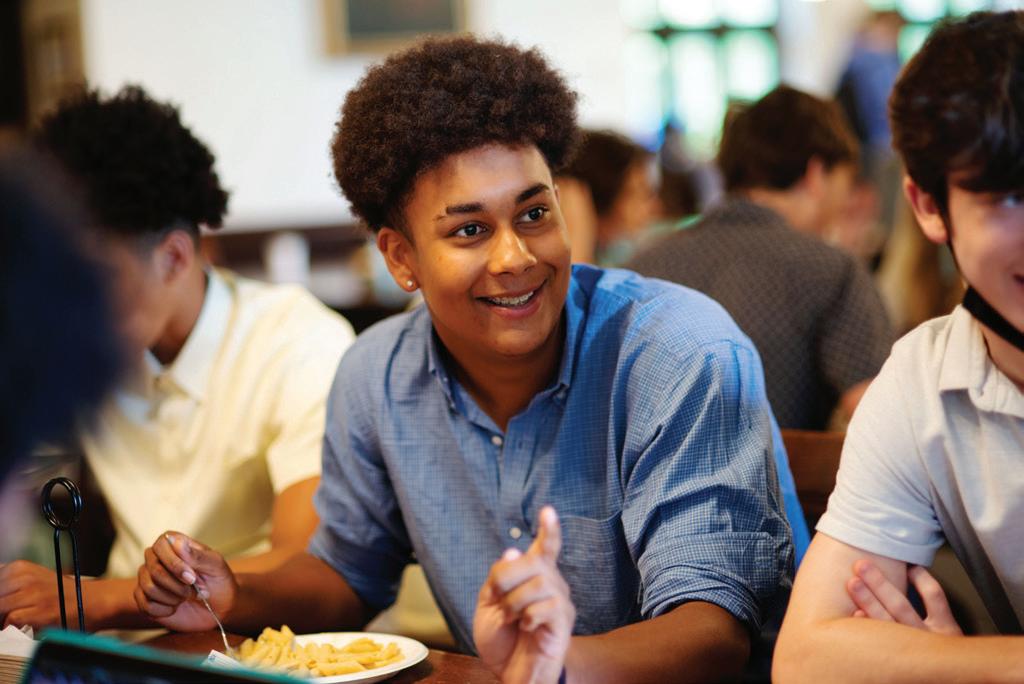
TRYING SOMETHING NEW
I hadn’t tried football or crew before I came to SAS. During football season, I was getting acclimated to being in a new setting, and football gave me friendships with great people. I earned a starting spot on the team and eventually was recognized as one of the best freshmen in the state. In the spring, rowing changed my outlook on a lot—mainly my mental toughness—and it helped me experience the best of the SAS community and legacy.
LIVING WITH “DORM PARENTS”
Throughout the course of the year, academics, athletics, and being away from home could stress me out. After some turmoil at home, I was in a bad spot mentally. I thought I would just end up getting over it by myself, like I always do, but no! Mr. Sanchez picked up on my demeanor and told me to talk to him in his apartment (which is very tastefully decorated by the way). We had ice cream, he said he noticed I seemed stressed and gave me some strong advice. Then we chatted about Nintendo Switch and then I took some more ice cream to go.

Football Basketball Crew Cardinal Society Project Zero
FAVE DINING HALL FOOD
Chicken parm, right after crew practice.
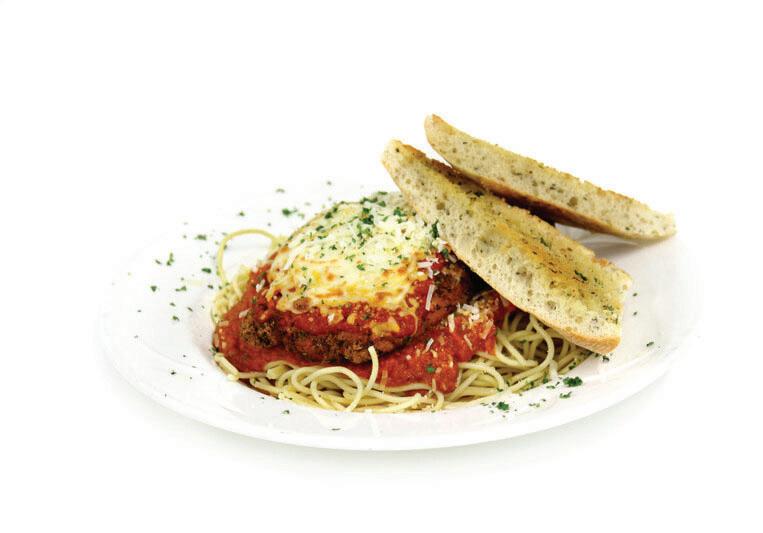
35
working for something bigger than ourselves
Imagine a high school where you live with your friends and teachers. At the end of the school day, you leave the classroom, but you don’t leave the community.
This is St. Andrew’s.
36
We not only learn together but also live together—and that fundamentally changes the nature of our school and your high school experience.
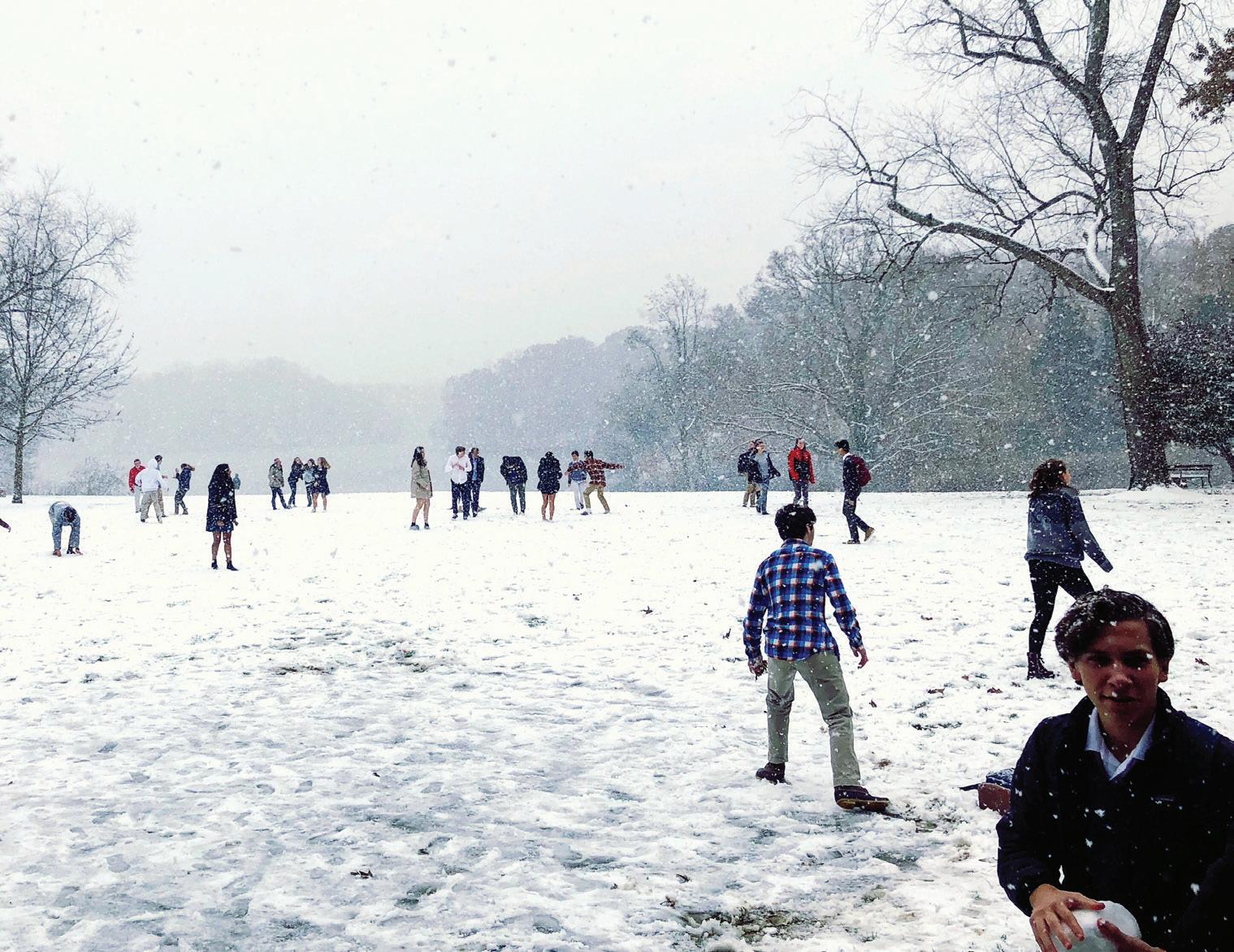

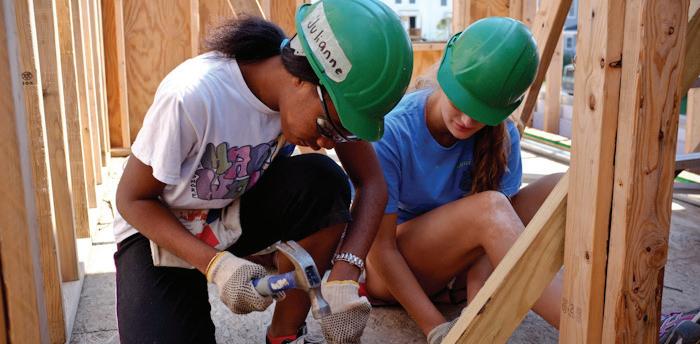

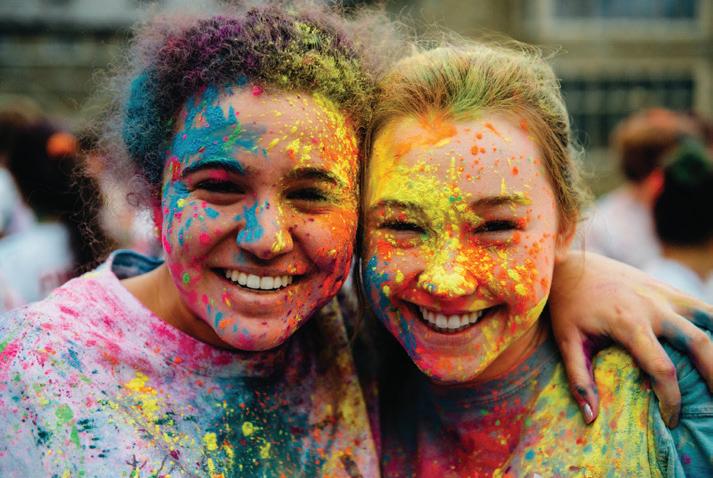
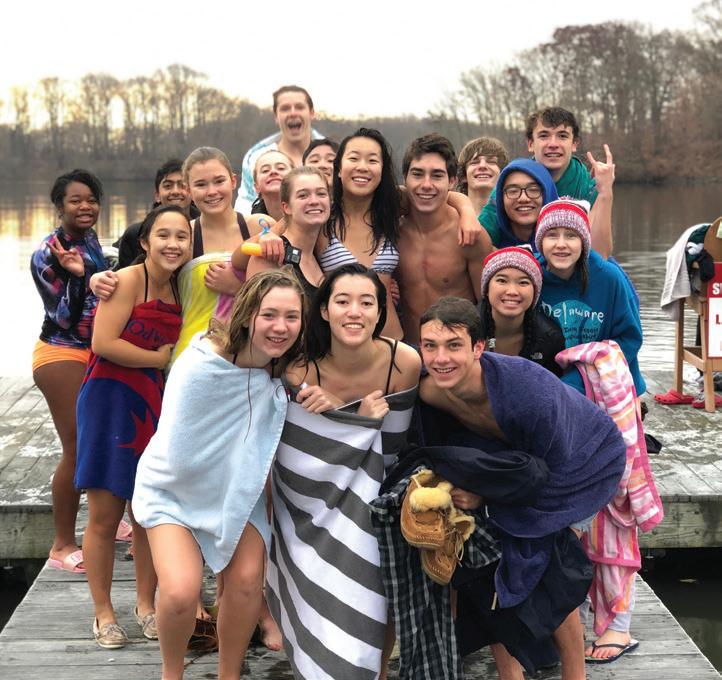

We believe...

that what happens between 3:30 p.m. and 10:30 p.m. at St. Andrew’s is what makes all the difference.
3 : 30 PM
After class ends, you’re off to your afternoon activity from 4-6:00 PM. Visit standrews-de.org/activities to explore all your afternoon activity options by season.
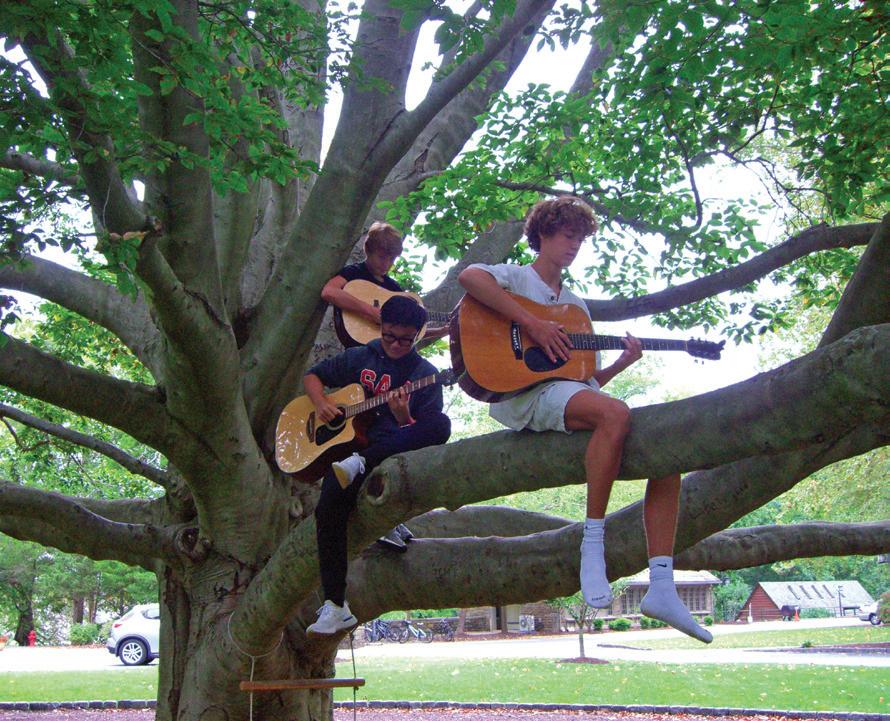
6 : 00 PM
When afternoon activities conclude, you’ll head back to your dorm room for a quick shower (and maybe a call to your family!), then down to the Dining Hall for dinner with friends, to a faculty residence for an advisory function, or perhaps into a van to bring and serve dinner at a local homeless shelter.
7 : 00 PM

After dinner, you might swing by the Front Lawn to sneak in a game of Four Square before the sun sets, then:
• Attend a Model UN meeting in the Main Common Room
• Join an affinity group gathering at a faculty apartment

• Use a telescope to view the stars over Noxontown Pond with Ad Astra (our astronomy club)
• Work on Vex robot with Robotics teammates
• Direct a rehearsal of your play (written by you!) with your fellow Playwright Club members
• Meet with the Environmental Stewards to organize plans to reduce waste on campus

• Meet with a college representative
… to name just a few options.
38
7:45 PM
When you hear the St. Andrew’s bell tower chime eight, you know it’s time for dorm check-in and study hall. Study hall lasts until 10:00 PM, and then it’s on-dorm time, which means you might:

• Make brownies or nachos in your dorm kitchen
• Have an interesting chat with the faculty member on duty
• Play a hand of poker or an intense round of Ping Pong
• Join in an impromptu dance party/sing-along
• Rearrange the furniture in your dorm room with your roommate
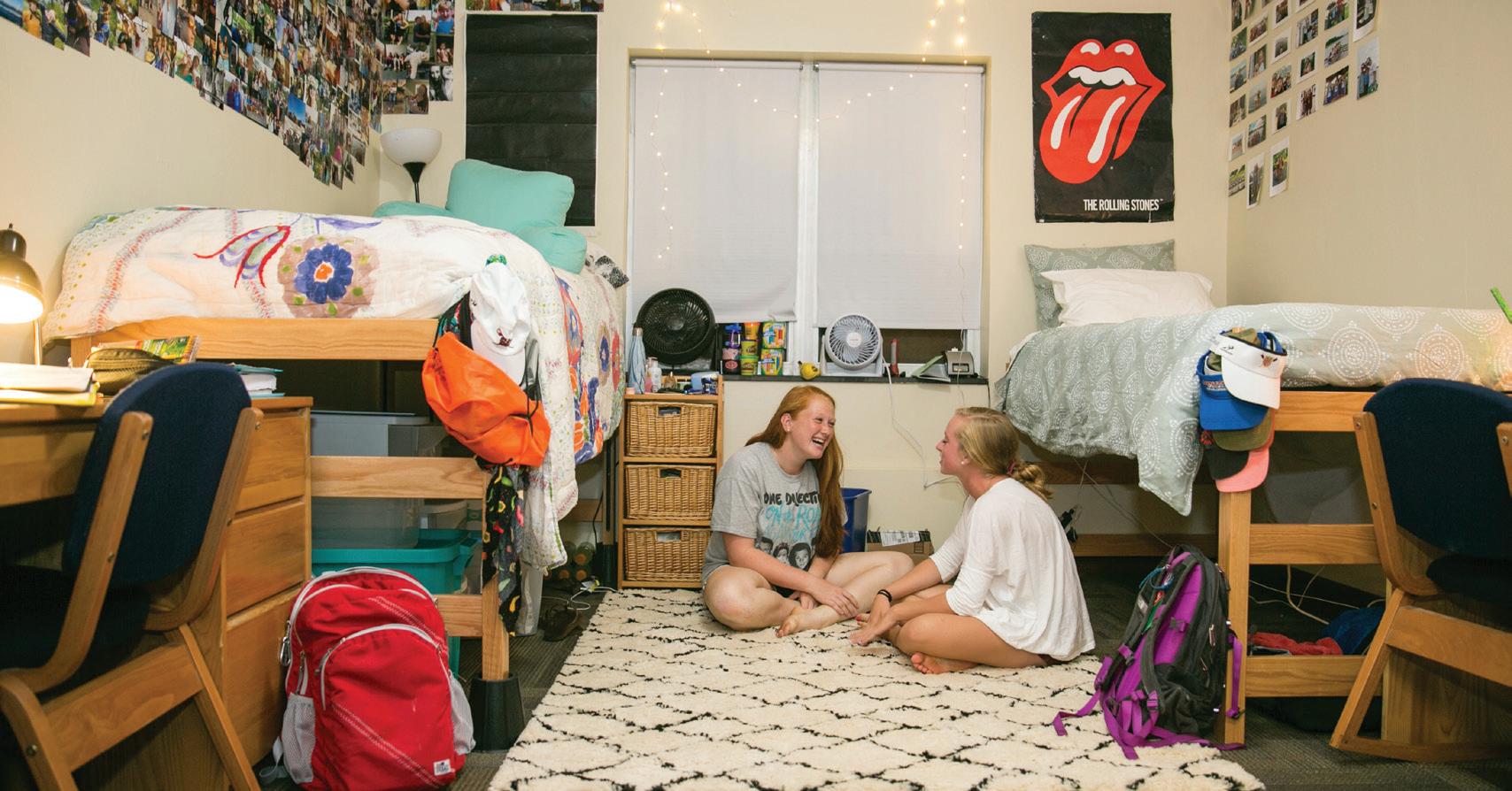
• Attend a “Wisdom Wednesday” talk in the Pell Dorm common room
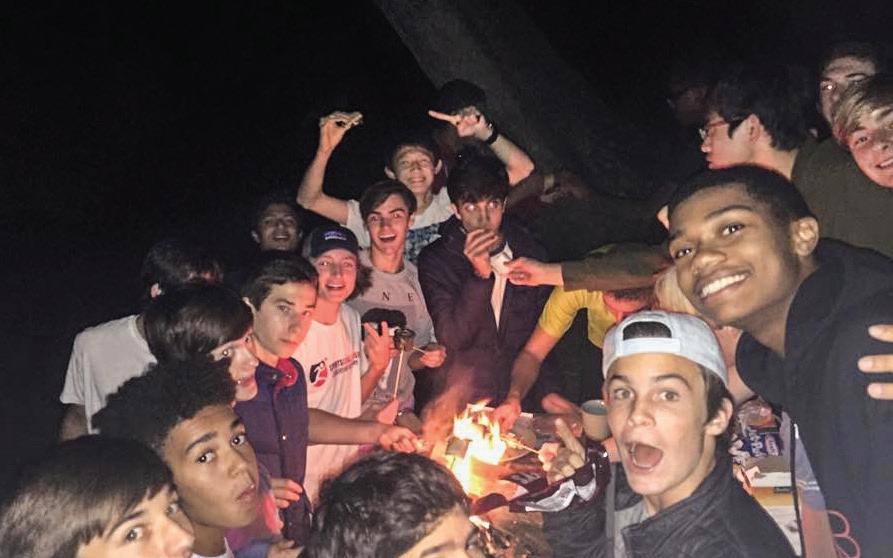
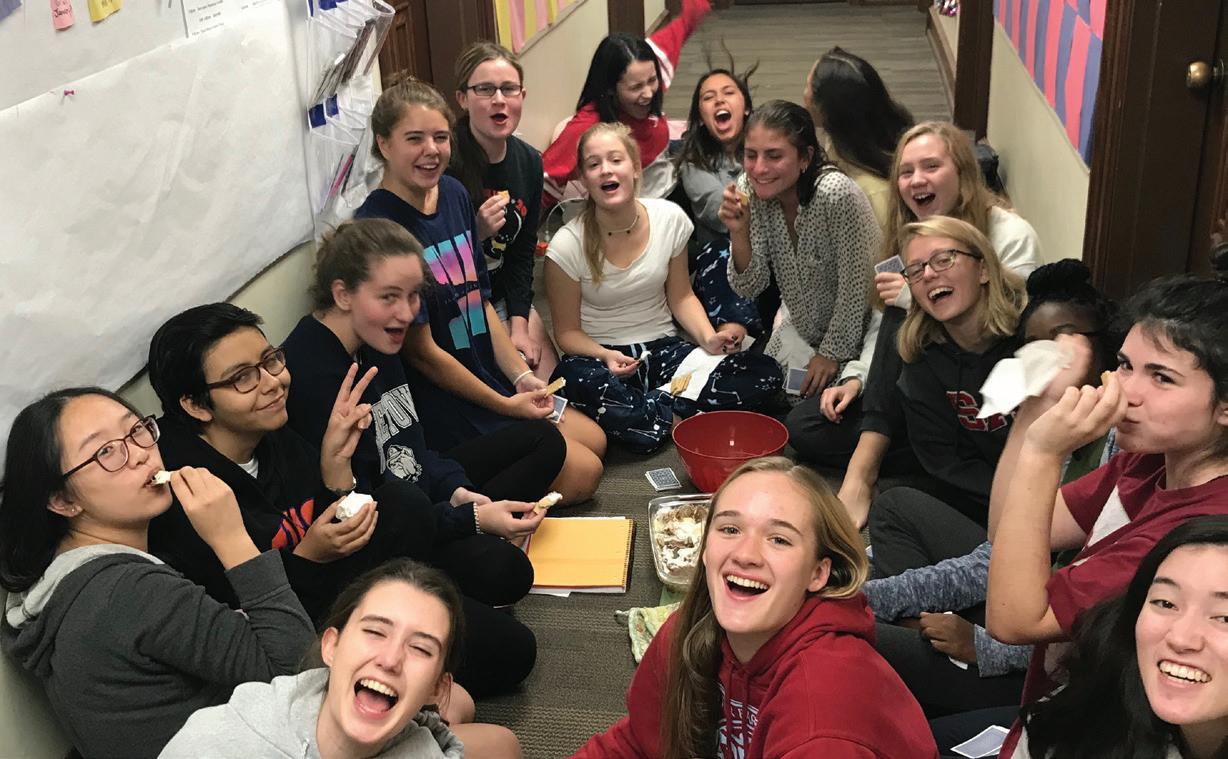
I’ve come to find that you get out of St. Andrew’s what you put into it. Go into every activity, every tradition, and every day looking for random and spontaneous ways to have fun. The weirder the better!
10 : 30 PM
Finally, you’ve come to the end of your day. You’ll put your cell phone in the hall rack, do your nightly dorm job, and brush and wash in the bathroom. The senior on duty will stop by your room to say good night, chat about your day, and then it’s lights out. Get a good night’s sleep—it’s sure to be another full day tomorrow!
ADELAIDE DIXON ’22 VIRGINIA
What Happens on the Weekends?
At St. Andrew’s, you already live 24 hours a day, 7 days a week with your friends. On weekends, finding fun is as simple as waking up and walking out the door of your dorm room. Friday evenings are often reserved for guest speakers and special programs. On Saturday mornings, you’ll often be involved in community service; events, workshops and conferences; athletic practices and games. Some Saturdays are also set aside as “sleep-in mornings.” On Sunday mornings we go to Chapel, then brunch in the Dining Hall. The rest of the weekend is your free time to hang out, get outdoors, and enjoy excursions off-campus—everything from a simple walk to town, to trips to Philadelphia, D.C., and New York.
SWAG—ST. ANDREW’S WEEKEND ACTIVITY GROUP


SWAG organizes a “Weekend Plan” for every Saturday & Sunday—a huge schedule of on- and off-campus activities open to all students.
SAMPLE SWAG SCHEDULE

SATURDAY
9-10 AM Equity Conference workshops
11 AM - 3 PM Athletics practices/games
11 AM - 5 PM Trip to Rehoboth Beach
6 PM Dinner trips to local restaurants
8 - 10 PM Silent Disco in the library
8 - 10 PM Open Mic Night & bonfire on the Front Lawn
10 PM Food Trucks in Admissions Circle
SUNDAY
Noon - 6 PM Philadelphia trip to see Angels in America
12:30 - 3 PM Trip to SkyZone trampoline park
12:30 - 5 PM Hike around Noxontown Pond
1-4 PM Movie & mall trips
1 -3 PM Canoeing on Appoquinimink Creek
5 PM Cookout & T-dock swimming
6:30 PM Dodgeball tournament in Sipprelle Field House
40
MORE THAN 80 CLUBS AND ORGANIZATIONS WWW.STANDREWS-DE.ORG/CLUBS
I don’t think I will ever forget how much fun I’ve had over the weekends here at SAS. From fire pits, to Open Mic Nights, to dances, to movies, to trips to town, to card games, to Playa Bowls and so much more, my weekends here have been filled with wonderful memories of time spent together with friends that I will always cherish.
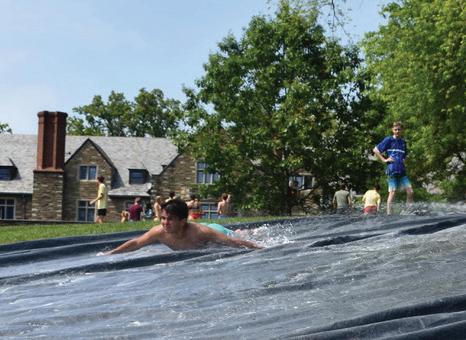
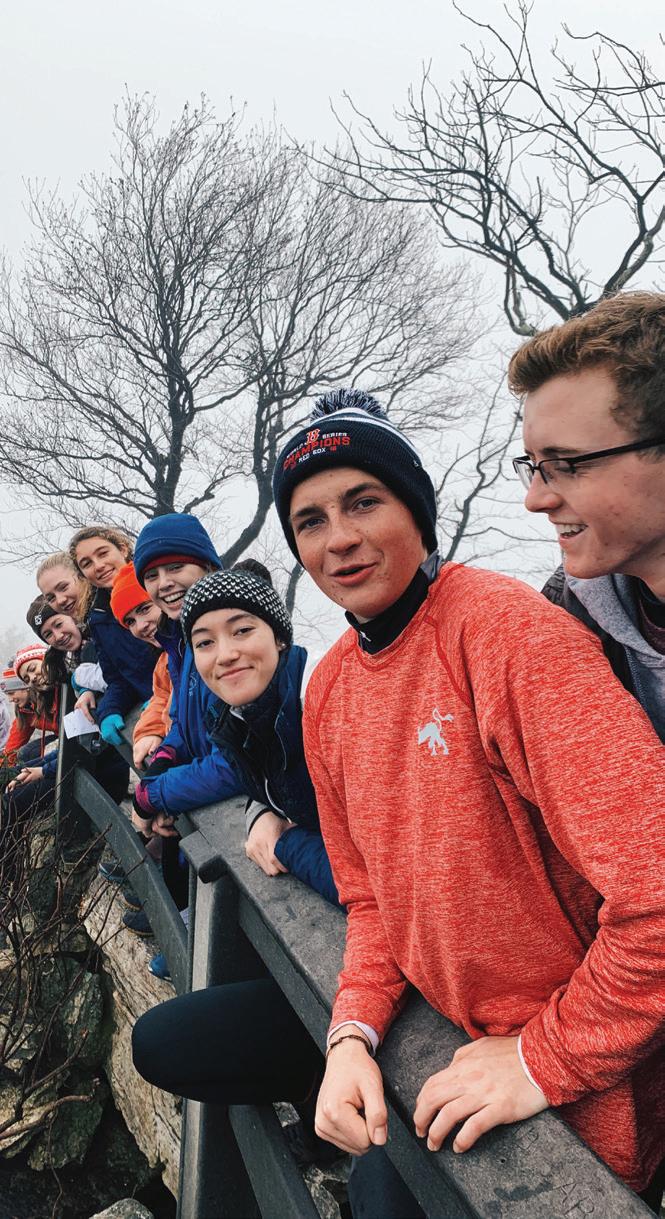


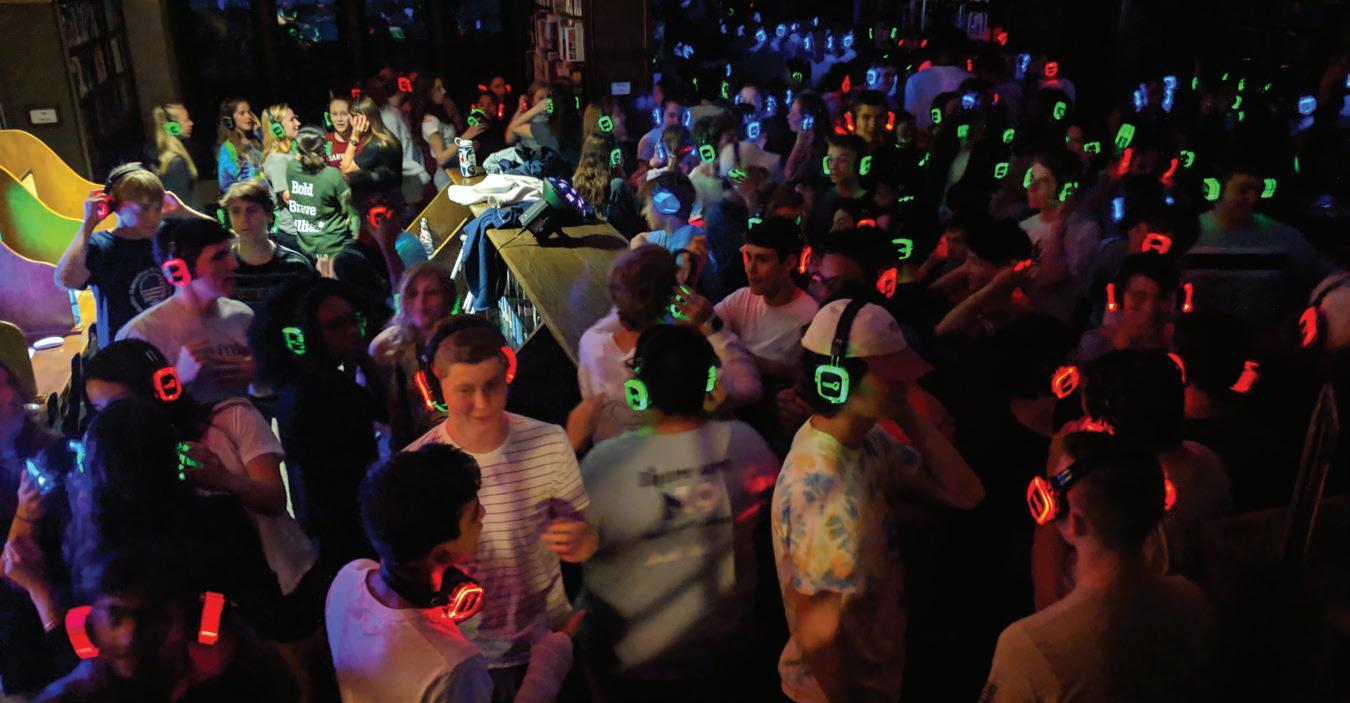
41
GINO PALACIOS ’21 NEW YORK
My happiest memories, favorite traditions, and most meaningful moments occurred on the Front Lawn—after dinner on a warm summer evening, during an impromptu snowball fight, while basking in the sun on a Free Day, or under the stars during a late-night game of cards, the Front Lawn is where connections are made and friendships formed. It embodies what makes St. Andrew’s beautiful and unique: anyone can sit down with anyone, we have meaningful conversations, and we prioritize face-to-face interactions. St. Andrew’s, at its core, is about genuine human connection.
THE FRONT LAWN
Spending at least a few minutes each day on the Front Lawn is a way of life for St. Andreans. It’s more than a front lawn; it’s our living room. On the Front Lawn, you’ll play a quick game of spikeball or join in a snowball fight between classes, meet with your advisor on the T-Dock, and gather with your entire class after Chapel. You’ll throw a tennis ball with a faculty dog, fly down the slip n’ slide during Maui Wowie, and jump in the pond at 7 a.m. with the Polar Bear Club. We hold classes, cookouts, Chapel services, festivals, and weekend events on the Front Lawn, year-round.
The Spaces Where We Gather & Build Community
ENGELHARD HALL

Engelhard Hall is a 516-seat auditorium space where we hold all-School Meeting once a week, and gather regularly for student performances, visiting speakers, panels, workshops, and so much more. The Engelhard stage has hosted everything from robotics demonstrations to salsa lessons; from student science presentations to experimental theatre to talks by the leading minds in America.
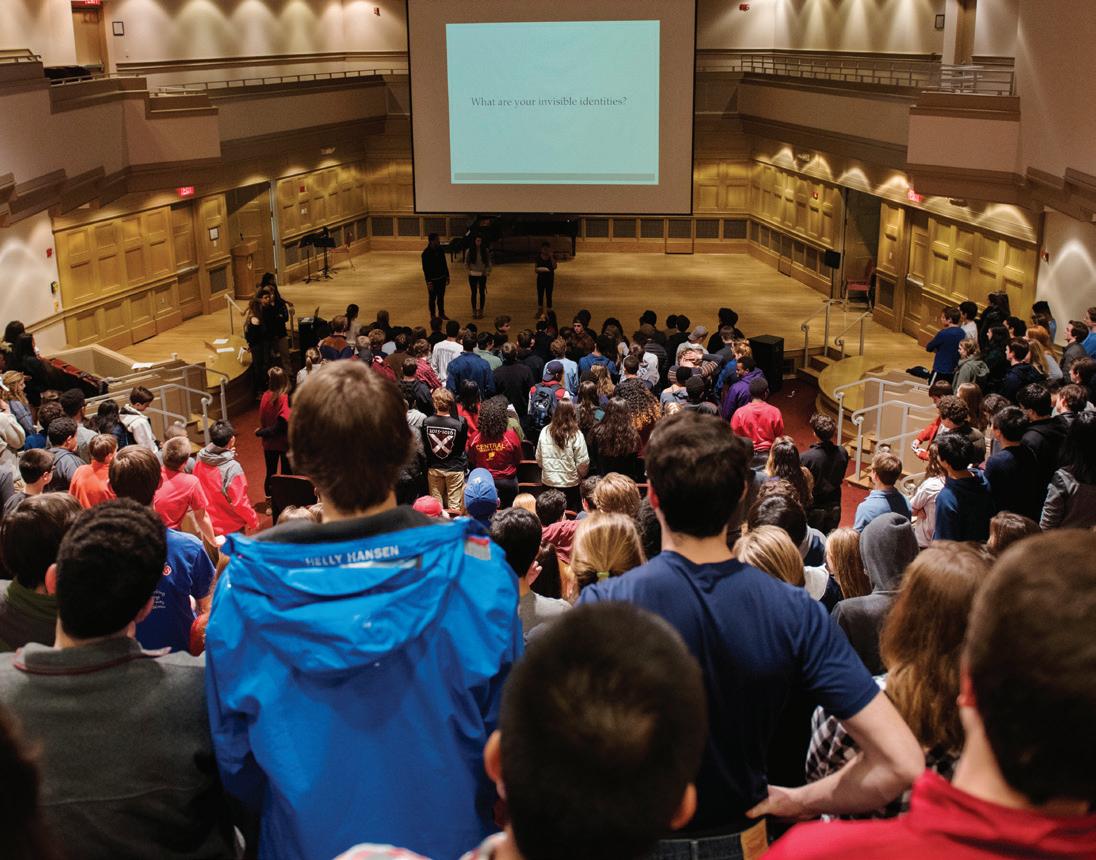
42
NICHOLAS LAMPIETTI ’21 WASHINGTON, D.C.
THE DINING HALL

We take our meals “family-style”: faculty and students eat one meal all together every weekday, at assigned tables. Two faculty and eight students—typically two from each Form—are seated at each table, with student table assignments rotating every few weeks. During meals, students take turns serving food and setting and clearing the table. We enjoy family-style meals at lunch four days a week, and for Wednesday night dinner prior to Chapel. (All other meals are served cafeteria-style.) Family-style meals are a time when we slow down, connect, and catch up with one another.
THE CHAPEL
Our Front Lawn— the heart of our campus—is 7,000 square feet of pure fun.
We are an Episcopal school, grounded in and upheld by our Episcopal identity, and we welcome all persons, regardless of their religious background. We gather in the Chapel twice a week—once on Wednesday night, and again on Sunday for a more traditional service. Many services are student-led, and we celebrate a variety of world religions and religious holidays. Chapel is the place where we come together to share our stories and traditions and contemplate our values and beliefs.

QUICK FACT
Your Community of Care
All of the adults in our community work together to provide a network of care for each student. Beyond teaching and coaching, faculty also serve as advisors to students, and work in “dorm teams” on residence halls. Students are also supported by academic advisors, Form advisors, our counseling team, and our Health Center team.
THE ADVISING SYSTEM
Every student has a faculty advisor; new students are assigned an advisor, and returning students choose their advisor each year. In bi-weekly meetings, your advisor will mentor and guide you in all aspects of life at St. Andrew’s, from the academic to the social and everything in between. Each faculty member has up to eight advisees at a time, who get together in a group regularly for “advisory functions” (dinners at the advisor’s home, birthday parties, off-campus excursions), and eat lunch together in the Dining Hall once a week. Your advisory will become your “mini-family” on campus.
THE DORM SYSTEM
Although seniors are responsible for much of the day-to-day leadership on dorm, each residence hall is also cared for by a dorm parent—a faculty member whose home is directly connected to the dorm or corridor—and a dorm team of three to four other faculty members. Dorm teams spend time with students on dorm each evening from 7:45 to 11:00 p.m., help students organize dorm functions, and support each dorm’s senior student leadership team. Your dorm team will become your St. Andrew’s parents.
At St. Andrew’s, you are living in an environment where you are surrounded by people who care about you. I can think of countless moments where friends and teachers showed me incredible kindness that inspired me to be a kinder person myself. A senior once told me that asking a faculty member to meet with you for no apparent reason, or just to talk about life, is a completely acceptable thing to do and they will say yes. That advice was life-changing and led me to have six advisors instead of one.

44
PIPER JACKMAN ’21 PENNSYLVANIA
STUDENT LEADERSHIP

St. Andrew’s places a huge part of the responsibility for stewarding the school and its culture into the hands of its students. Whether or not they hold one of the more than 100 leadership roles available to students, all Saints are expected to protect and uphold our community’s values, and to support and guide each other. Seniors are particularly tasked with leading their fellow students: seniors live on and lead an underformer dorm (there is no “senior dorm”), mentor a new student as a Big Brother or Big Sister, head up our Honor and Discipline Committees, and so much more.
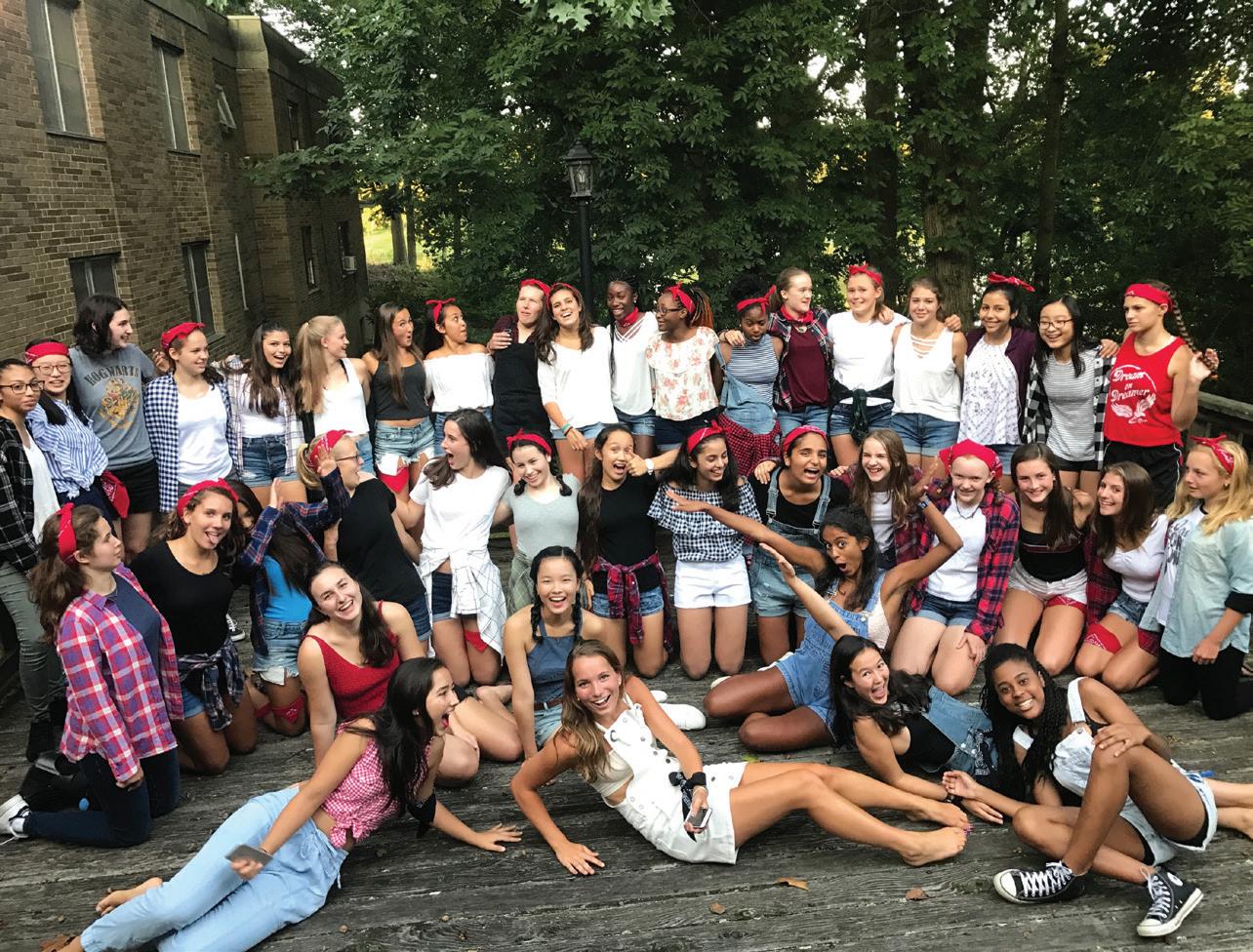
OUR ALCOHOL & DRUG POLICY
“Policy” isn’t really the right word—we all embrace our substance-free culture, and students, more than adults, should be given the credit for protecting and keeping this culture alive. There is no place for alcohol, drug or tobacco use at St. Andrew’s. We believe that alcohol and drug use threatens the fundamental process of adolescent development and changes who you are as a person—it changes the way you think, the way you concentrate, the way you act, the way you treat others, the way you confront and overcome adversity.
Our students appreciate that we expect them to live at a certain standard. We expect that they are going to value an environment that is drug- and alcohol-free. Part of doing that is giving students the opportunity to see how much fun can actually be had without the pressures of drugs and alcohol. They buy into it, and once you set a culture for that, it sort of feeds itself. Freshmen come in and the seniors and juniors are living out that culture in front of them, and so it just becomes what you do. There’s an expectation that what you experience here isn’t just for you— it’s for the next person.
STACEY DUPREY CO-DEAN OF RESIDENTIAL LIFE
45
Caring for Your Community
We believe that students should serve others because they want to—not because they are required to do so.
This is why St. Andrew’s does not have a community service requirement; all student service work is voluntary. We want our students to focus on the lives they are affecting through their service, not “hours earned.” We offer opportunities to get involved in service on the local, regional, national, and international level. We set aside Wednesday lunch each week as a time to participate in service, but opportunities to serve occur throughout the week and on weekends, too.
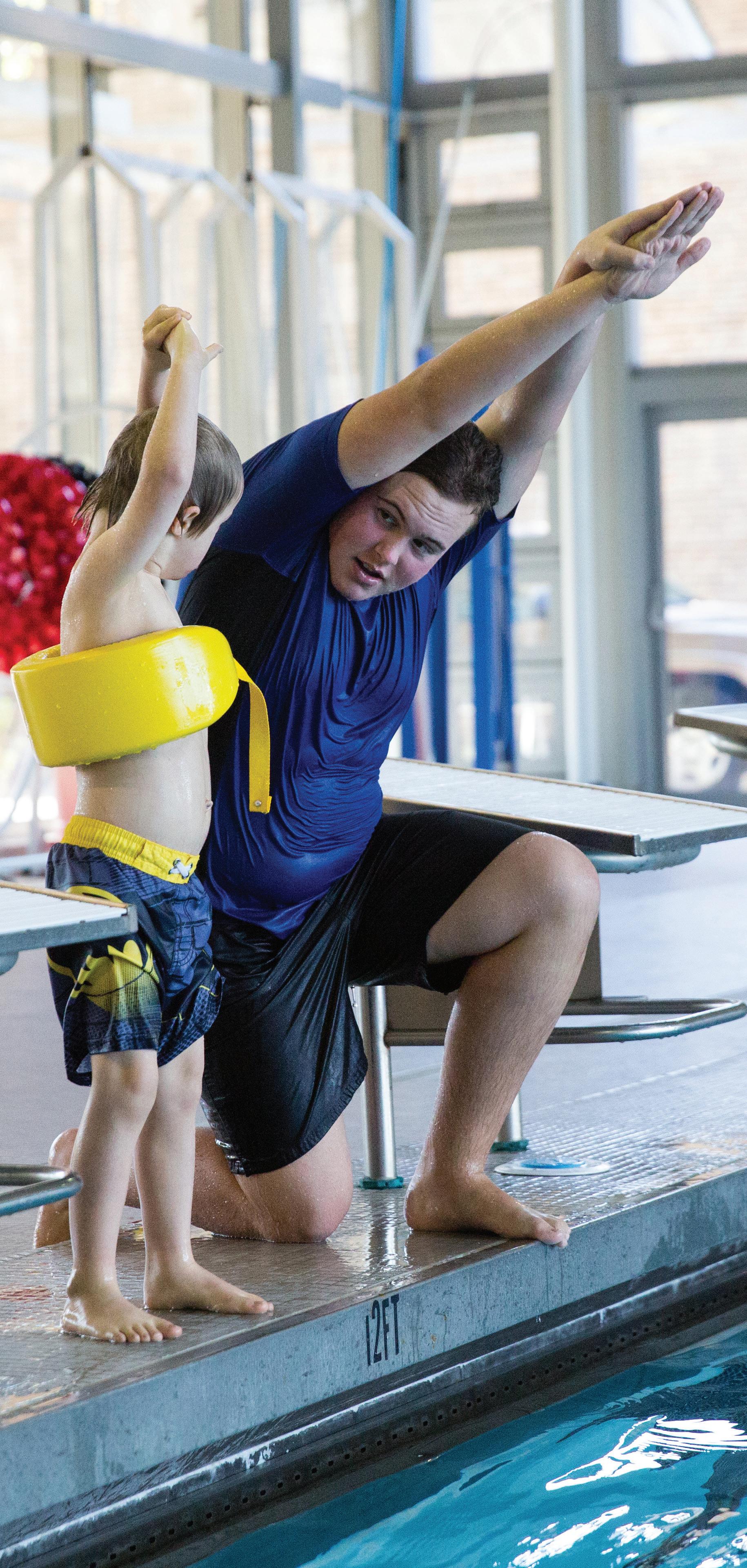
46
We believe that all members of our community share responsibility for improving the world in which we live.
Just going and doing service, say, forty minutes a week—that’s not really what we’re talking about in our mission statement. What we’re talking about is having a heart that is oriented toward serving other people.
CHAPLAIN JAY HUTCHINSON QUICK FACT
More than 70% of our students regularly participate in service.
A FEW WAYS TO SERVE AT ST. ANDREW’S
Get to know a senior citizen through weekly visits to a local senior center for games, baking, and conversation
Mentor a local elementary school student
Give swim lessons to children with disabilities in the Genereaux Aquatic Center
Join in our weekly Friday night trips to local food pantries & homeless shelters in Wilmington, where you’ll serve and eat dinner with residents
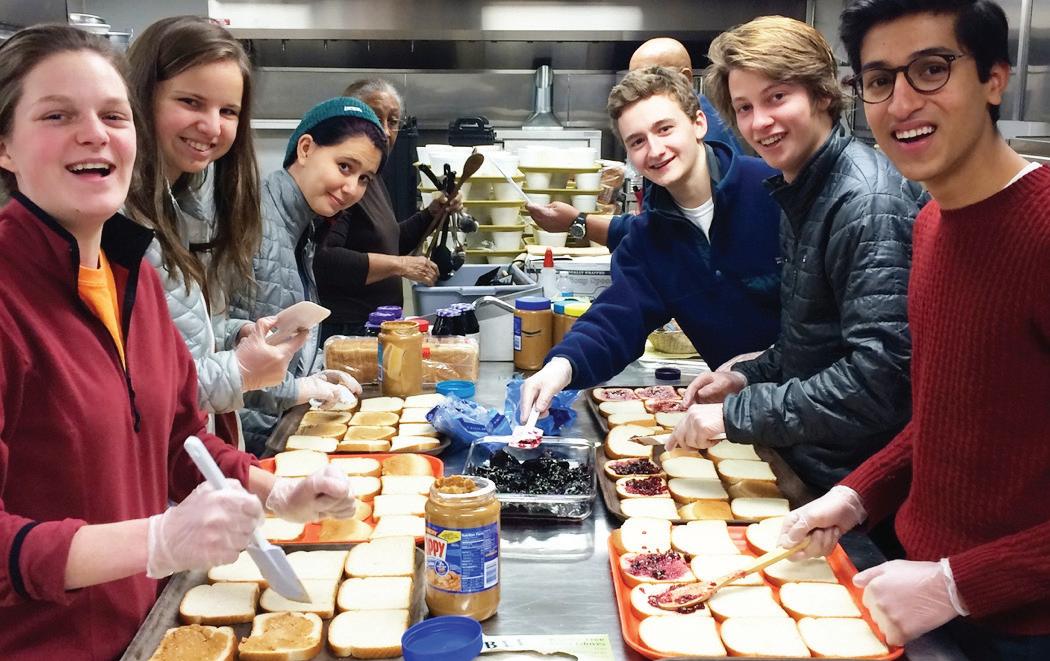


Volunteer for Delaware Special Olympics events, held both on and off campus throughout the year
Build local Habitat for Humanity homes
Serve meals at a local soup kitchen
Ring a bell for the Salvation Army during the holidays
Pitch in at the Veterans Resilience Center right in town

Organize blood drives, clothing drives, food drives, and fundraisers
Clean up trash on local roadways
47
STRETCH YOURSELF


Josie is developing her green thumb in the SAS Organic Garden.
“Harvesting something that you’ve planted, watered, and taken care of is the best feeling in the world!”
MEET Josie Pitt
CHARLOTTE, NC VI FORM STUDENT
Josie’s thoughts on...
OUR CULTURE OF KINDNESS
Move-In Day was a blur of excitement. I remember that Sallie England ’21 ran to our car to carry my things, and Isabel Hwang ’20 wouldn’t stop helping me unpack until everything was put away. This was my first example of the amazing culture at SAS
OPENING UP TO OTHERS
On Pell we have “Wisdom Wednesdays”—either a senior or a faculty member comes to freshman girls dorm and shares an important experience they’ve had at St. Andrew’s. We all sit around in the common room in our pajamas after a full day of classes, sports, chapel, and study hall. Everyone that’s spoken at Wisdom Wednesday has been vulnerable and has opened up about their lives. It’s reassuring to hear people’s mistakes and how they’ve grown from them.

HITTING THE TRAILS

Being a member of the cross-country team was amazing. Since SAS has over 2,000 acres of trails, running was always an adventure. It was my escape from our busy day-to-day life at St. Andrew’s. As a team, we were by each others’ sides, even through the worst workouts and the hardest races, and it was incredible to see how we all improved as athletes.

WHEN SAS FIRST FELT LIKE HOME
My first weekend at school—my advisory had a joint advisory dinner with another advisory. We played spikeball, soccer, and helped cut watermelon, and the other advisor let his advisees cook the burgers. When we bit into them, they were so undercooked, and we just ate the edges of the burgers—not ideal, but it made us laugh and brought us all together. I go to the my advisor’s house often, and every time I go I am so thankful that I have adults on campus who care about me, who are there for me, who are always willing to lend an ear. I knew at that first advisory dinner that St. Andrew’s was home because of all the kindness that immediately surrounded me
Andrean Ensemble Basketball Crew Cross-Country Disciplinary Committee Environmental Stewards Organic Gardening
FAVE DINING HALL FOOD
The bagels at breakfast! Especially the everything bagels.
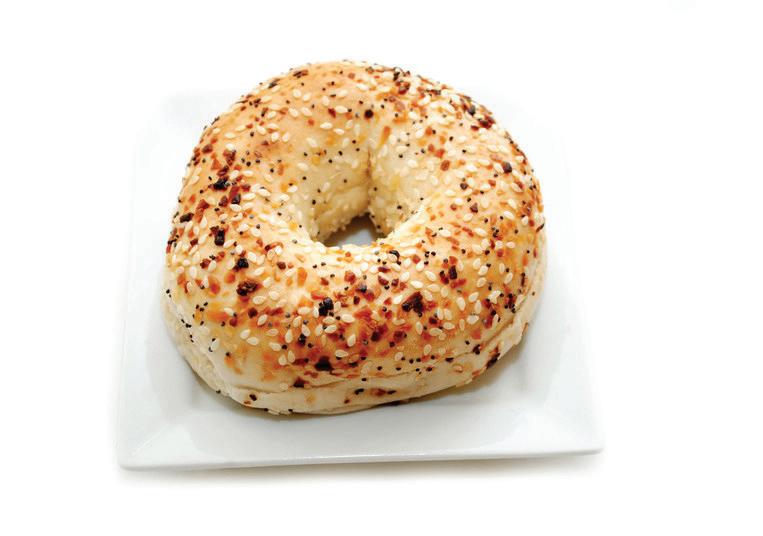
practice days, game days, and leaving it all on the field
You’ll bring the leadership, self-confidence, and responsibility you develop “on the field” to everywhere else you learn and live at St. Andrew’s—and beyond.
50
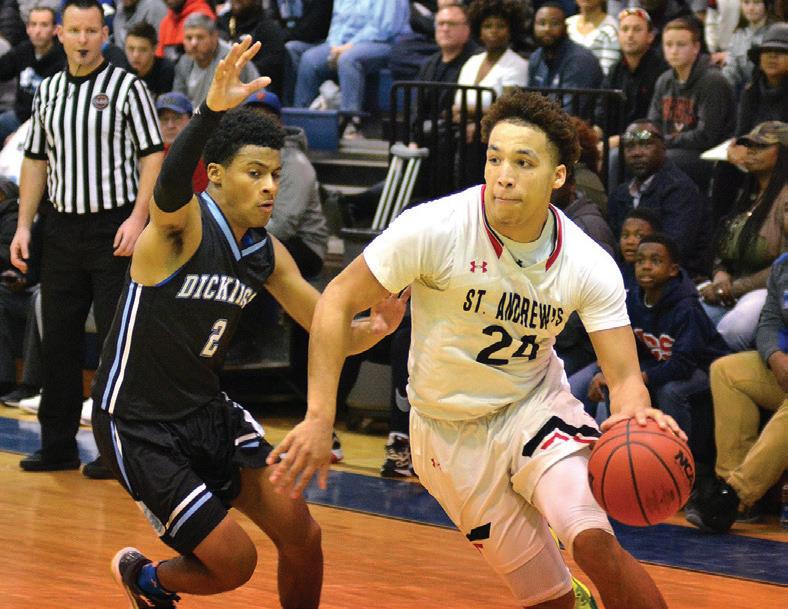

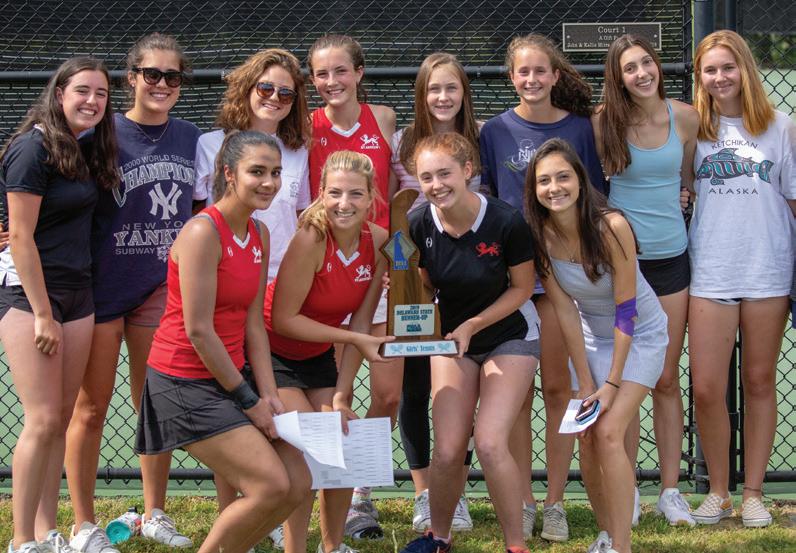

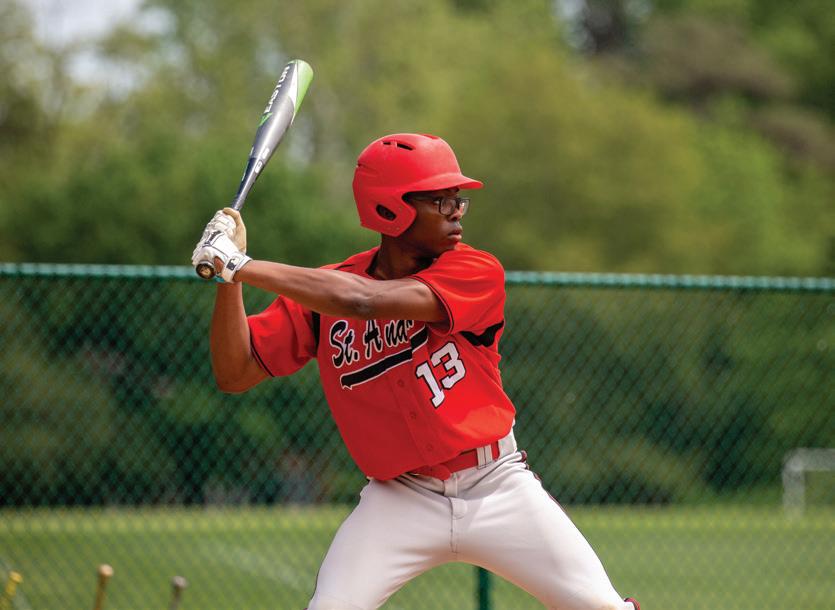

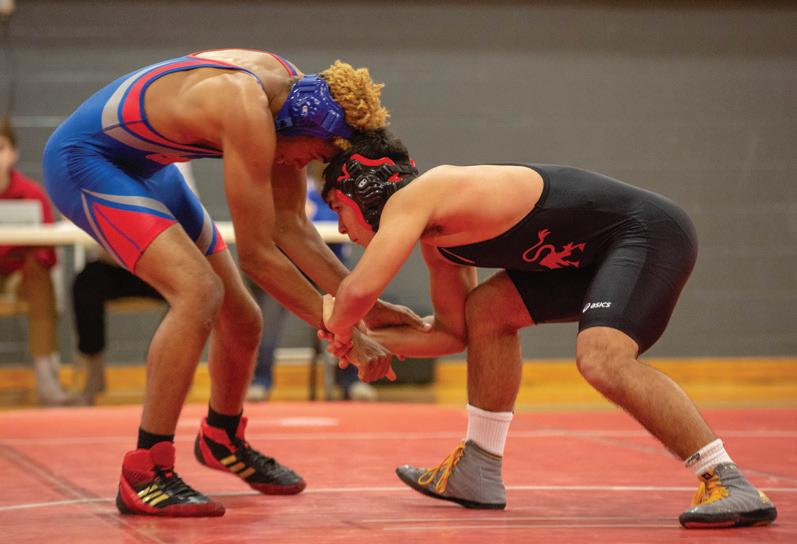
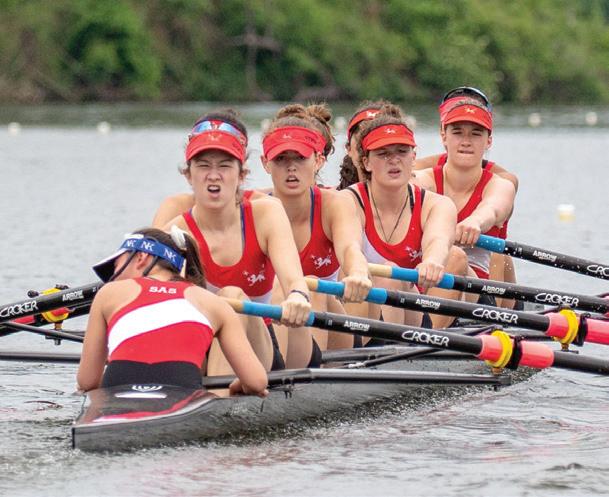

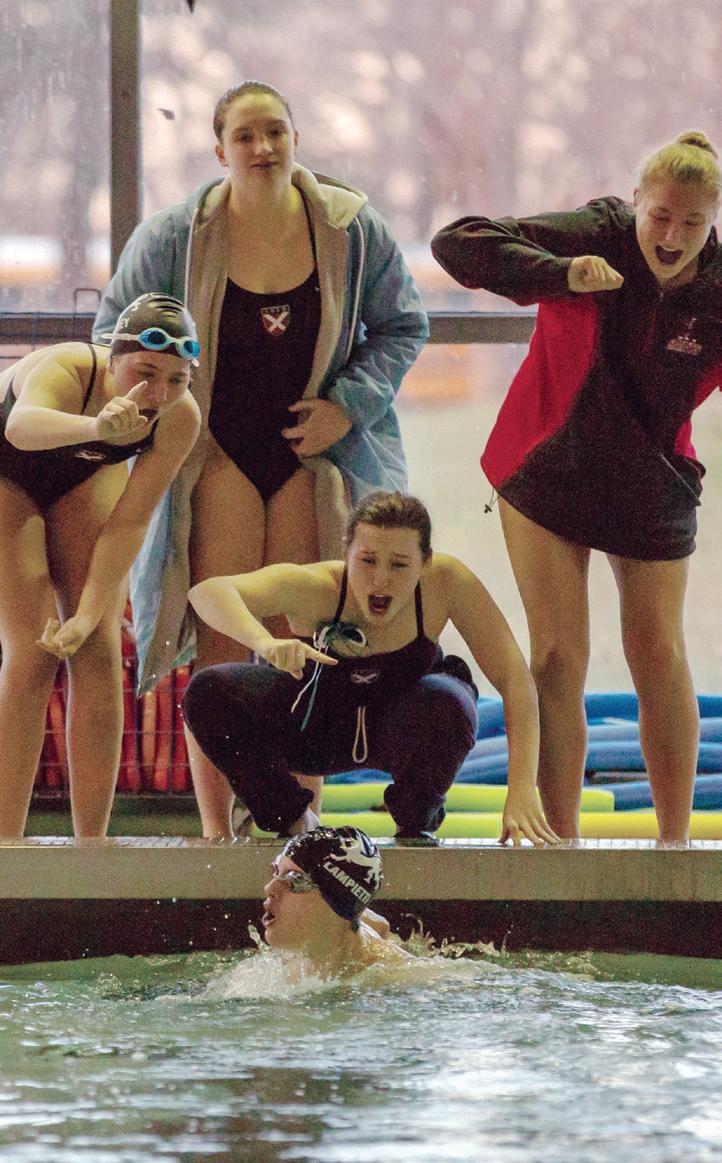
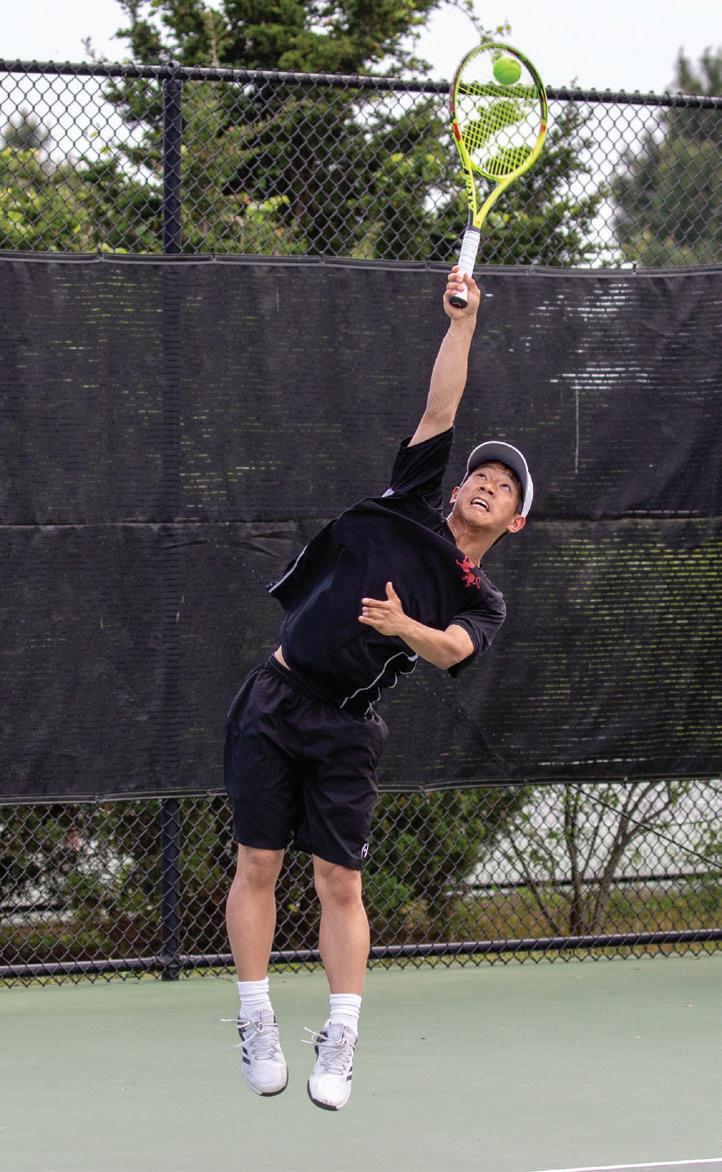

Core Values of SAS Athletics DISCIPLINE • RESPECT • TEAMWORK • SPORTSMANSHIP • ACCOUNTABILITY • TRUST • GRIT • “ALL-IN” ATTITUDE •
If you are a student-athlete seeking:
... highly personalized coaching that will both challenge and mentor you ... a team environment that is both competitive and supportive ... the chance to compete on the state and national level ... a program that will ask you to lean into discomfort and push yourself to new heights ... Saints athletics is the place for you

.
What does it mean to compete as a Saint? Being a Saint means you have made a commitment to yourself, your teammates, your coaches, and the school to be “all-in.” You show up every day with a growth mindset, focused, and committed. Being an athlete at St. Andrew’s will teach you habits of selfdiscipline, hard work, and resiliency, and give you tools to be successful at the next stage of competition and beyond the field of competition. Here, we all commit to a culture of excellence. This is what it means to be a Saint.
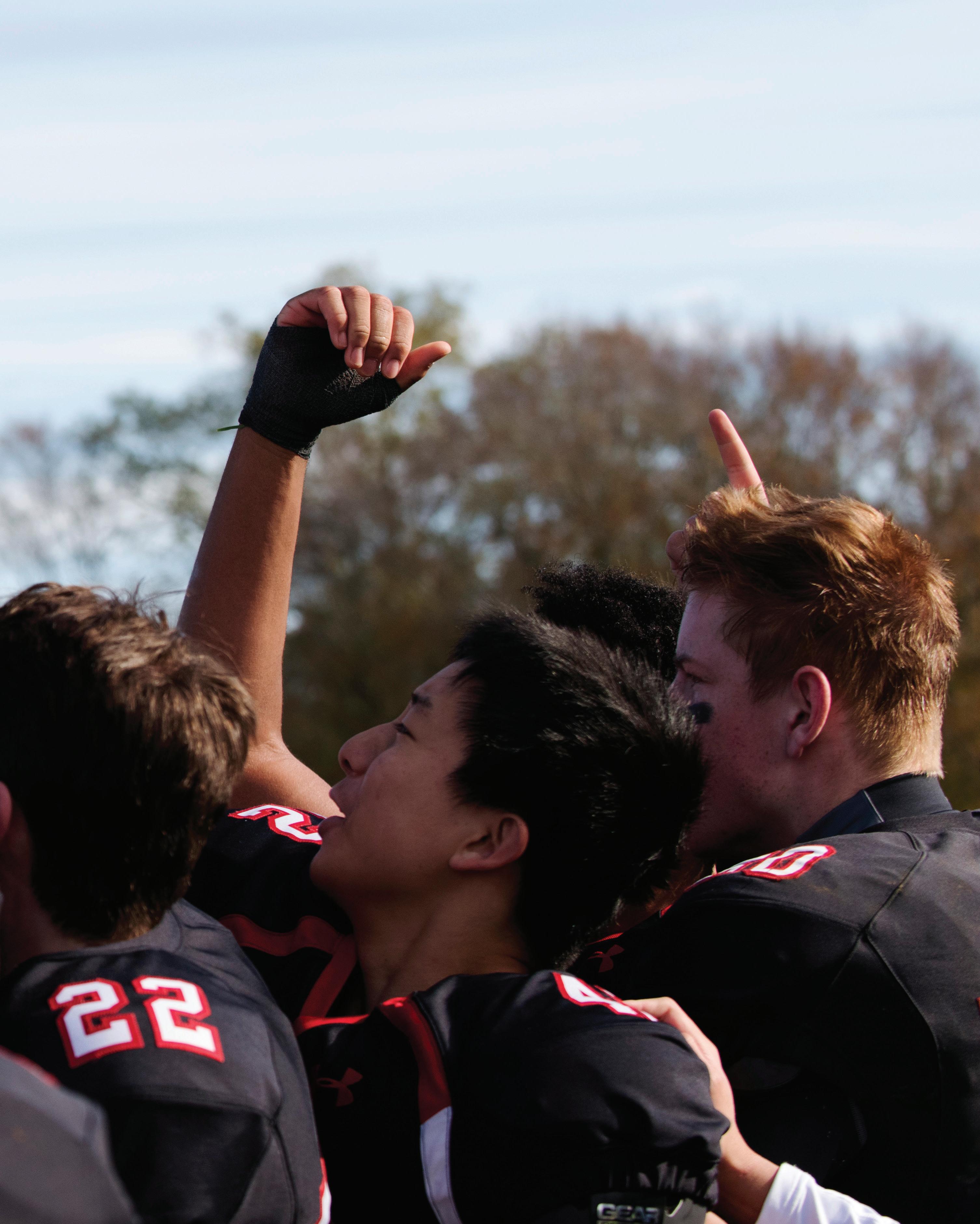 CUNNINGHAM DIRECTOR OF ATHLETICS
NEIL
CUNNINGHAM DIRECTOR OF ATHLETICS
NEIL
The Multi-Sport Athlete

The push toward specialization in sports has ignored the clear, short- and long-term benefits enjoyed by generations of successful multiple-sport athletes. Our student-athletes experience the benefit of transitioning to a new sport each season, while also having the space and guidance to pursue collegiate or national team goals. What our athletes find is that playing multiple sports—including in many cases a sport they’ve never tried before—gives them the opportunity to become more complete athletes with improved agility, balance, speed, decision-making abilities, and skills across all sports. Encouraging multiple sports also gives our studentathletes the chance to try new endeavors, become better leaders, connect with new teammates and coaches, and discover new avenues to personal growth.
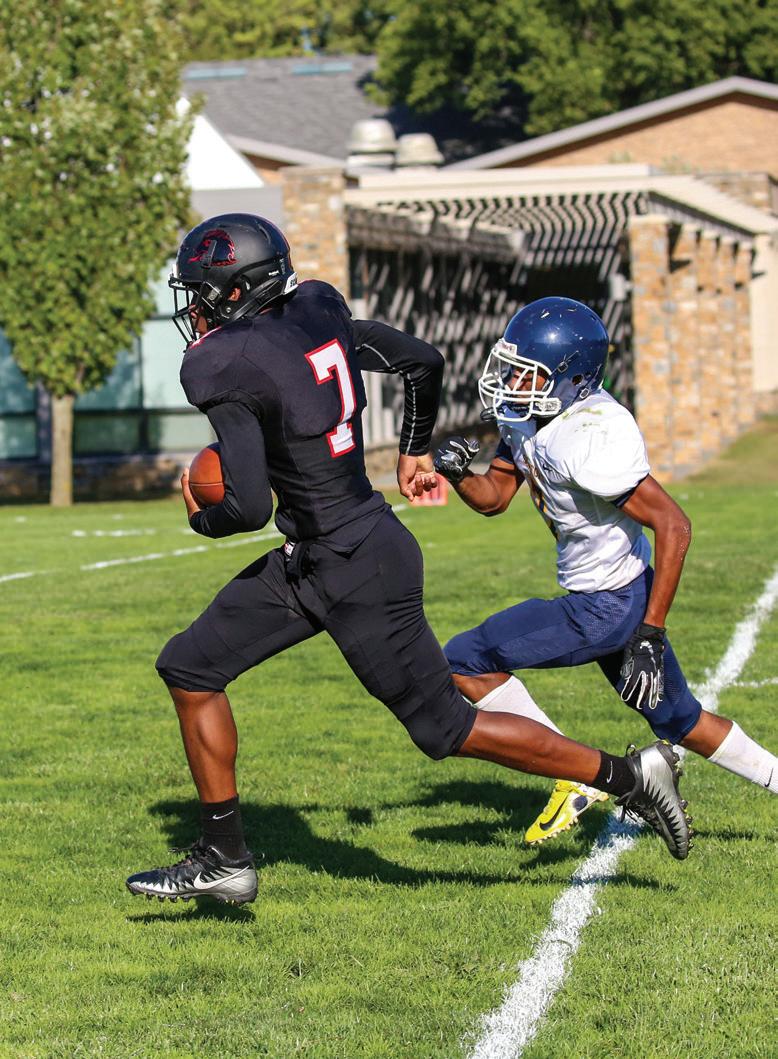
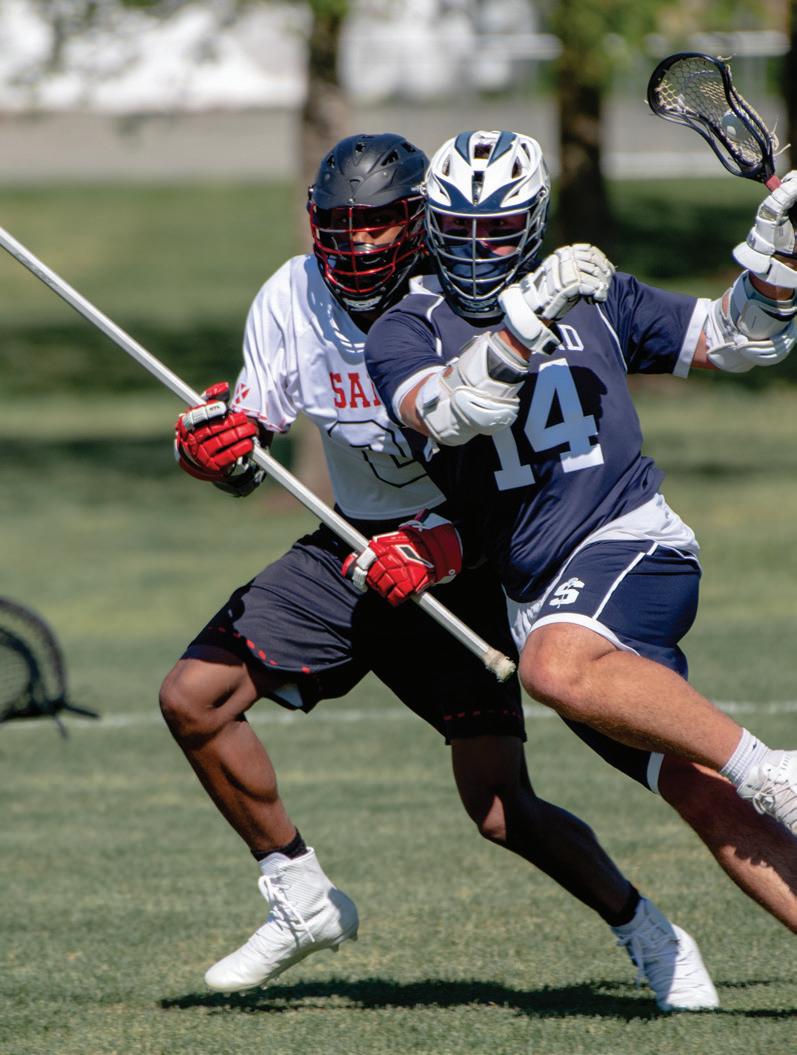
Playing three sports can definitely be hard sometimes, but you learn to manage your time and how to balance your work life and your sports life. But I really think it’s worth it—you get to meet new people, try new things, and it can be a path to college athletics.
Baseball
54
’22 DELAWARE Our 22 Teams FALL WINTER SPRING Cross-Country (BOYS & GIRLS) Field Hockey Football Soccer (BOYS) Volleyball Basketball (BOYS & GIRLS) Indoor Track
(BOYS & GIRLS)
(BOYS & GIRLS)
BRANDON GRAVES
Squash
Swimming
Wrestling
Crew (BOYS & GIRLS) Lacrosse (BOYS & GIRLS) Soccer (GIRLS) Tennis (BOYS & GIRLS)
St. Andrew’s competes in the Delaware Independent School Conference.
teams with head coaches who were college or professional athletes (5 have also coached at the collegiate level)
1 in 4
coaches have received conference or statewide Coach of the Year honors in the past decade
state tournament appearances over the past 10 years
QUICK FACT
More than half of graduating seniors identify an athletics moment or team when asked to name a highlight of their time at St. Andrew’s.
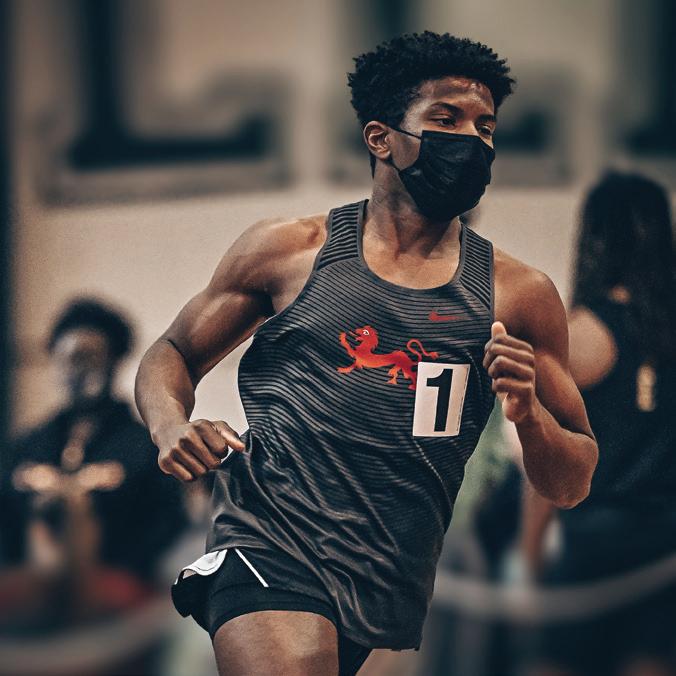

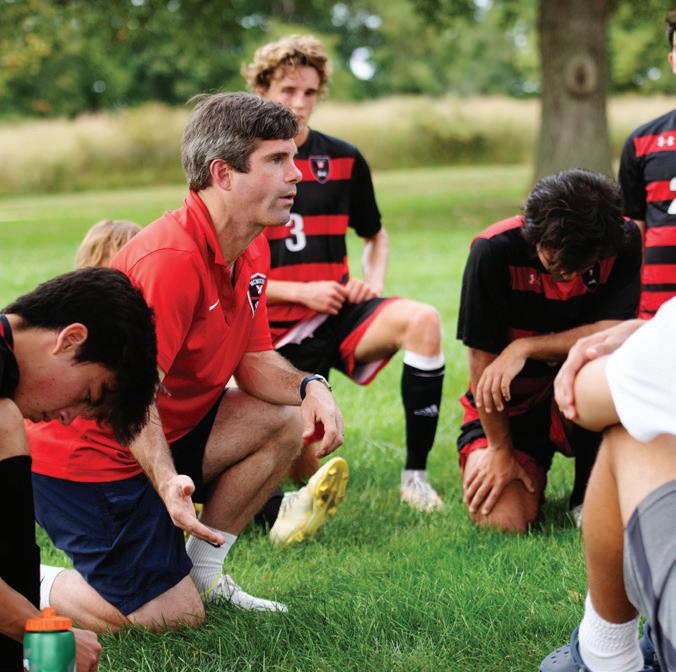

students receive All-Conference honors each year, on average
138
conference championships in school history
My experience here has taught me how to be resilient when faced with hardships, and that a positive attitude and a smile can make any rowing practice a little bit easier. I always loved being a part of my teams here, and I am so sad to be leaving, but I am so excited to bring the energy to college rowing.
CLEO RAY ’22
55
18
9
72
DELAWARE
Meet A Few of Our Coaches...
Jenny Carroll, Girls Lacrosse
During Coach Carroll’s tenure, Saints girls lacrosse has qualified for five state tournaments and has an overall record of 71-33. Coach Carroll was recognized for her work with and development of the St. Andrew’s program in 2012, when she was named Delaware Girls Lacrosse Coach of the Year.

Coach Carroll was a four-year starting midfielder for the Hamilton College women’s lacrosse team, helping her squad to two NCAA tournament appearances and earning All-American honors. During her senior season, Coach Carroll captained a team that went 21-1 and won the 2008 NCAA National Championship.
foot bal l
Patrick Moffitt, Football

Coach Moffitt was a three-year starting quarterback for the Williams College football team. Over those three seasons (2008-2011), he led Williams to a 20-4 record, including a perfect 8-0 mark and NESCAC Championship as a senior. He was also named New England College Football Player of the Year.
Coach Moffitt spent three years coaching football at Norwich University, where he oversaw the quarterbacks and wide receivers, and helped guide Norwich to an ECAC bowl game in each of those three seasons.
aske tba
b
Terrell Myers, Basketball
l l
Coach Myers played guard for St. Joe’s University in Philadelphia from 1993 to 1997.
Following his stint at St. Joe’s, Coach Myers played professional basketball in Europe for more than ten years, including six in the British Basketball League, where he was a four-time All-Star and the 1998-99 BBL Player of the Year.

& A Few of Our Student Athletes
Even as a young athlete, you can be put into a leadership role at St. Andrew’s, and that’s something that I hadn’t expected. Coming here to a small school, everybody—seniors, juniors, sophomores, and freshmen—they’re all playing and that’s something that I really like.
PHIN HUNT ’22 MIDDLEBURY COLLEGE
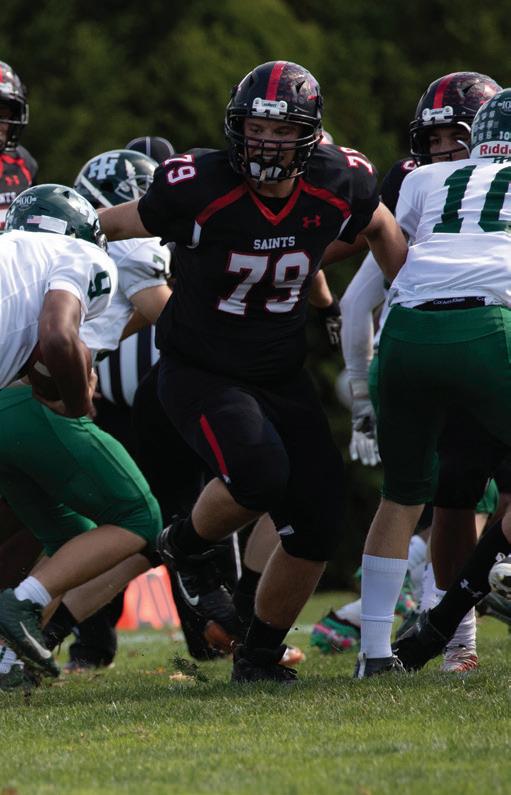

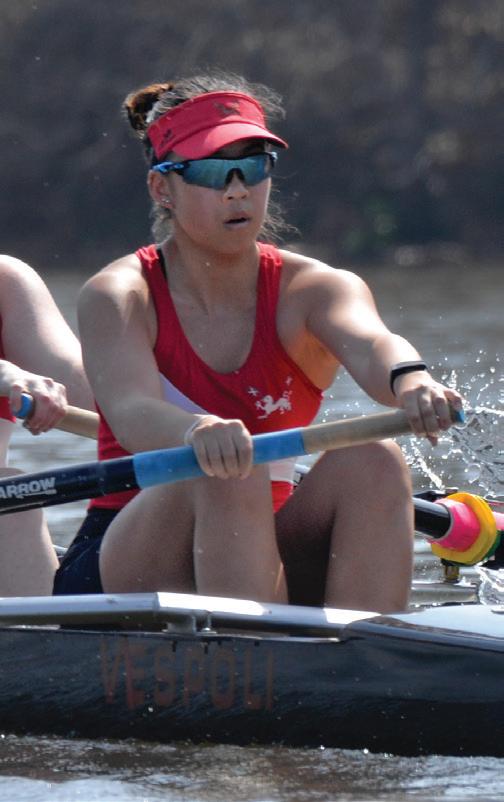

Rowing is unlike any other sport. If one person messes up, the whole boat is affected, but if you collectively work together and are never off, you feel the power. Coach Berl talks a lot about showing kindness towards each other, which creates this safe community, and she emphasizes really intricate technique. At the same time, we’re also pushing ourselves to be competitive with each other and to go deeper and harder each practice. The atmosphere she’s created allows us to do that.
CHRISTINE WU ’20 DARTMOUTH COLLEGE
Running crosscountry with Coach Carroll opened my eyes to see that I had the ability to push myself further than I knew. The team was a space where I was able to push out of my comfort zone and feel supported by everyone on the team every step of the way. I was also able to give that support back to my teammates as we all watched each other grow and become stronger athletes.
Being on the football team in the fall pushed me to my physical limits and helped me to access tenacity and grit I never knew I had. And being on the lacrosse team in the spring showed me the power a truly supportive team can have on its own success. My teammates made me a better person and athlete through their example.
NICK OXNAM ’22 UNIVERSITY OF VIRGINIA
Get the inside scoop on Saints athletics by searching #SAStogether on Instagram and Facebook, and by following @sas_athletics on Instagram.
57
EMILY BOYER ’21 UNITED STATES MILITARY ACADEMY AT WEST POINT
Tour Our Athletic Facilities
OUTDOOR
• Six miles of cross-country trails
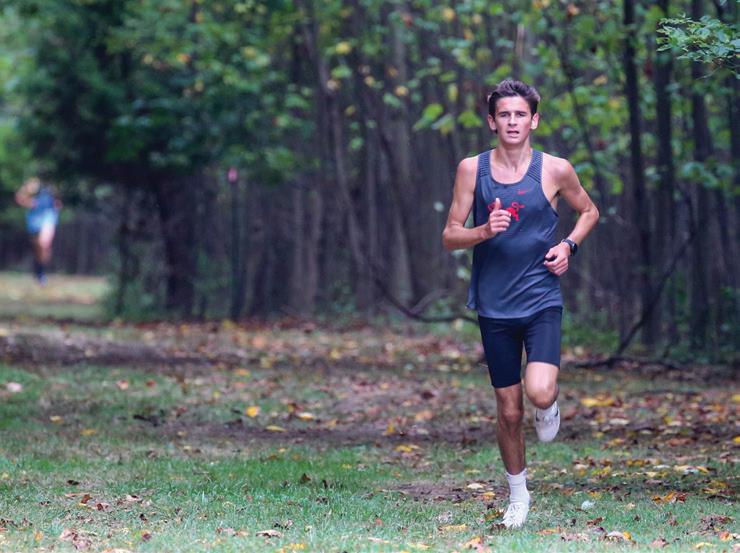
• Five soccer fields
• Four lacrosse fields
• Two field hockey fields
• Two baseball diamonds
• Practice and game football fields

• 11 tennis courts

My favorite place at SAS is the athletic center and the fields that surround it. I’m reminded of how amazing our facilities are every time
I walk into the gym.
NICK LILLEY ’21 MARYLAND
INDOOR
Sipprelle Field House
(LEED Gold-Certified)
• Three basketball/volleyball courts
• Indoor track
• Performance studio & weight room
• Cardiovascular fitness room
• Sports medicine & rehab center
• Locker rooms for all teams, plus faculty William H. Cameron

Gymnasium
• Nine international squash courts
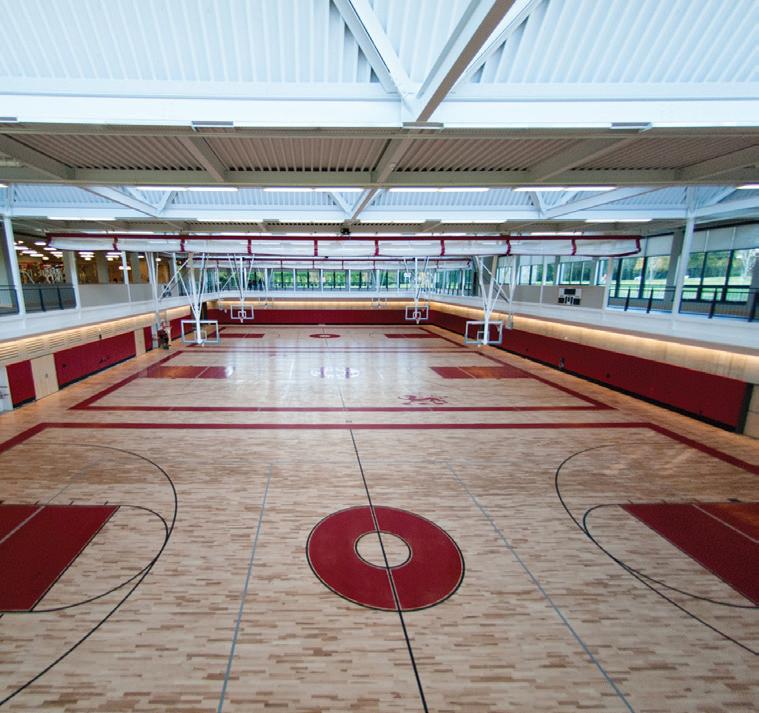
• Basketball court
• 2,800-square foot wrestling room
• 3,000-square foot dance studio
Genereaux
Aquatic Center
• Six-lane, 25-yard swimming pool
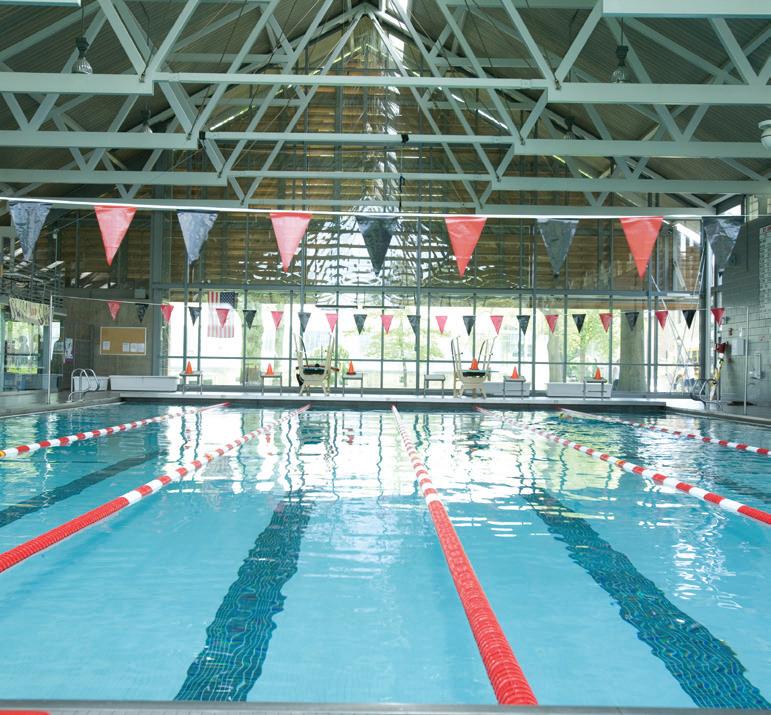
Kip duPont Boat House
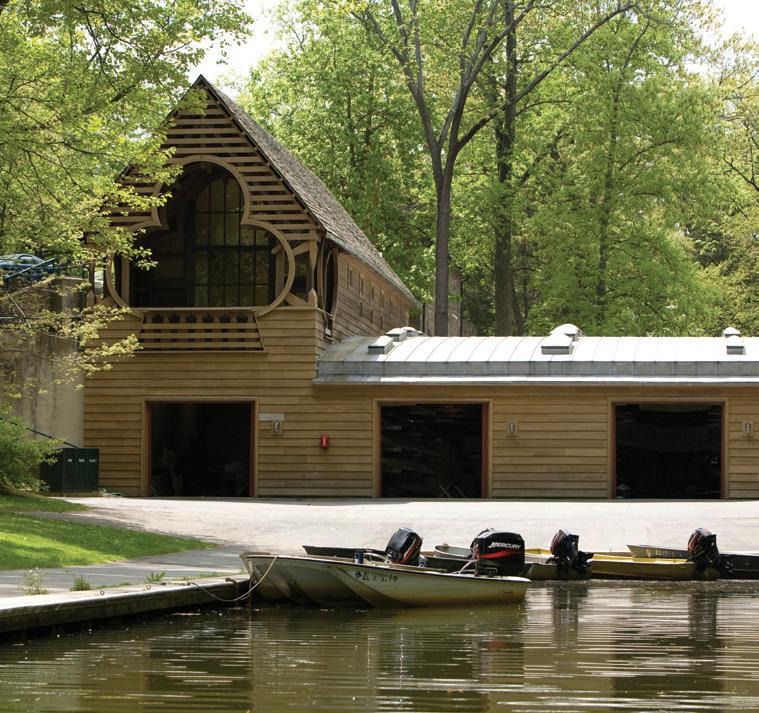

• Three boat bays
• Ergometer training room
1,500 meter, six-lane crew course on Noxontown Pond
Genereaux Aquatic Center
Kip duPont Boat House
Durkin Fleischer Squash Center
Sipprelle Field House
STRETCH YOURSELF
“When I came to SAS I started going to the Polar Bear Plunges—students jump in the pond when the water is freezing. Now, as a senior, I get to be a Polar Bear Papa!”

MEET Ike Lawrence
BALTIMORE, MD VI FORM STUDENT
Ike’s thoughts on...
WHEN SAS FIRST FELT LIKE HOME
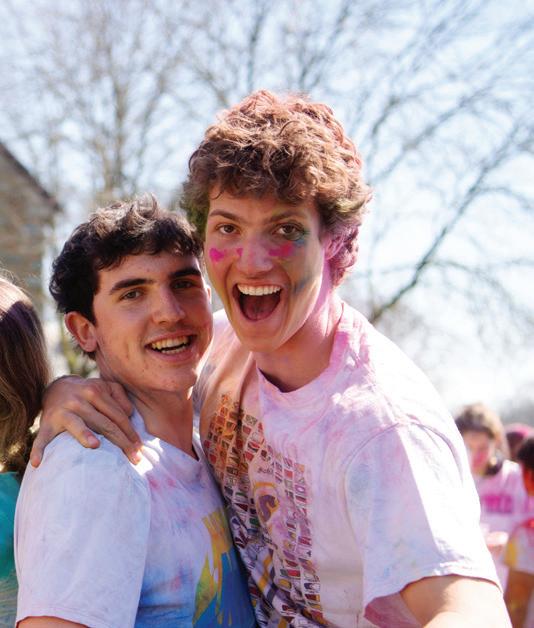
First day of my sophomore year. I was a new sophomore, and COVID restrictions were in full force, making everything much harder to navigate. I was the only new kid on my dorm and I was sitting in my room, contemplating if transferring to boarding school had been the right move, when some kids passed by my door and asked if I wanted to go outside I agreed and joined the group for a stroll around campus. The rest is history and those random guys are now my closest friends
CLASSROOM LIFE
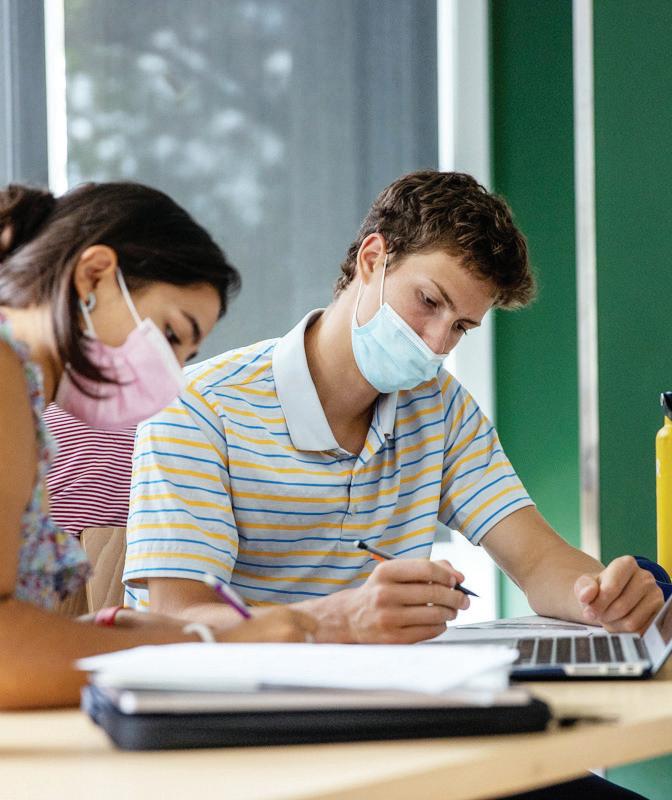

My English 3 class with Dr. Pitts challenged me but also invigorated my love for learning. Every class held something new, and the free-flowing nature of our discussions led to many moments of realization, comedy, and connection. Dr. Pitts pushed the entire class in many ways, from concise pointed writing to supporting our discussion comments with text citations. By the end of the year I was truly a better writer and a more inquisitive person. Dr. Pitts is awesome—I especially love her willingness to have class outside!
COMPETING AS A SAINT
The boys soccer team has had a huge impact on me as a person. During my junior season I forged a brotherhood with my teammates that I will cherish forever. Every day we pushed each other to the max, and with an outstanding coaching staff and strong team we were able to advance to the state final, falling just short of the championship. Even with this disappointment, I gained a family and experienced the beauty of being a part of something bigger than myself. I will never forget this. SAS athletics gives you the tools to become a far better athlete and compete at the highest scholastic level.
HOW WE BOND
A moment that stands out to me from my junior year was the night before we left for winter vacation. The Sherwood quad was always lively, and the holiday tone was set—we had secured our own Christmas tree, decorated with various objects found around campus, and we set the LEDs to a nice green and red. My roommate Ben finished the facade with a YouTube fireplace and Christmas music on the speaker. This was a special moment, and it made me reflect on how much I love my school and the people who surround me
Form Council
Residential Leader
Soccer Crew Andrean Ensemble Noxontones
Theatre
61
FAVE DINING HALL FOOD Smashed Cookies!
a life full of color
We believe in the exploration of the unexpected.
We believe in turning your perspective upside-down and inside-out.
We believe in failure as a pathway to success.
62
We believe that work in the arts will help you develop a more creative approach to problem solving (in all areas of life) and expand your capacity for empathy.

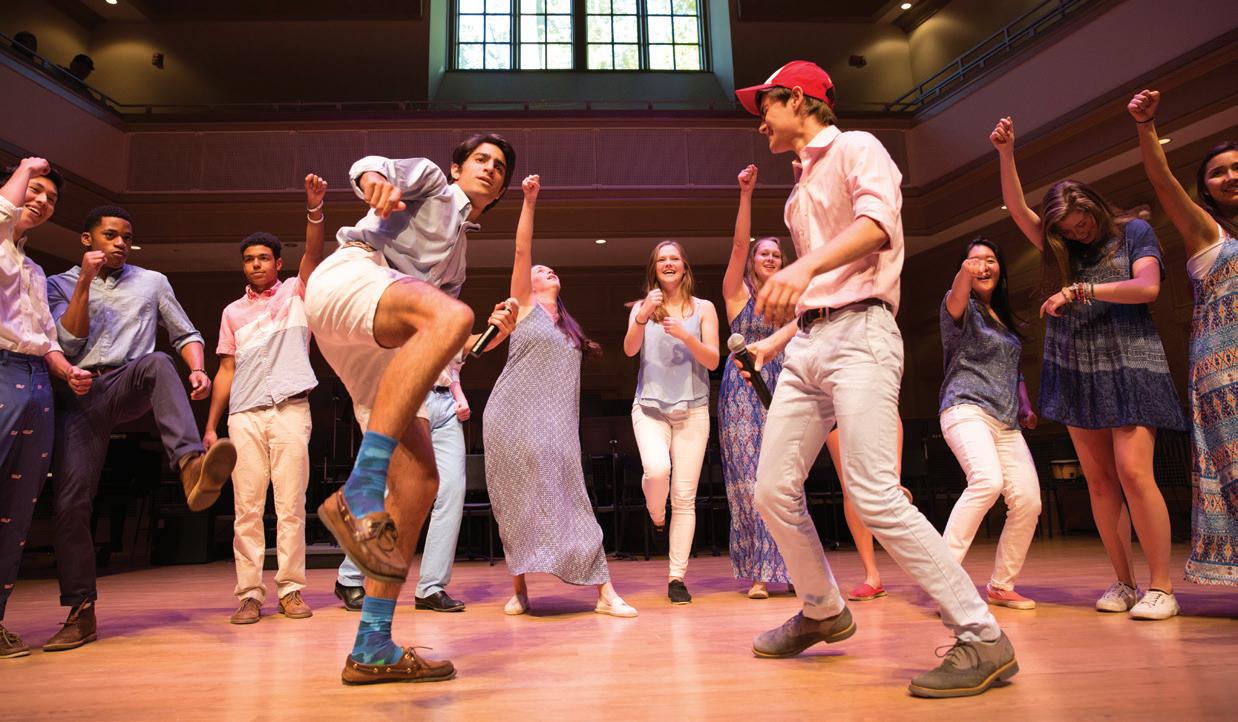

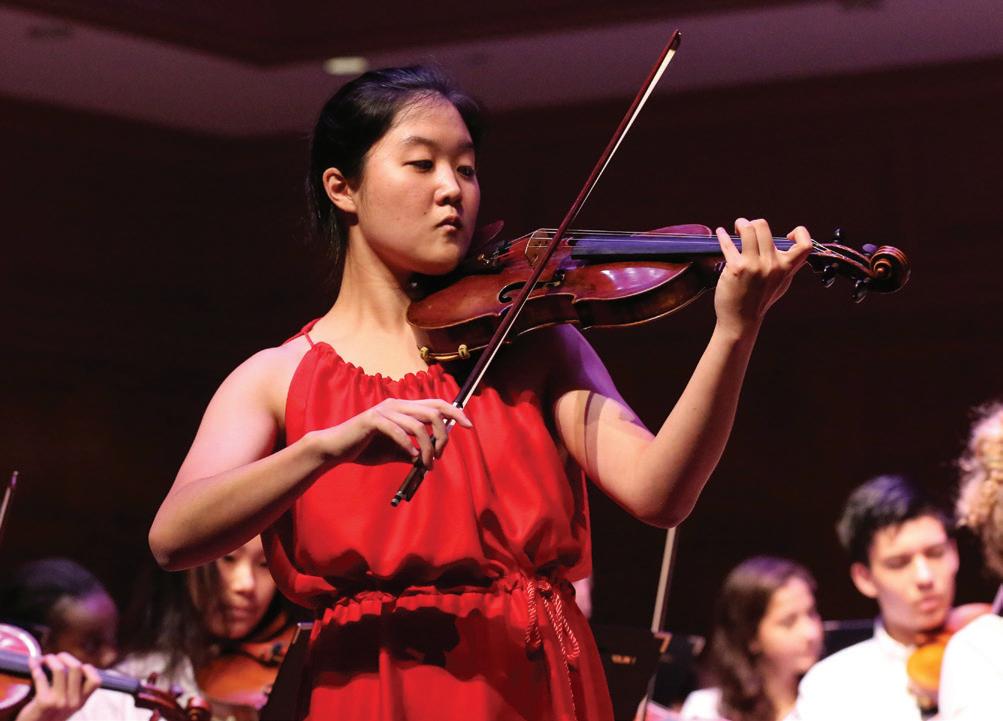
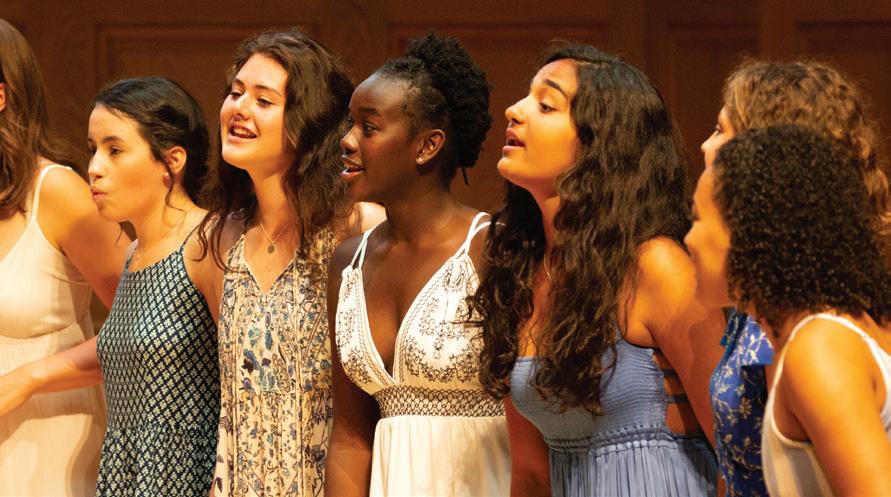
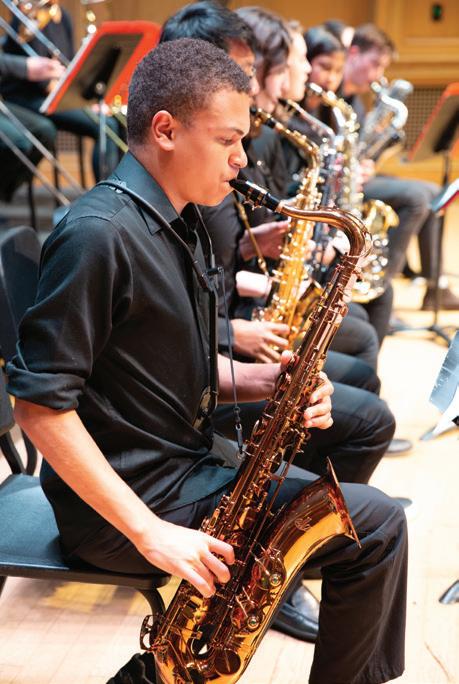
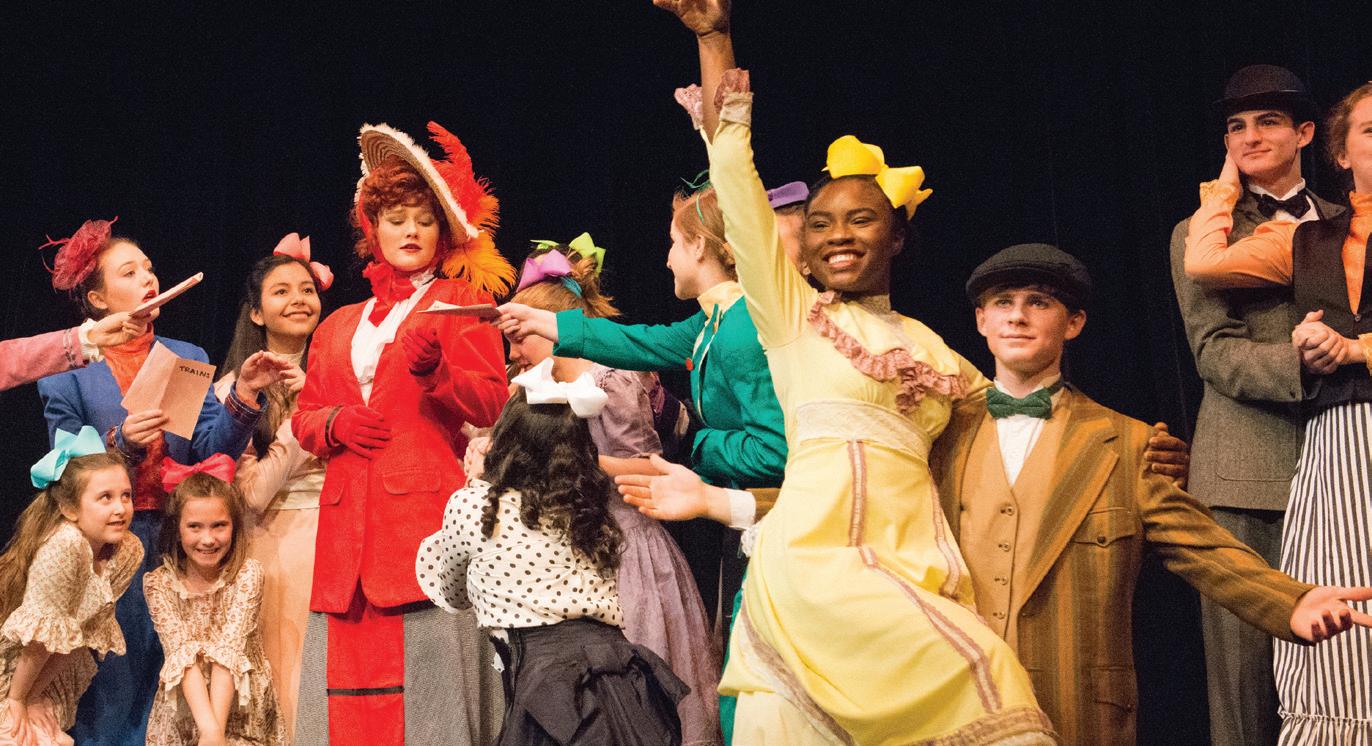
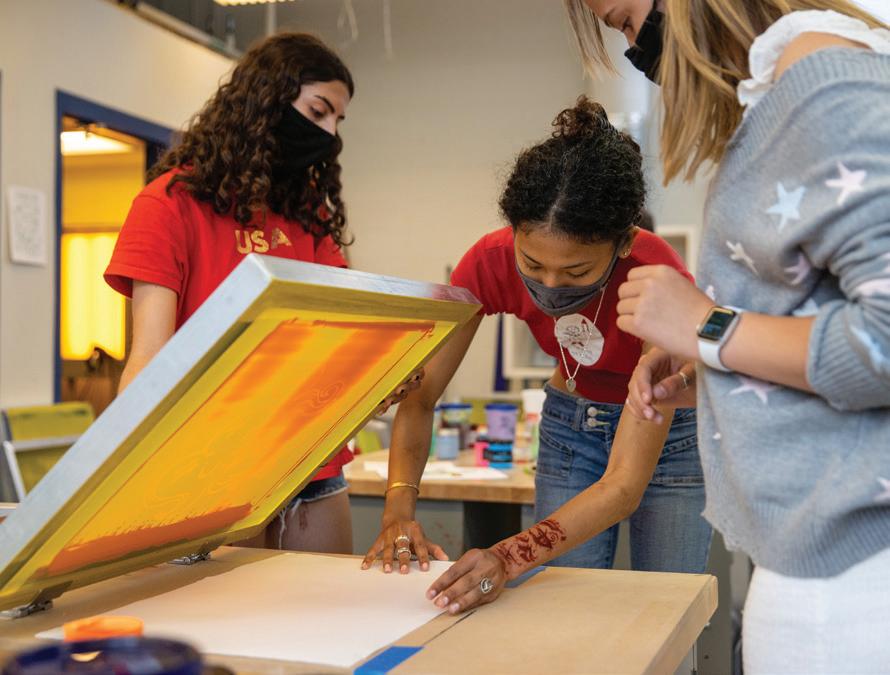

WE BELIEVE
... that everyone is an artist, and has a creative voice to share. That’s why every single student takes part in some aspect of our arts program. For you, that might mean being a member of the tech crew for the spring play, or participating in afternoon dance in the fall, or taking any of our semesterlong arts electives (like Printmaking, Music Theory, or Intermediate Filmmaking Techniques, to name just a few!), or going all-in with an Art Major in your discipline of choice. LEARN MORE ABOUT OUR ARTS CURRICULUM & CLASSES www.standrews-de.org/arts

The Arts in Action
EACH YEAR, OUR ARTS PROGRAM PRODUCES:

• 4 theatre productions
Recent productions include: Mamma Mia!, Everybody, The Addams Family, Sense & Sensibility, Catch Me if You Can, 12 Angry Jurors, Hello Dolly, Antigone, The Drowsy Chaperone, Radium Girls, The Crucible, Into the Woods
• 2 student shows in the Warner Gallery (which also hosts shows by visiting artists)
• 4 Orchestra concerts
• 4 Jazz Ensemble concerts
• 4 dance performances
• 2 student film screenings
• More Andrean Ensemble & Noxontones performances than we can count! These groups each give major performances throughout the year, and sing in Chapel and at School Meeting. The Andrean Ensemble also gives performances in concert halls around the country and world.

ARTS WEEKEND
Our three-day festival celebrating the arts at St. Andrew’s takes place each May, and features:
• dance, choral, and instrumental music performances
• theatre production
• student gallery show
• student film screening
• readings from The Andrean, St. Andrew’s literary journal
We also host similar arts exhibition weekends for students and their families in the fall and winter!
ART MAJORS
Students can choose to pursue an “art major” in their junior or senior year, and can major in dance, drawing & painting, film, music theory & composition, or photography. Art Majors take a yearlong course in their chosen discipline that requires extensive independent work and artistic production outside the classroom, with a goal of building an individual portfolio of ambitious original work.
The O’Brien Arts Center is the place where I discovered my passion for art and met some of my favorite mentors. The studio feels like a safe haven—a place I can go when I feel stressed, happy, down, or just creative.
66
SPENCER MCKENZIE ’20 MARYLAND
My favorite activity was the winter musical. Initially I was not comfortable with the idea of singing and dancing in front of an audience my freshman year. However, I left my comfort zone and pursued something that was new and exciting. After the first show, I was relieved that it was over, but I soon found a genuine enjoyment from performing on stage. I loved playing different characters and the feeling of accomplishment after each season.
DANTE SORIANO ’20 NEW JERSEY
Arts Facilities
O’BRIEN ARTS CENTER
Engelhard Hall, a 516-seat performance hall
Warner Gallery—a professional gallery space that houses four visiting artist exhibitions each year, as well as shows of student, faculty, and alumni work
A photography lab & dark room
Multiple visual arts studio spaces
Graphic design, film & music production labs
Rehearsal rooms for instrumental & orchestral music
Acting/dance/yoga studio
FORBES THEATRE
A technologically sophisticated dramatic production space, home to our theatre program, which puts on three plays, many acting class exhibitions, and a musical with a live pit orchestra each year

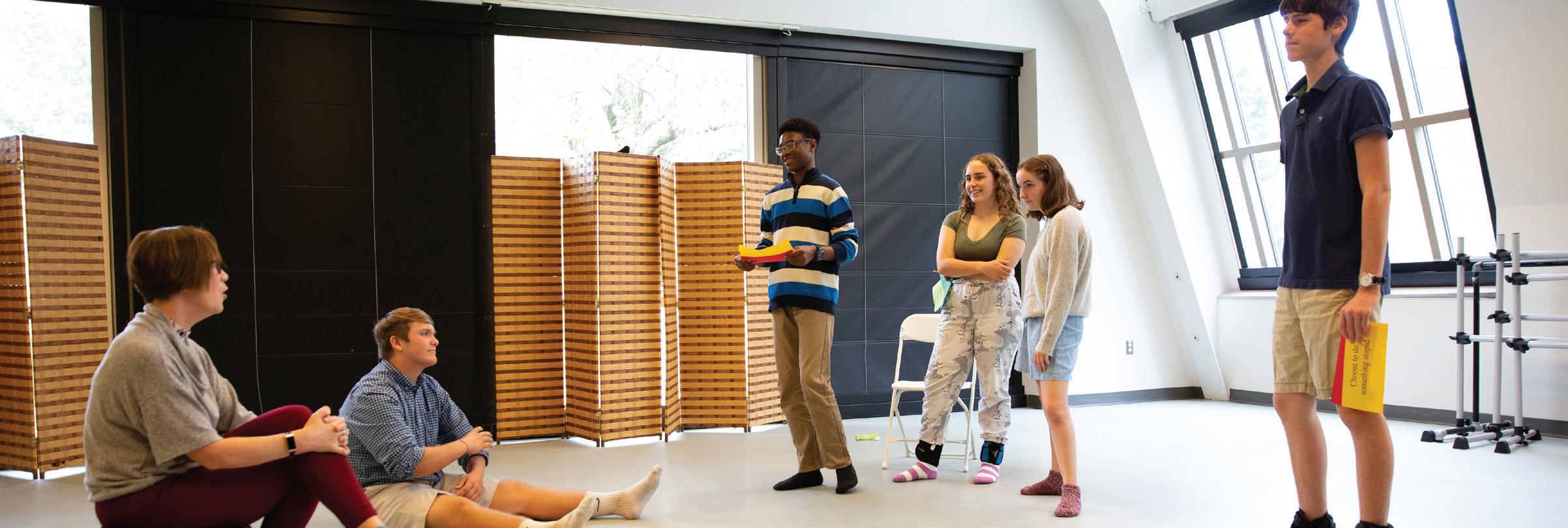
DANCE STUDIO
A 1,000 square-foot dance studio space with sprung flooring
In the Noxontones and the Andrean Ensemble, we are required to set aside our own personal motives and actively try to blend our voices with those around us. When this happens successfully, we are no longer individuals—we are one sound, one entity. To me this is the ultimate embodiment of the St. Andrew’s ethos: an agreement among members of a team to do our part to create a product we can all be proud of. We are all equally committed to one purpose. We lift each other up.
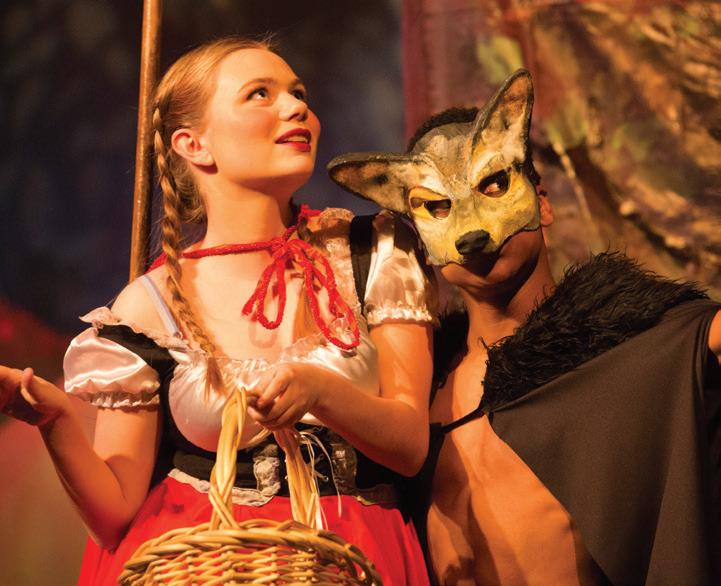

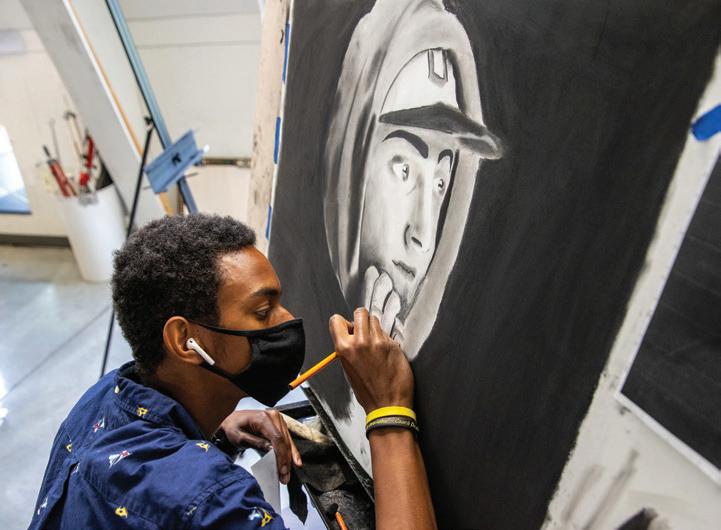



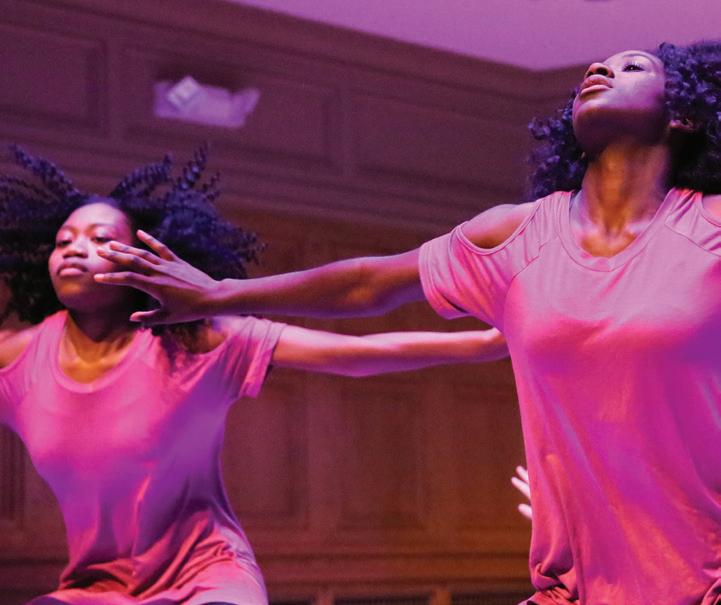
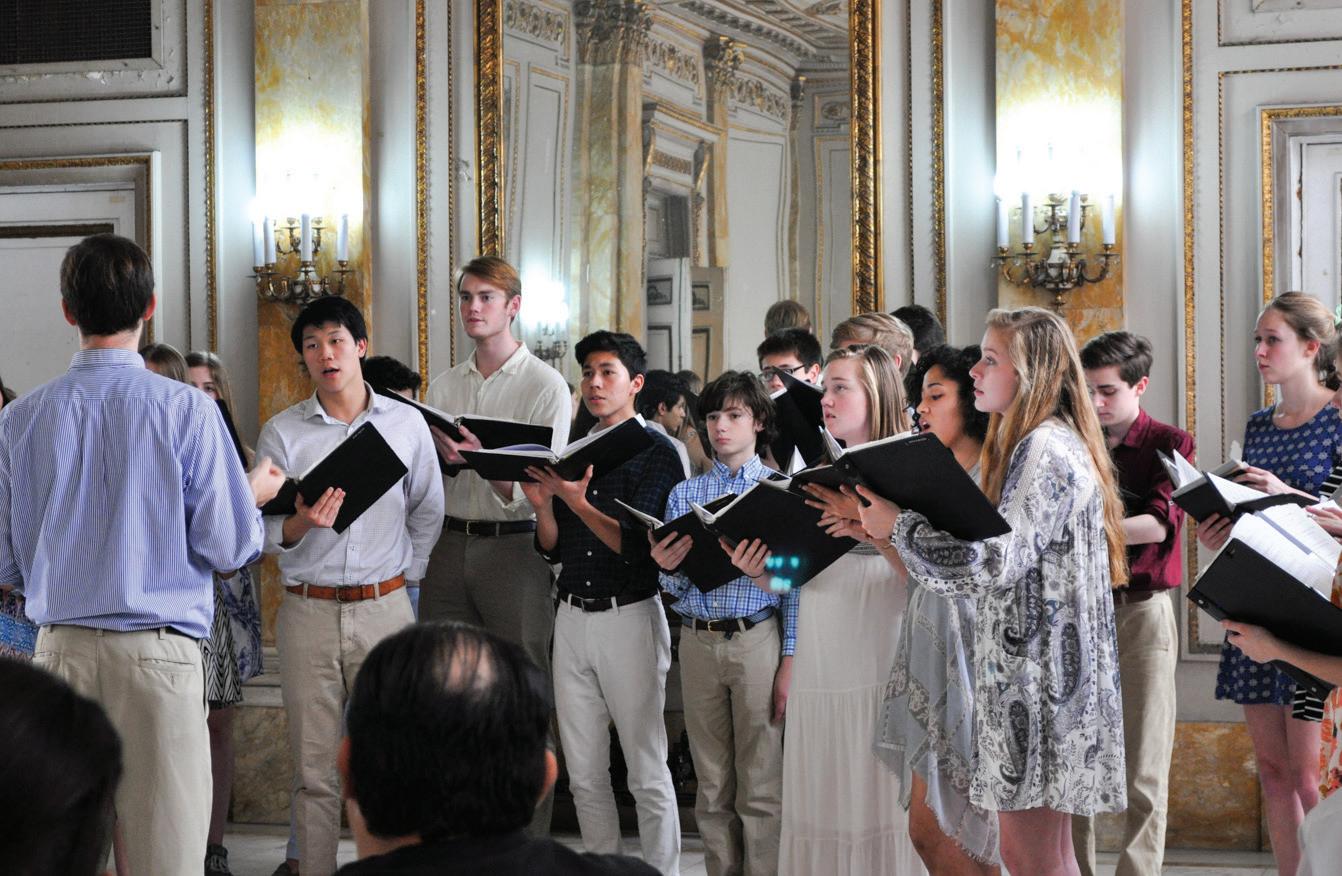 RHETT EDENS ’21 NORTH CAROLINA
RHETT EDENS ’21 NORTH CAROLINA
68
The Andrean Ensemble (our advanced choral music group) has performed everywhere from the White House to Havana, Cuba.
Instrumental music students take master classes each winter with internationally renowned musicians who visit campus through our Haroldson Music Program.

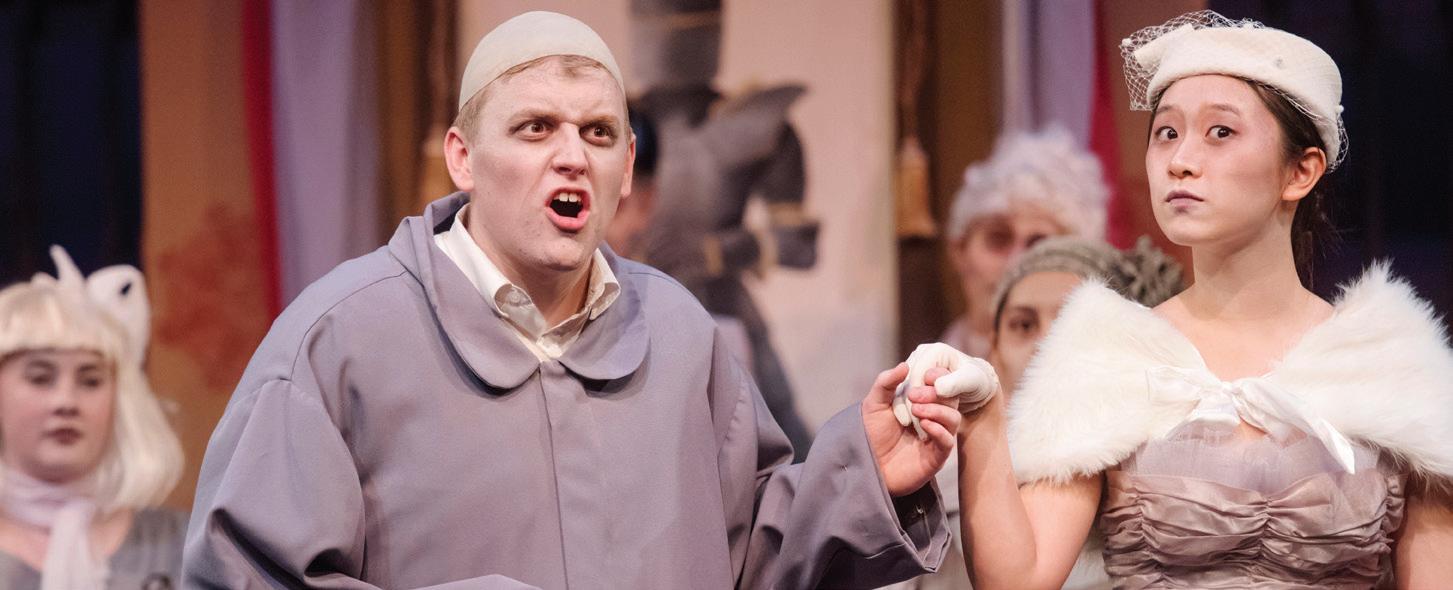

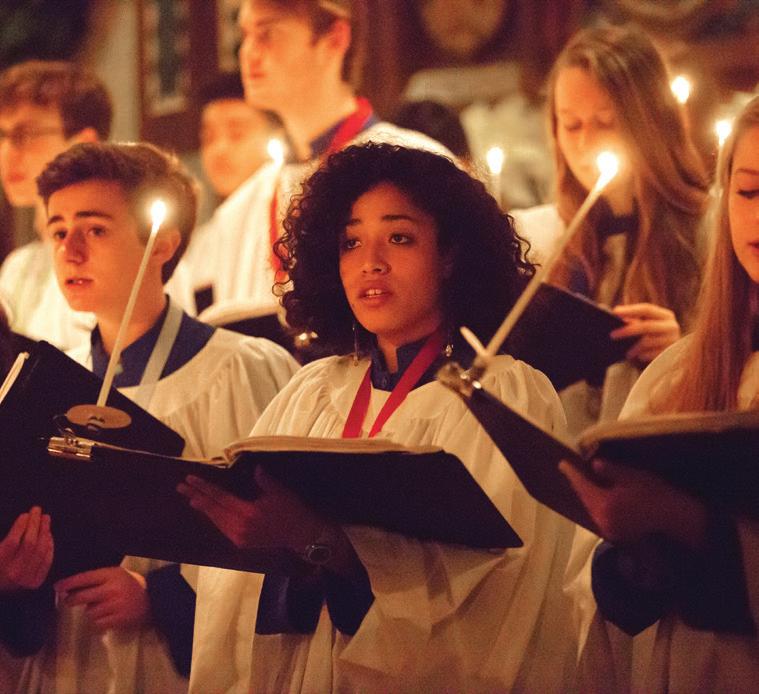
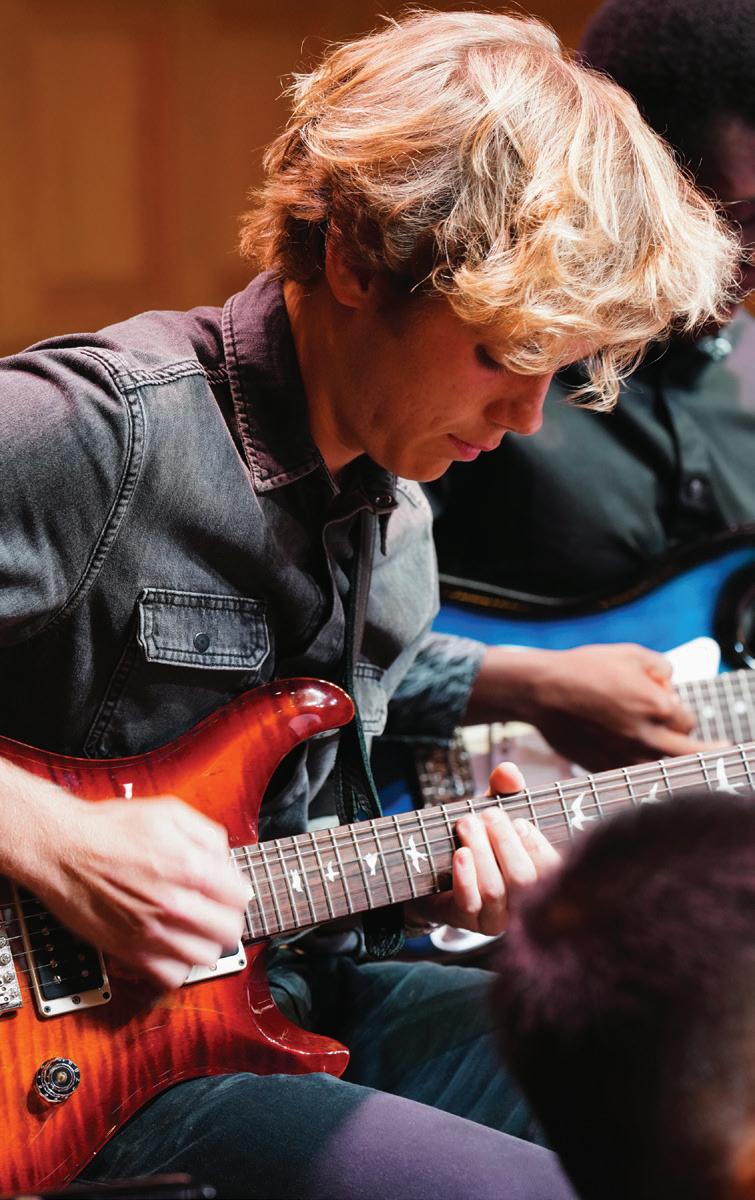


Dance students lead an Adaptive Dance program for local children with special needs.
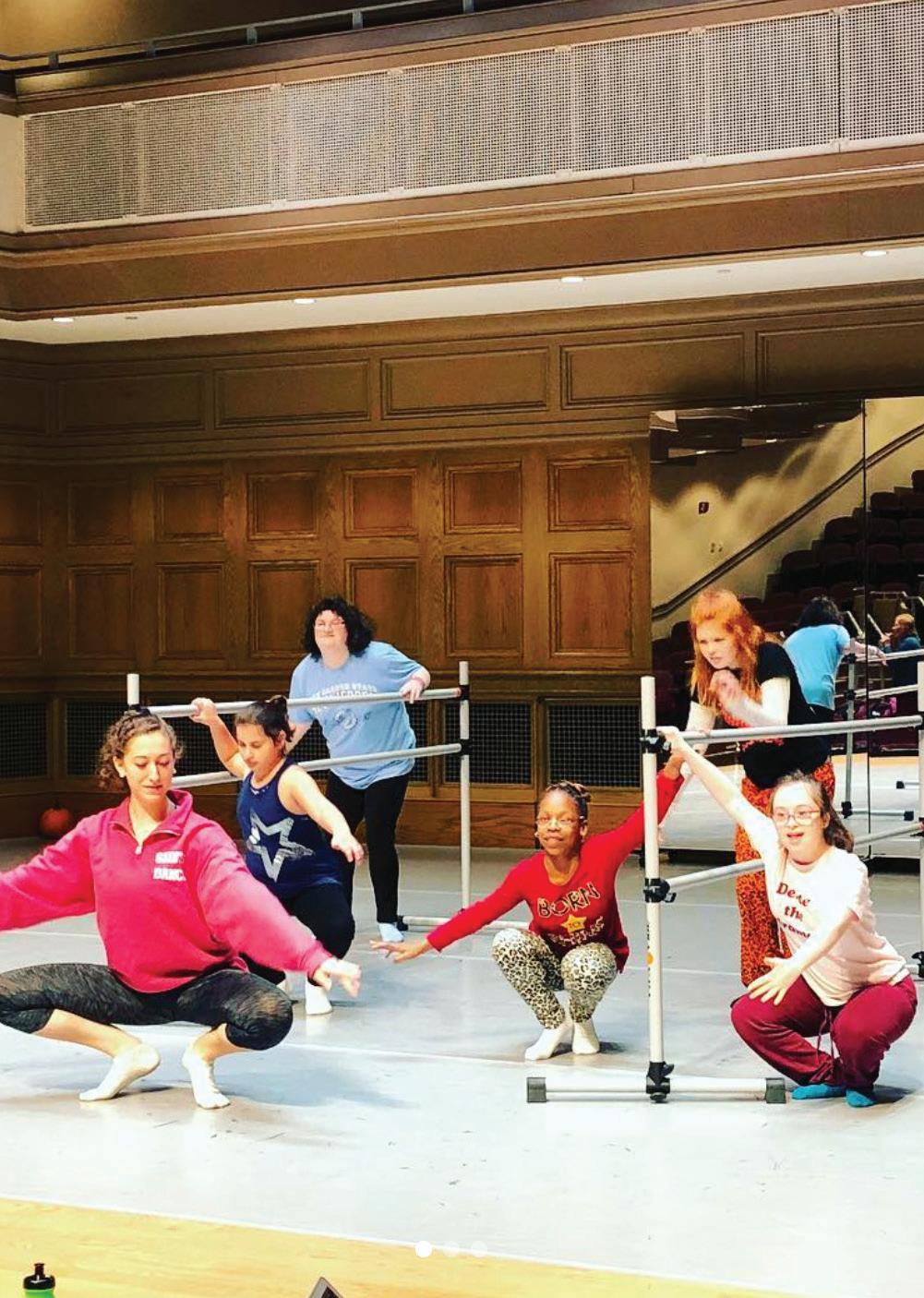
69 FOLLOW US ON INSTAGRAM @life.in.obrien ALL SAS ARTS
STRETCH YOURSELF
“I learned drums one day because my friend showed me how to play a few beats. Now I just mess around on drums by myself. Can’t say I’m any good, but it’s super fun.”

MEET Sophie Mo
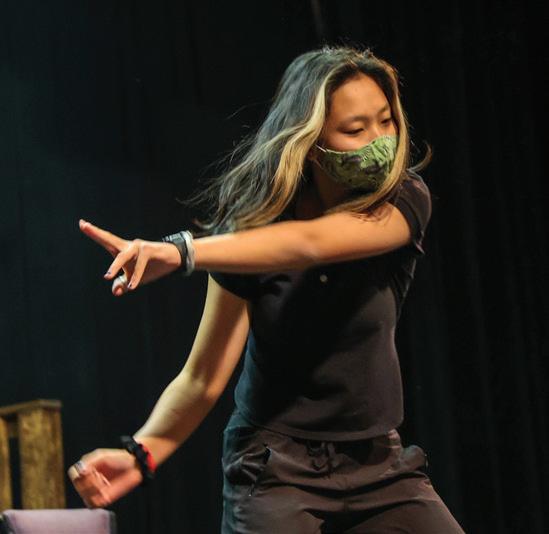
 DANVILLE, CA V FORM STUDENT
DANVILLE, CA V FORM STUDENT
Sophie’s thoughts on...
LIVING ON DORM
I love the freedom of having all your best friends literally living next door to you. At home, I live very far away from all of my friends—like a 20 minute drive away—so we need to plan our hang outs a whole week before. At St. Andrew’s, my friends are five steps away from me. Even if I’m not really close to one of my dormmates, I don’t hesitate to knock on their door when I want to find a buddy for dinner or just to sit on the Front Lawn—everyone is supereager to hang out with one another—and I’m so used to coming back to my room after classes and seeing my friends right before bedtime. When I think about my choice to come to St. Andrew’s, I can’t imagine what going to a day school is even like.
MAKING DISCOVERIES
I was particularly challenged by Dr. J in my Honors Precalculus class— in a good way. The way Dr. J introduces topics and teaches class is like a brain game. I feel as though I am a mathematician using what I know to learn new skills. Dr. J doesn’t just offer you the answers freely, but really asks you to think of different ways to get to an answer. My view used to be that math is strict and firm, with rules and theorems. Dr. J showed me that there are millions of ways to solve any simple or complex problem. Now, instead of being intimidated by hard questions, I am excited to tackle them. After reading a problem, my brain instantly branches towards multiple ideas and paths I can take toward a solution.
WHEN SAS FIRST FELT LIKE HOME
I was eating dinner on the Front Lawn with my friends watching the sunset (cliche, I know). We were all sitting in a huge circle and someone said something like, “It’s getting cold, I’m going to my room to grab a jacket. I’ll be right back.” And something just clicked I realized: we live here. My room is right there. This is my home. I still have a hard time believing it to this day, but we LIVE on this campus. Every morning, I wake up and walk to breakfast and I see that beautiful pond. Isn’t that amazing?
Volleyball Squash Soccer Orchestra
FAVE DINING HALL FOOD
Whenever they have pesto that’s a score. I also really like the penne vodka and the gulab jamun!

71
We live in community with the natural world.
With 2,200 acres to explore, our campus will be your classroom and your playground.
72



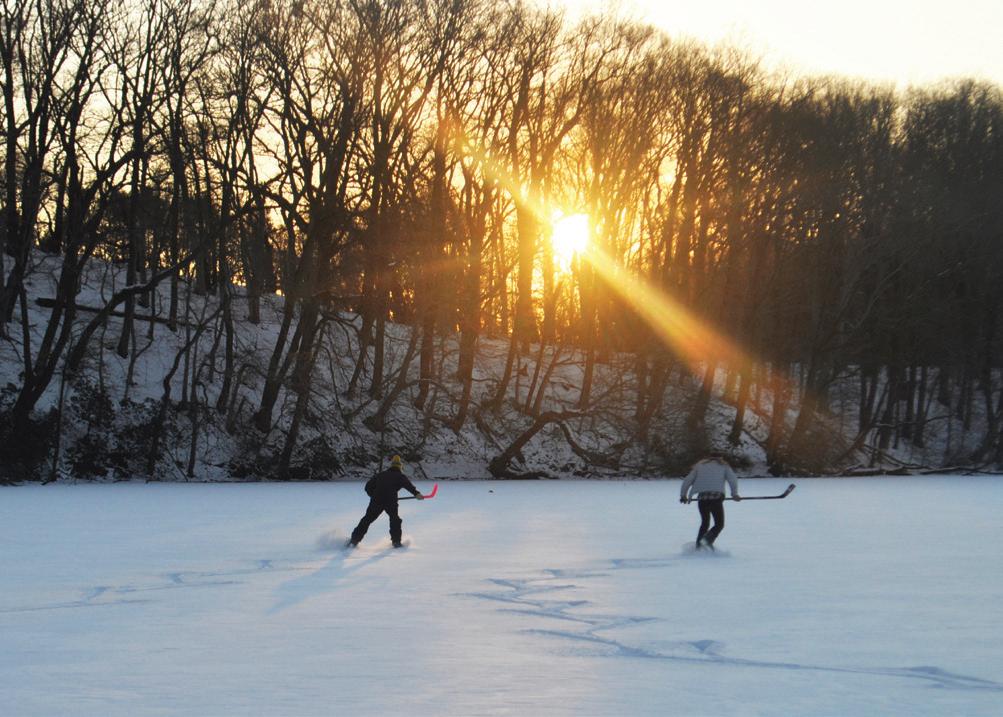

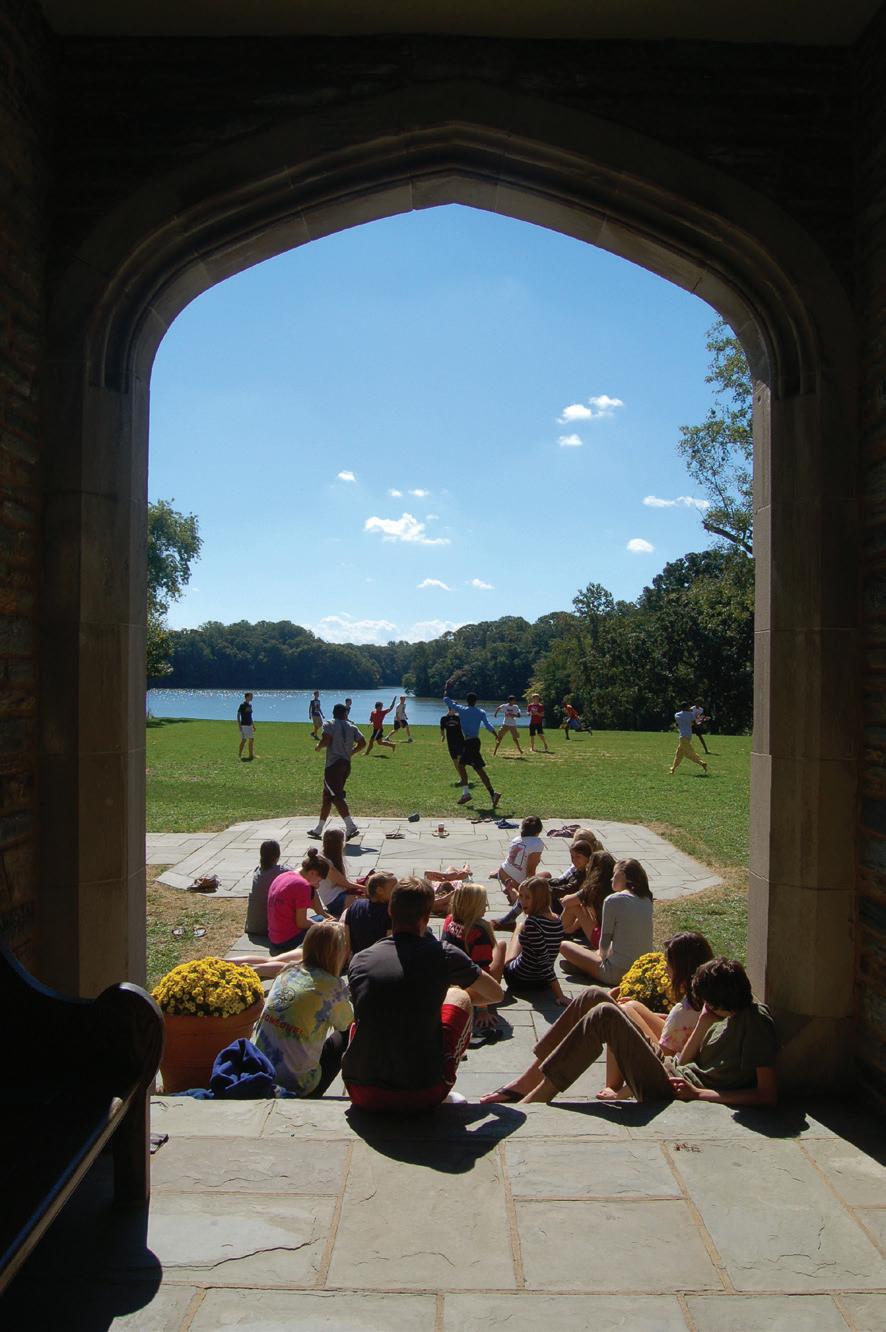

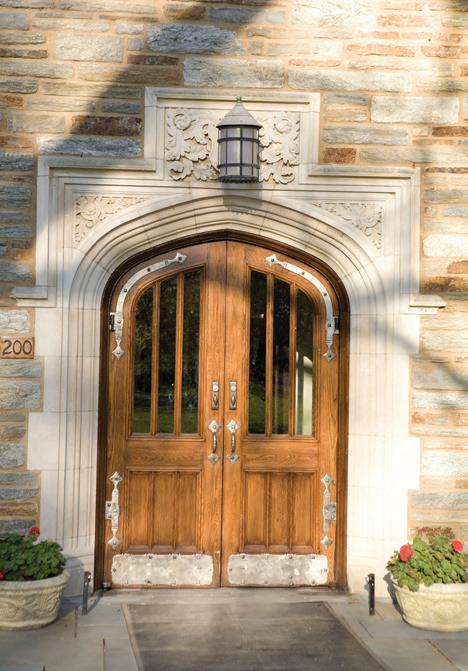

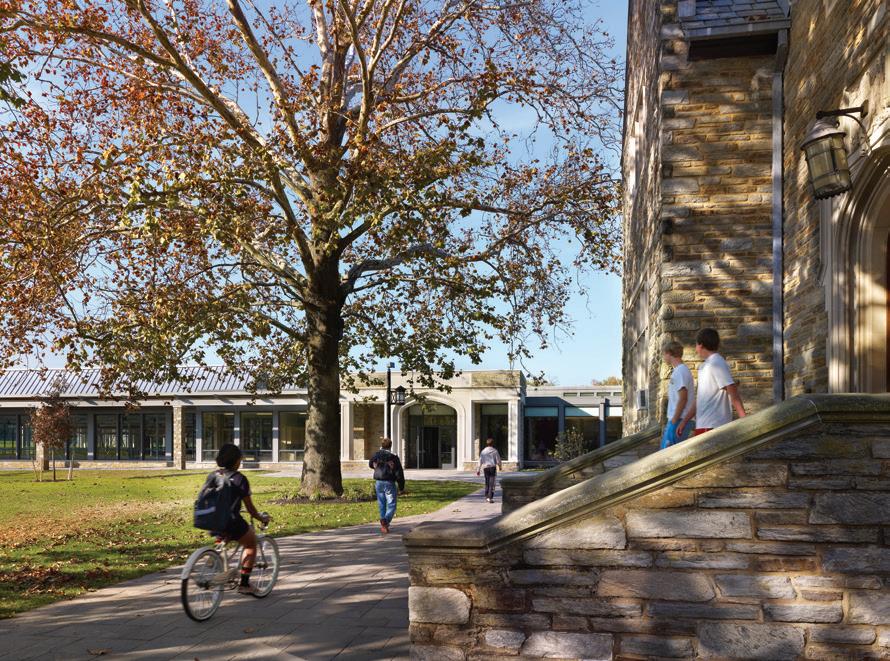
Our Campus
I can’t imagine another school that has natural resources that could rival St. Andrew’s. The campus here is so rich and so vibrant. The pond, the woods, the grasslands, the garden—it’s all an invitation for students to go and explore, and there are so many discoveries just waiting for them. The campus of St. Andrew’s is an absolutely unparalleled environment for teaching.
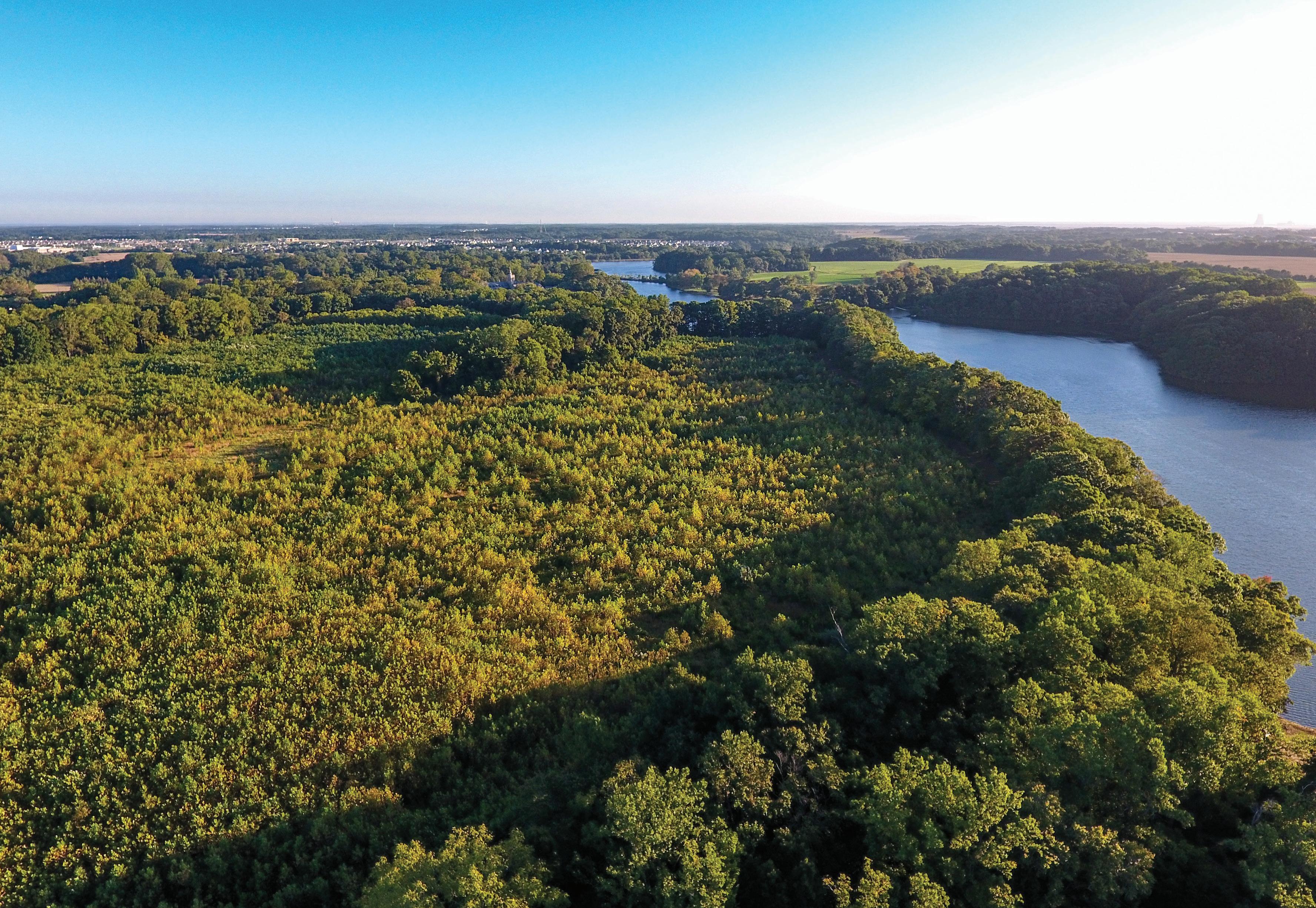 DAN O’CONNELL BIOLOGY TEACHER
DAN O’CONNELL BIOLOGY TEACHER

INFINITE ADVENTURES!
74
FORESTS + FARMLAND + TWO-MILE LONG NOXONTOWN POND + 10 MILES OF TRAILS =
SUSTAINABILITY AT
ST. ANDREW’S
As a community, we are committed to living in harmony with and caring for our 2,200 acres. Students, faculty, and staff work together to steward our land, water, wildlife, and other natural resources, and to contribute to environmental initiatives in the wider world. Sustainability is a consideration in decisions and practices at every level of school life.
RECENT STUDENT-LED SUSTAINABILITY INITIATIVES
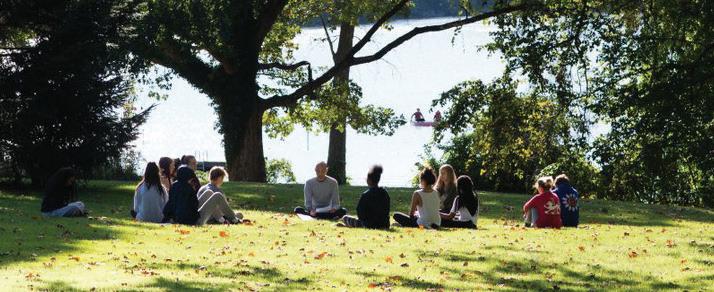
50 kW solar array

Beekeeping Club
Climate action marches in Washington, D.C. & NYC
Composting of Dining Hall waste
On-campus climate action conference
Project Zero (our annual, sustainable campus clean-up effort)

Reforestation of our farmland
Water testing of Noxontown Pond
Potting bulbs and flowers from the organic garden and gifting to local civic organizations
My favorite place at SAS would have to be the woods! From getting lost for four hours with one of my friends freshman year to my daily runs in the winter of junior year, the trails have become my second home and a place where I can relax, decompress, and think through my day.
HELEAH SOULATI ’21 MARYLAND
STRETCH YOURSELF
“The biggest difference in myself since I came to SAS is that I am now willing to walk up to a group of people I don’t really know and start a conversation.”

MEET Ford Chapman
CHARLOTTESVILLE, VA VI FORM STUDENT
Ford’s thoughts on...
FIRST FELT LIKE HOME
I first felt at home at St. Andrew’s on the first night of my freshman year football preseason. I went to the basketball courts with the few other guys in my class and we just sat on the gym floor and talked. The more we got to know each other, the more comfortable we felt
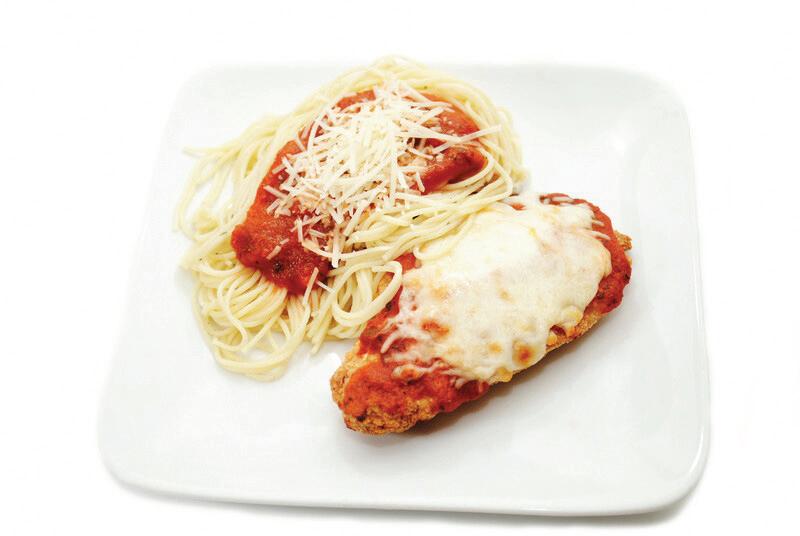
LEARNING TO ASK QUESTIONS
During my history research seminar, most of my conversations with Mr. Edmonds gave me different angles from which I could attack my central research question on the impact of television on anti-Vietnam War sentiment in America. I always walked away from these conversations excited to research and learn more about my subject
WHAT WE DO ON THE WEEKENDS
My favorite weekend activities at SAS are the times when a group of people who usually wouldn’t hang out together decides to play old childhood games. I can remember countless nights when a game of tag with ten friends turned into a massive, campus-wide affair.
DISCOVERING MY CULTURE
The South Asian Affinity Group has provided me with a chance to surround myself with people that know Indian and other South Asian cultures and religious traditions more than I do. My peers in SAAG have brought me closer to my culture through various chapel services, celebrations, and group gatherings.
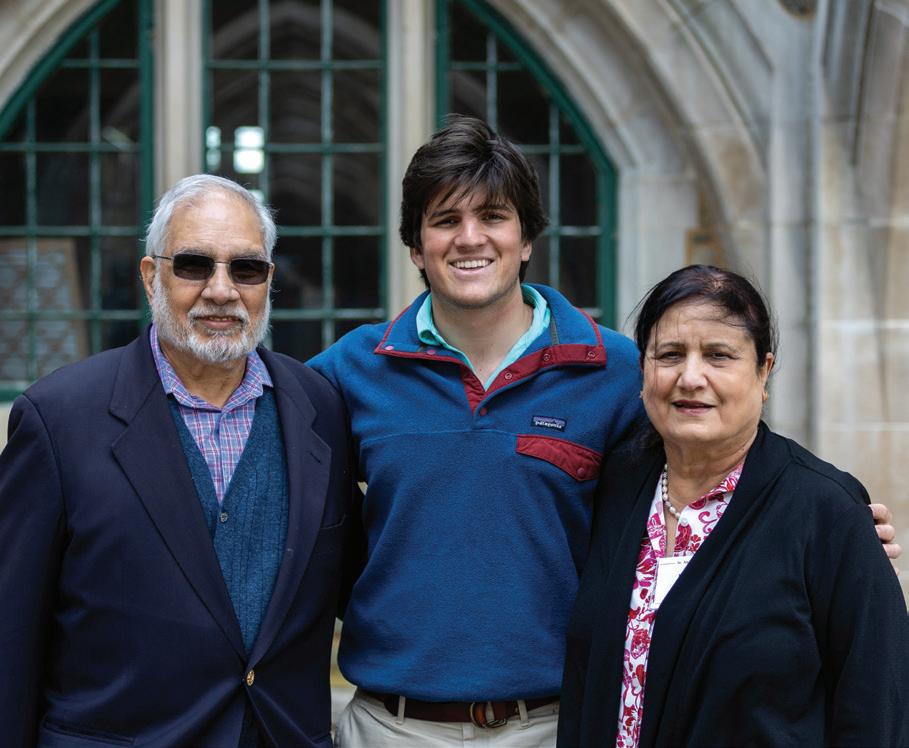

77
School Co-President Baseball Football Student Diversity Committee South Asian Affinity Group
FAVE DINING HALL FOOD Chicken parm—no contest.
We believe you’re ready to take the next step.
Continue your exploration of every facet of St. Andrew’s in greater detail at www.standrews-de.org.
78
And it’s as easy as 1-2-3.
Visit us online! Learn more about St. Andrew’s and the admissions process by visiting standrews-de.org/admission
90 YEARS OF RADICAL FINANCIAL AID
Come to SAS for a tour and interview! We are open for on-campus tours and in-person interviews. If you can’t travel to campus, you can opt to take a private, guided video tour of St. Andrew’s with a student ambassador, followed by an interview with a member of the Admission team, all offered virtually. Call 302-285-4231 to schedule your visit today!
If you are interested in St. Andrew’s, but you are unsure of your family’s ability to pay our full tuition, we encourage you to apply for financial aid. St. Andrew’s provides grants for 100% of a family’s demonstrated need and is committed to being affordable and accessible to all students, regardless of your family’s financial circumstances.
We are one of a handful of boarding schools nationally that guarantees to meet 100% of the financial need of any accepted student.
Do you offer merit scholarships as well as need-based financial aid?
Apply for admission! Prepare and submit your application, transcripts, recommendation letters, and test scores by visiting standrews-de. org/apply. Applications are due January 15.
Keep in touch!
Please don’t hesitate to contact us throughout the admissions process with any questions, concerns, or updated information. You can reach us at 302-285-4231 or admissions@standrews-de.org
We do not offer merit scholarships. We believe that every student we admit to St. Andrew’s is meritorious. Rather than leveraging scholarships as incentives, we use financial aid to open doors of opportunity for our families. All financial aid awards meet 100% of demonstrated need.
How many students receive financial aid each year?
In 2022-23, 37% of the student body received financial aid. The average grant was approximately $49,301, or 76% of tuition.
How do I apply for financial aid at St. Andrew’s?
Visit standrews-de.org/accessibility to learn more about how financial aid works at St. Andrew’s and to begin your application.
79
1 2 3 KEEP UP WITH ST. ANDREW’S IN REAL TIME @sasdelaware
Our Location
We are located in the mid-Atlantic region, one hour south of Philadelphia, between Washington, D.C., and New York City. Our location allows us to enjoy the rich natural resources of Delaware, plus the cultural and educational opportunities available in our state and surrounding cities.

PENNSYLVANIA
Wilmington
Philadelphia
New York City
St. Andrew’s
NEW JERSEY
MARYLAND
Baltimore Annapolis Washington, D.C.
Mileage to St. Andrew’s School
CITY MILES DRIVING TIME
Annapolis 65 1 ¼ hrs.
Baltimore 70 1 ½ hrs.
New York City 145 2 ½ hrs.
Philadelphia 60 1 ¼ hrs.
Philadelphia Airport 50 50 min.
Rehoboth Beach 65 1 ¼ hrs.
Washington, D.C. 97 2 hrs.
Wilmington 30 35 min.
Dover
DELAWARE
STUDENT BODY
FACTS
III FORMERS 75 IV FORMERS 85 V FORMERS 81 VI FORMERS 78
STUDENTS OF COLOR 42%
GEOGRAPHIC DIVERSITY STATES 28 COUNTRIES 13 INTERNATIONAL STUDENTS 13.6%
FACULTY FACULTY 76
% WITH ADVANCED DEGREES 72% STUDENT-TEACHER RATIO 5:1 AVERAGE CLASS SIZE 10
FINANCIAL AID
TUITION $64,150 TOTAL FINANCIAL AID GRANTED $5,732,991 % OF STUDENT BODY 37% AVERAGE GRANT $49,301 100% of demonstrated financial need met for all accepted students
QUICK
2022-2023 319 STUDENTS, 100% BOARDING
Rehoboth Beach
Founders Hall
1 College Counseling, Registrar (ground floor)
Reception, Head of School, Admission (1st floor)
Hillier Corridor (2nd floor)
2 School Store (ground floor) Business Office (1st floor)
Hillier and Fleming Corridors (2nd floor)
3 Main Common Room, Dining Hall (1st floor)
Sherwood Corridor (2nd floor)
Schmolze Corridor (3rd floor)
4 A. Felix duPont Jr. Chapel (ground floor)
Classical Languages, History, Religious Studies (1st floor)
Sherwood Corridor (2nd floor) Schmolze Corridor (3rd floor)
5 Forbes Theater (ground floor)
Modern Languages (1st floor) Baum Corridor (2nd floor)
Voorhees Corridor (3rd floor)
6 Irene duPont Library Other Facilities 8 Pell Hall
Moss Hall 10 Moss Annex 11 Alumni Hall: Advancement Office 12 Edith Pell Student Center
14 Amos Hall: English, Science Labs, Amos Lecture Hall (1st floor)
Science Labs, Math (2nd floor) 15 Miller Health Center 16 Mein Hall 17 Gaul East 18 Gaul West 19 O’Brien Arts Center: Engelhard Performance Hall, Warner Art Gallery, Photography Studios, Music Rehearsal Rooms, Tawes Music Library, Painting, Drawing, Ceramics and Dance Studios
Kip duPont Boat House
Athletic Center: International Squash Courts, Competition
Basketball Court, Wrestling Arena, Cameron Room 21 Sipprelle Field House: Basketball Courts, Fitness Center, Trainer’s Office, Locker Rooms
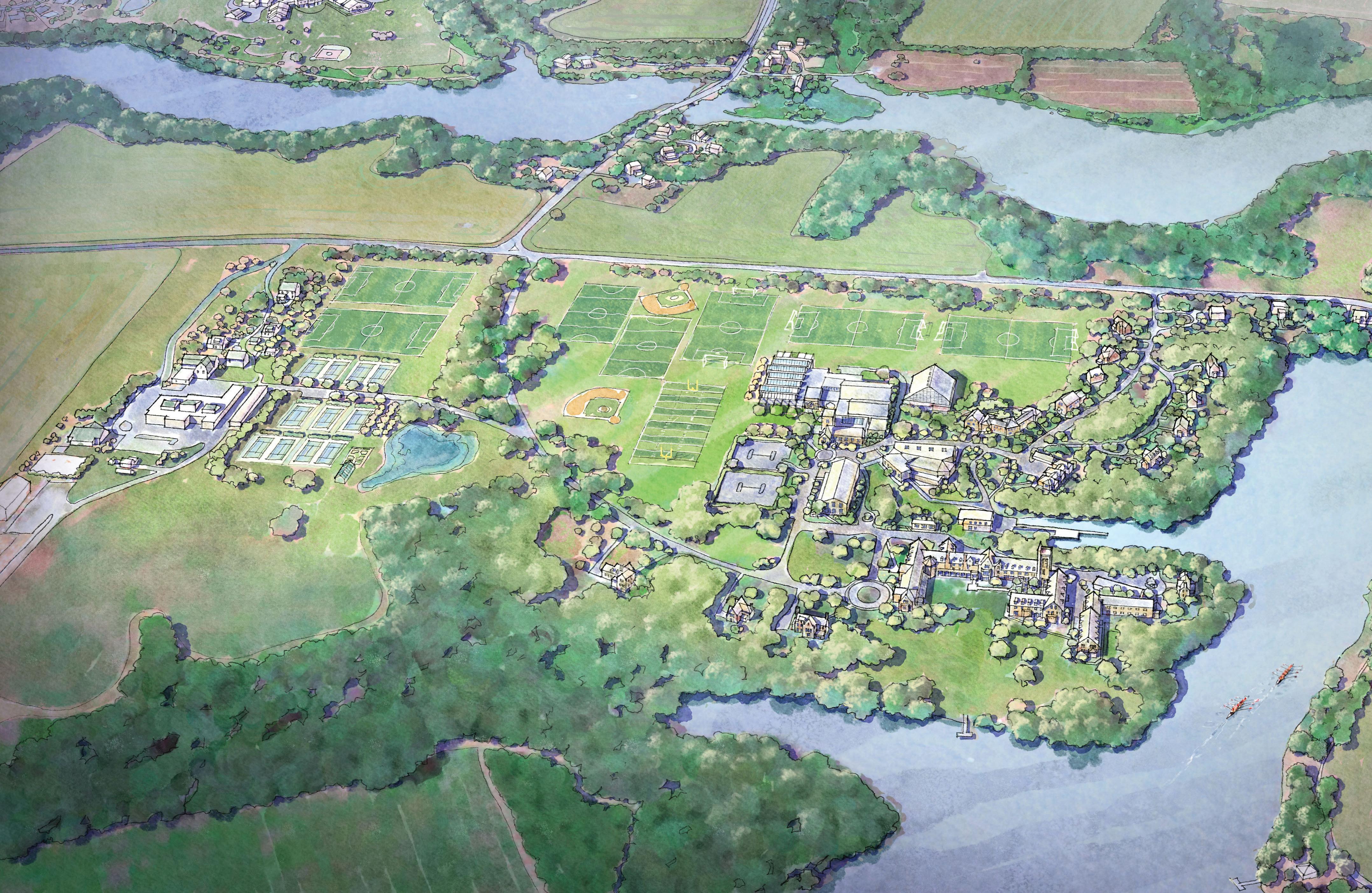
Genereaux Aquatic Center
School’s House
F F F F F 25 24 F 23 F F H 1 2 3 4 5 6 7 8 9 10 F 13 26 14 20 11 21 19 22 18 F 17 16 F F F F F F F F F 15 F F
9
7
13
24 Organic Garden 25 Facilities Services Building: Campus Plant Offices and Facilities Services, Deliveries 26 Rodney Point Pavilion Sports Facilities
T-Dock
20
F
22
23 Paddle Tennis Courts Residences F Faculty Houses H Head of
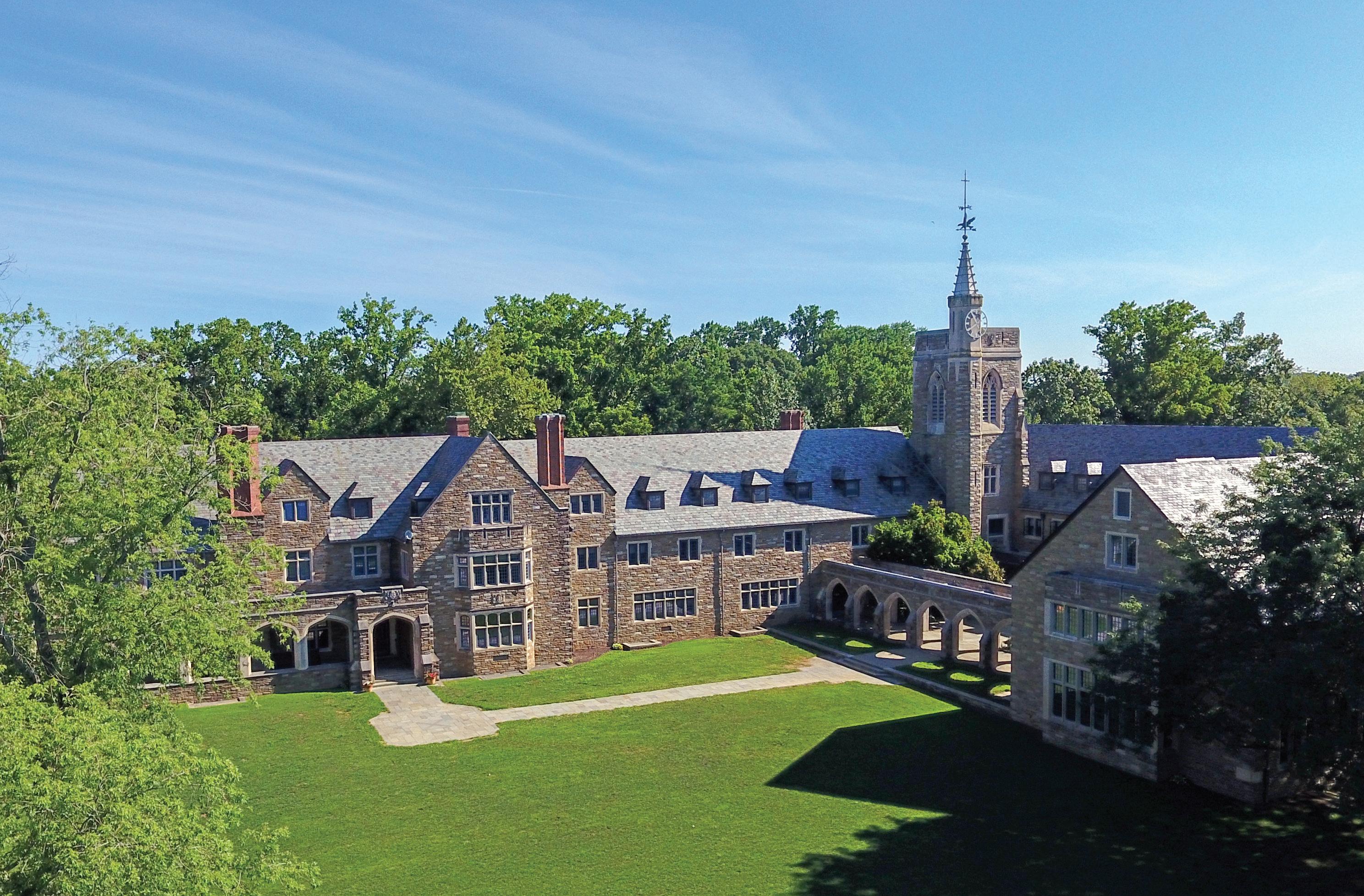



 T. Roach, Jr. Head of School
Joy McGrath
Daniel
T. Roach, Jr. Head of School
Joy McGrath
Daniel




 — Marvi Ali ’21 PENNSYLVANIA
— Marvi Ali ’21 PENNSYLVANIA





 Gianna Rosario ’21 ILLINOIS
Gianna Rosario ’21 ILLINOIS

 Pati Lunsford ’22 VIRGINIA
Pati Lunsford ’22 VIRGINIA







































































































 CUNNINGHAM DIRECTOR OF ATHLETICS
NEIL
CUNNINGHAM DIRECTOR OF ATHLETICS
NEIL















































 RHETT EDENS ’21 NORTH CAROLINA
RHETT EDENS ’21 NORTH CAROLINA










 DANVILLE, CA V FORM STUDENT
DANVILLE, CA V FORM STUDENT











 DAN O’CONNELL BIOLOGY TEACHER
DAN O’CONNELL BIOLOGY TEACHER










